Last updated: 12th February 2024
We hopped over to Northern Ireland for a long weekend in Belfast. In this post we’ll share our 3 day Belfast itinerary covering the city’s sights, history and Game of Thrones locations. It’s a great destination for city break, we loved our long weekend in Belfast because it surprised us, for some reason we didn’t expect such a friendly city, everyone we met was really chatty and welcoming.
Table of Contents
About Belfast
Belfast is the capital city of Northern Ireland. A port city with a strong maritime and shipbuilding heritage. Here you can see the world’s largest museum dedicated to RMS Titantic – located at the same site where the doomed ship was built. Today Belfast is thankfully a peaceful city after 30 years of conflict and violence called ‘The Troubles’. It ran from the mid 1960s until 1998 when the Good Friday Agreement brought peace. More on that later with a black taxi tour we took which is the best way to learn of the past. Belfast is also the perfect city for a getaway to the Giants Causeway located in the North of the country and for exploring the many Game of Thrones filming locations in Belfast and across Northern Ireland.
Samson and Goliath – the twin shipbuilding gantry cranes are a landmark and icon of Belfast
Day 1 – Belfast Itinerary
The Crown Liquor Saloon
After an early morning flight, start your first day in Belfast at the Crown Liquor Saloon for lunch or a drink. It’s an historic pub with a fabulous ornate Victorian exterior and interior, it continues to be one of Belfast’s treasures since it opened in 1826. The saloon was built by Italian craftsmen working in the shipyards and churches of Belfast in the 1800s. It really does feel like stepping back in time with all the original features like gas lamps and the granite bar. Garth loved the design of the ceramic tiles, intricate wood-carved ceilings, and the Italian stained glass windows. Phil loved the atmosphere and the traditional drinking snugs. We were lucky and bagged a cozy mahogany booth just to the left of the ornate bar. The booths were designed to allow ladies and high society a space to drink without being overlooked.
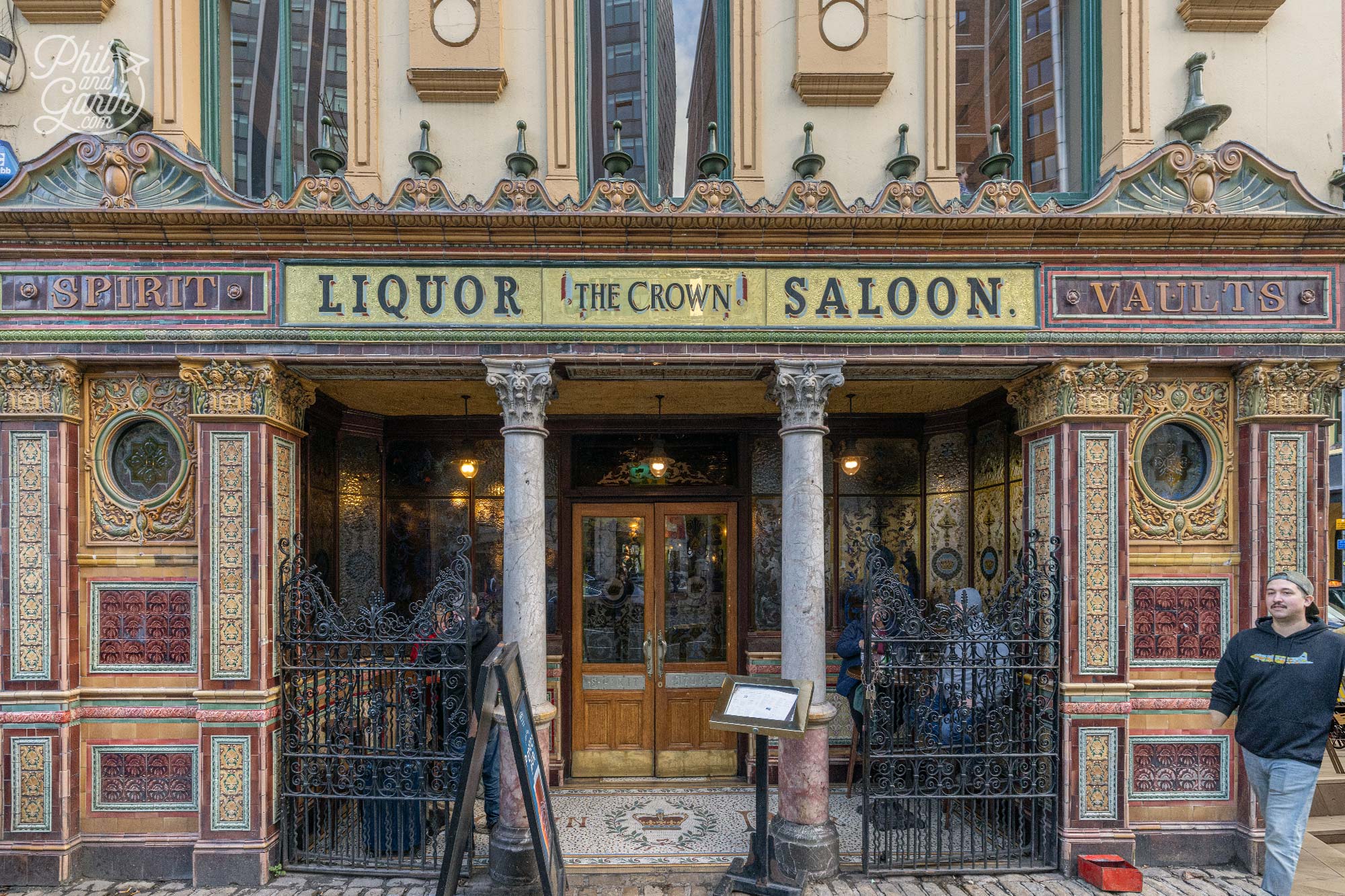
The beautiful and historic Crown Liquor Saloon, Belfast
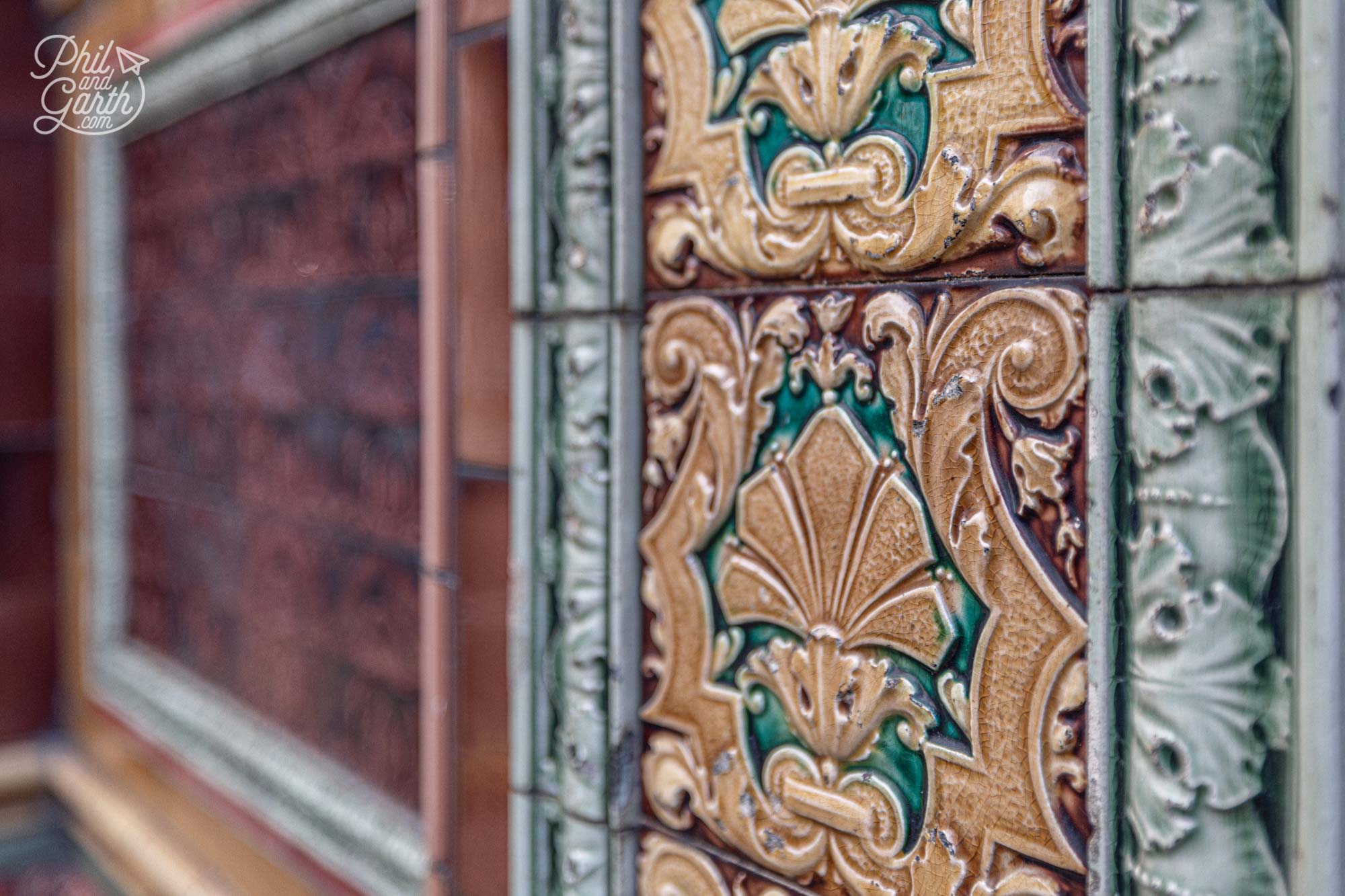
Exterior tile details
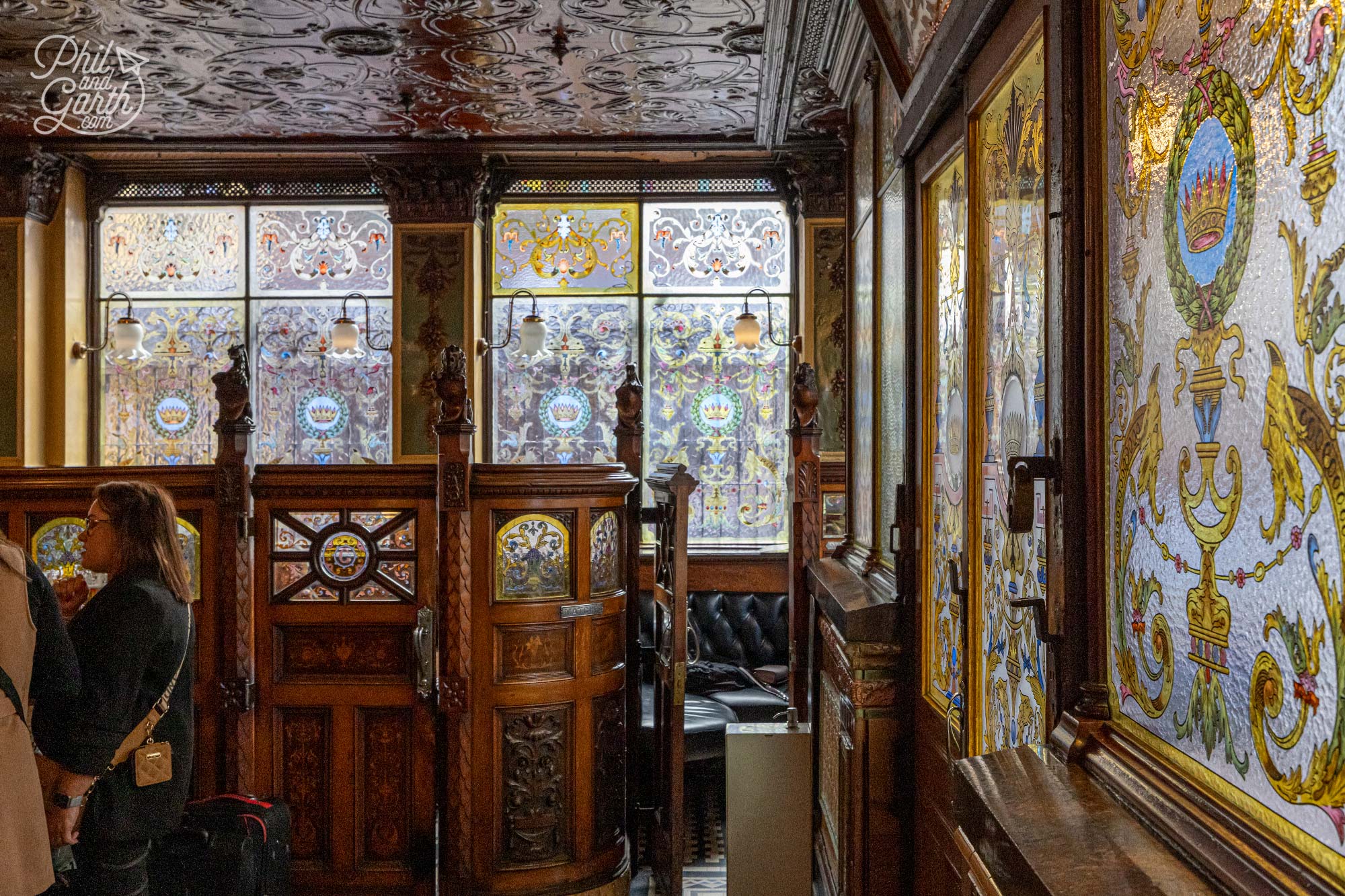
The ornate Victorian interior
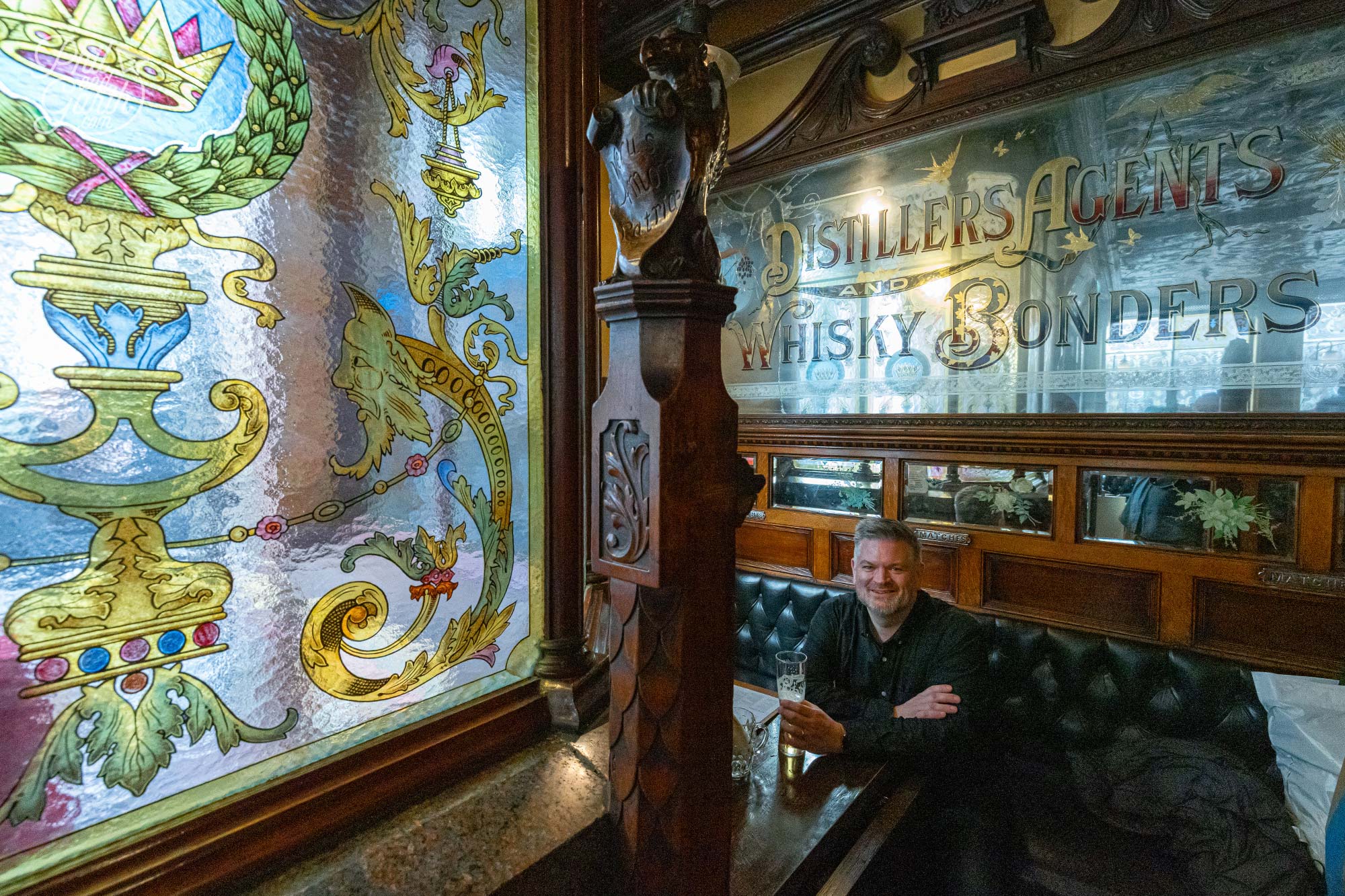
Phil enjoying a drink inside one of the cozy booths
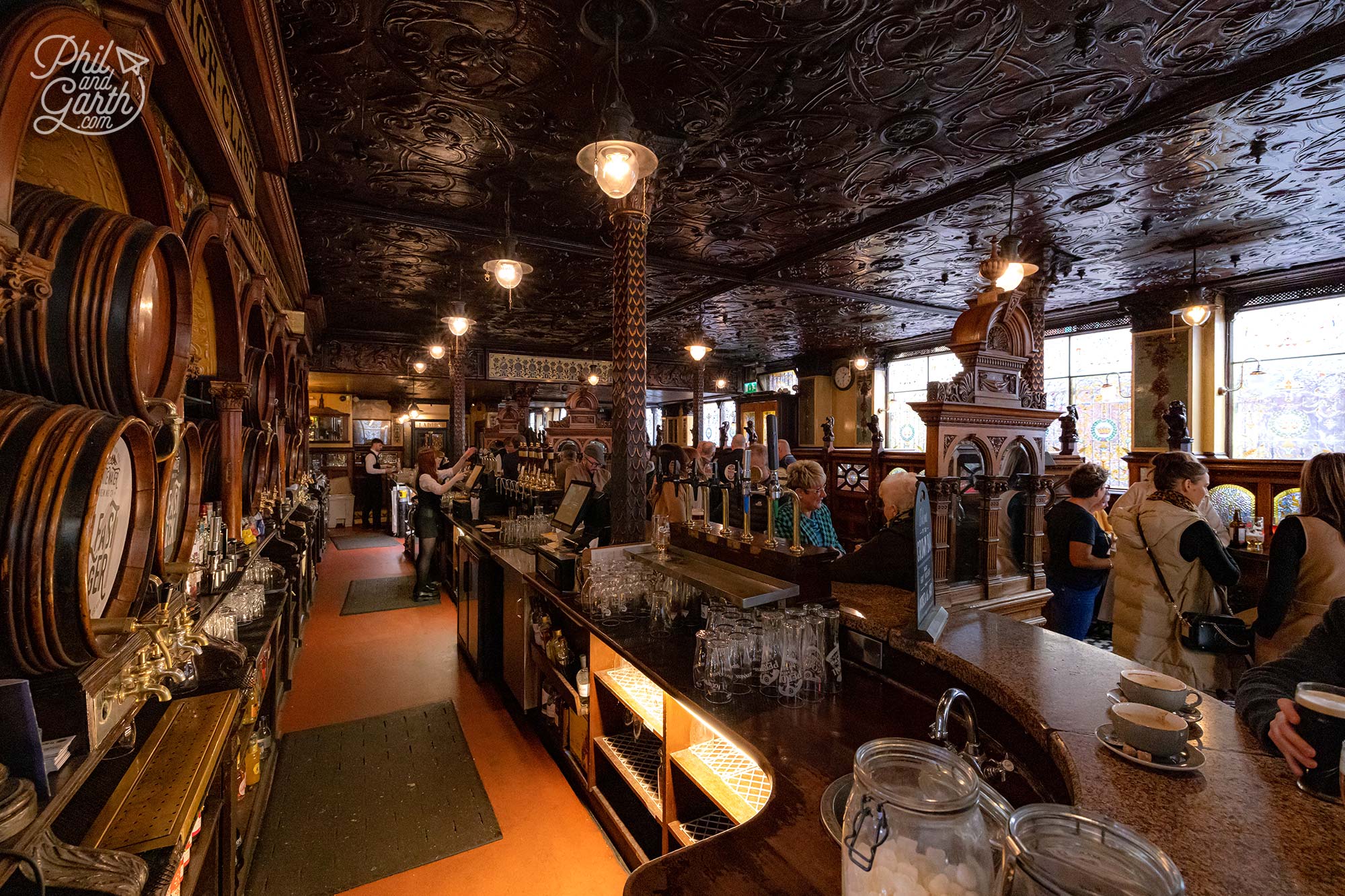
Built by Italian craftsmen working in the shipyards and churches of Belfast in the 1800s
The food is traditional pub grub and not too expensive either. Phil ordered the chicken and portobello mushroom pie and Garth had the sausage and champ, total £25.50. We were told it gets really busy here, but wasn’t too bad around 12 noon.
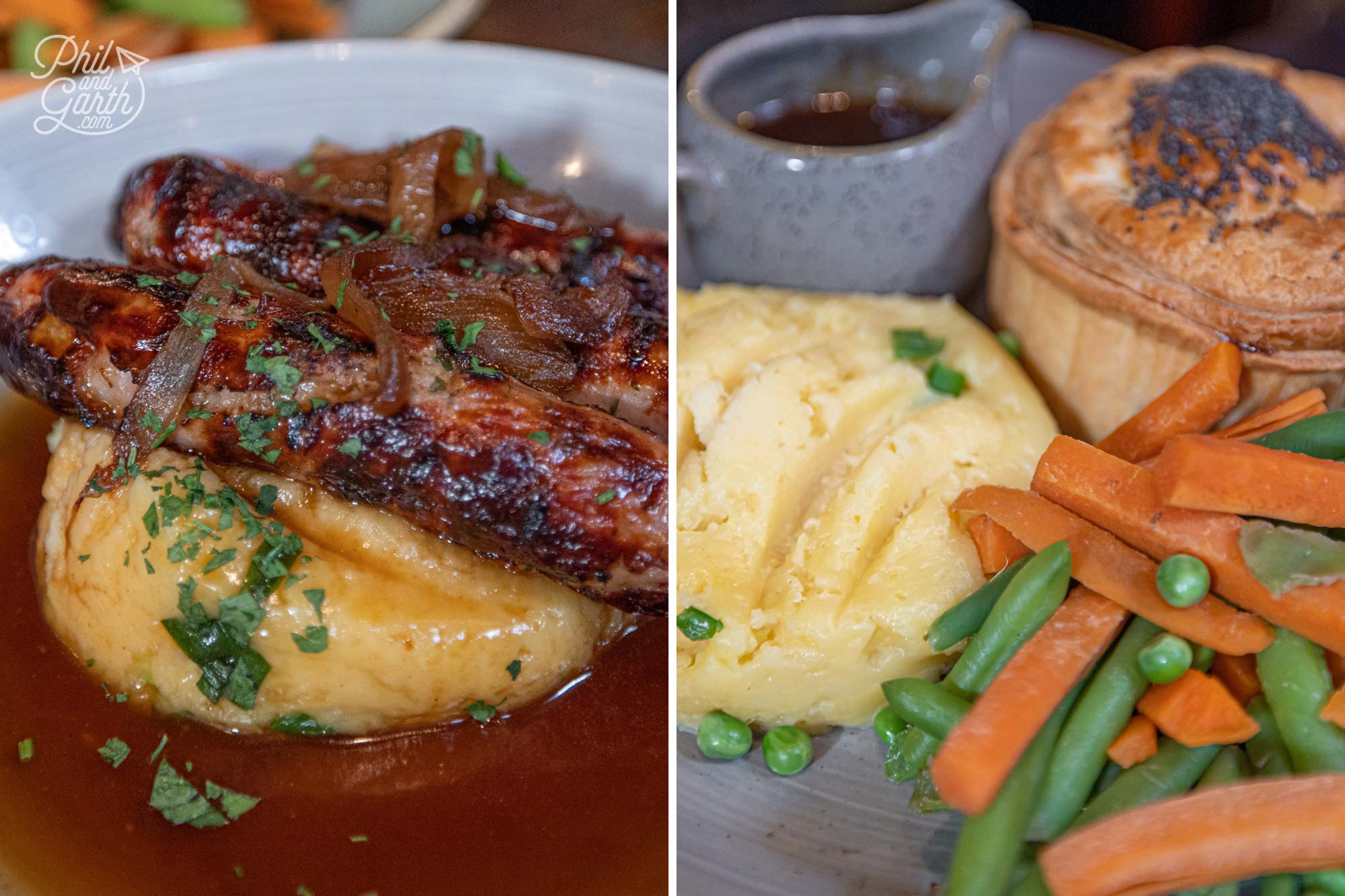
The Crown serves traditional pub food
St George’s Market
After some lunch walk down to St George’s Market on May Street (which takes 15 minutes) for some dessert. It’s an old Victorian market built in 1890 with around 250 stalls selling lots of food, antiques, and crafts. It’s only open at the weekend from Friday to Sunday, so it’s perfect for a weekend city break in Belfast. It was originally an open-air market with a slaughterhouse and a meat market. It was also used as a mortuary during World War Two.
We loved the busy atmosphere and all the choices on offer, it felt like an authentic taste of Belfast life being amongst all the friendly locals. The most popular trader was easily the Belfast Bap Co. the queue was huge! In case you’re wondering a Belfast Bap is a hearty breakfast filled with sausage, egg, and bacon. They also sell Irish soda bread and champ potato bread.
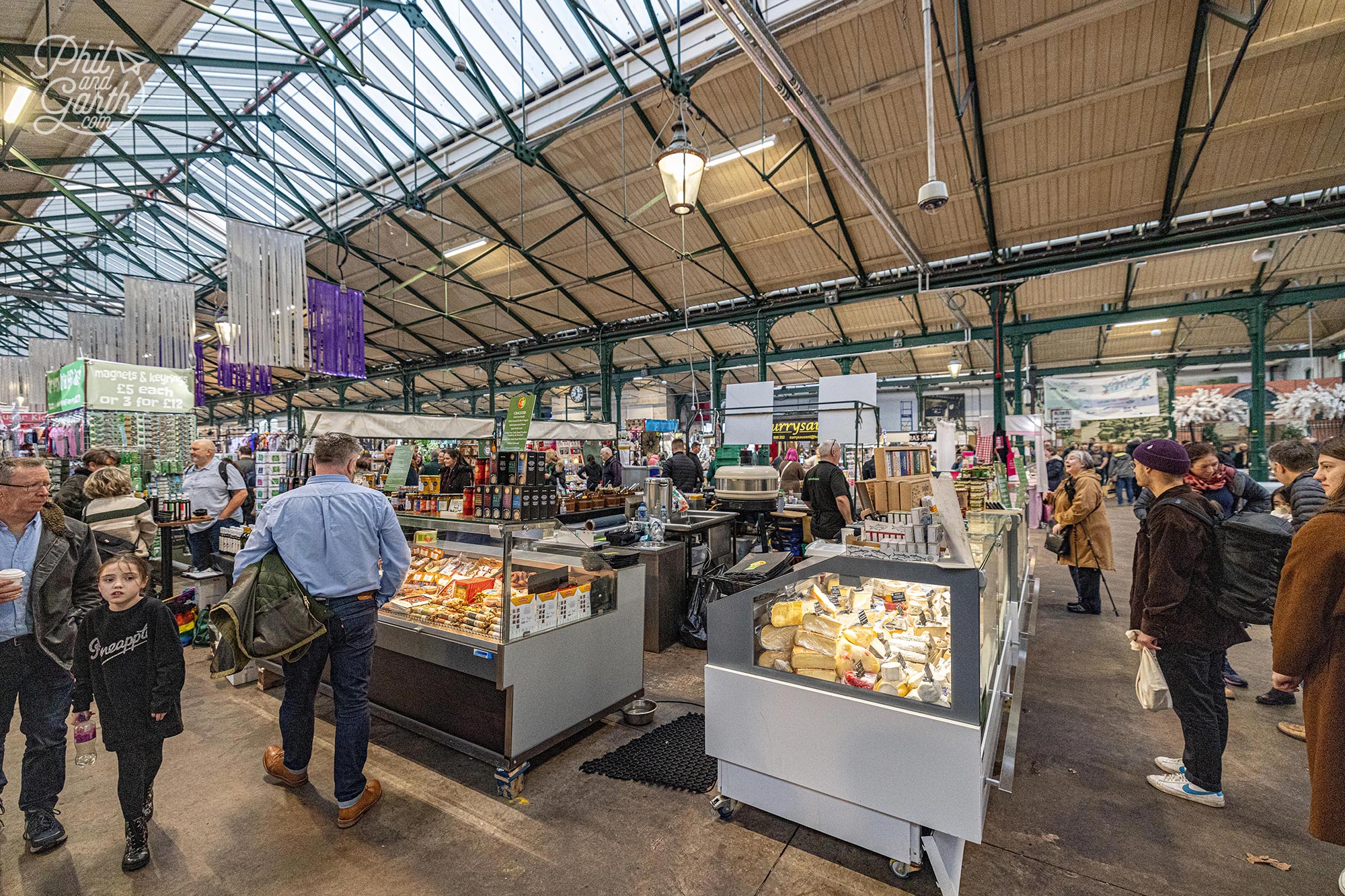
St George’s Market – huge variety of stalls selling crafts, food and antiques all in one place
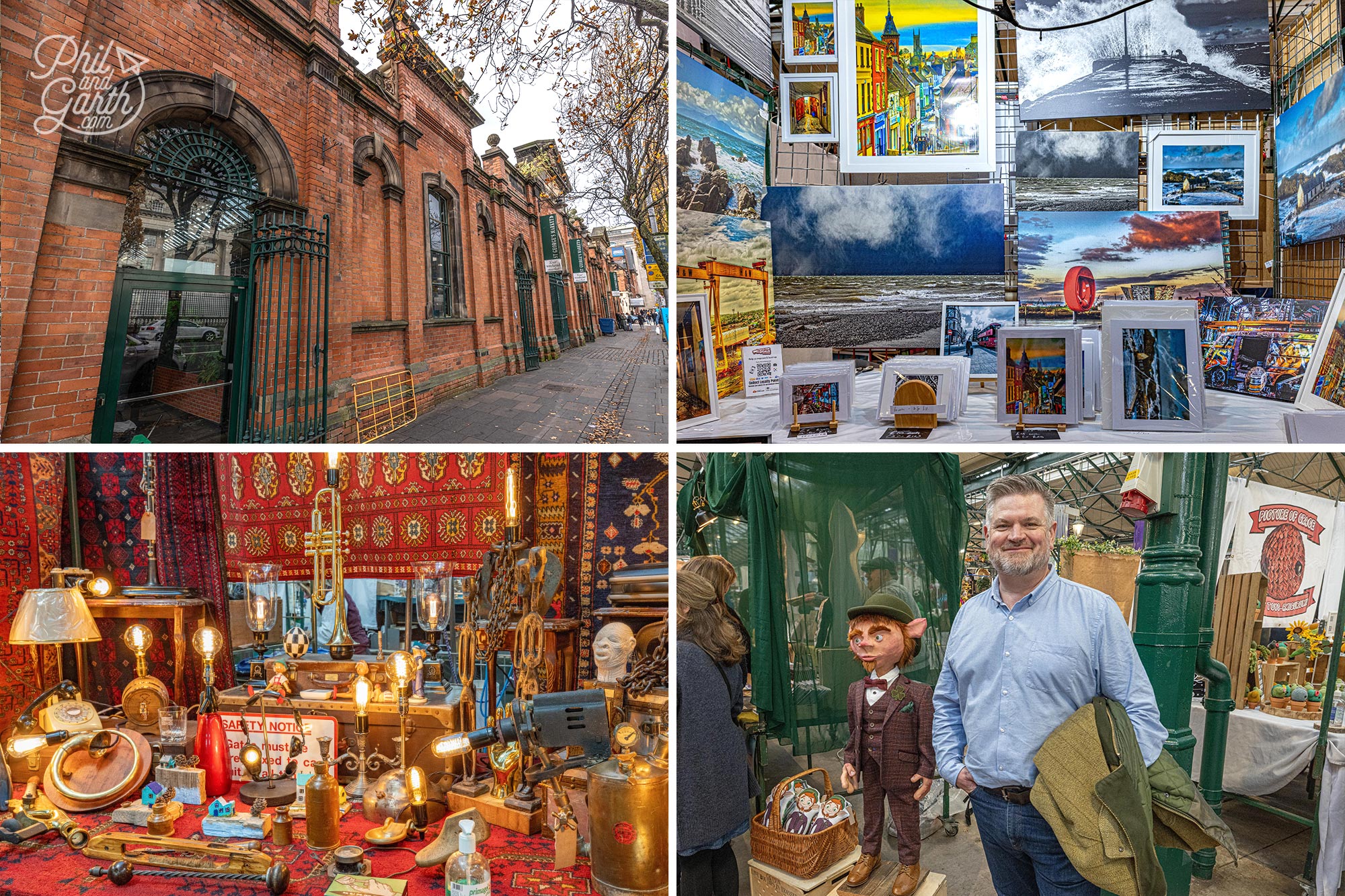
St George’s Market is only open at weekends
Titanic Belfast Museum
In the afternoon head over to the Titanic Quarter of Belfast to visit the Titanic Belfast Museum. This state-of-the-art visitor attraction tells the story of Titanic from its construction and its launch to her tragic ending. It far exceeded our expectations and we can tell you high tech museum is the must-see attraction of Belfast, we highly recommend visiting.
The museum is located on the site of the original Harland & Wolff shipyard. RMS Titanic and her sister ship, RMS Olympic were built and launched from here. Titanic Belfast’s glittering building exterior is shaped like four ship bows and mirrors the height of Titanic.
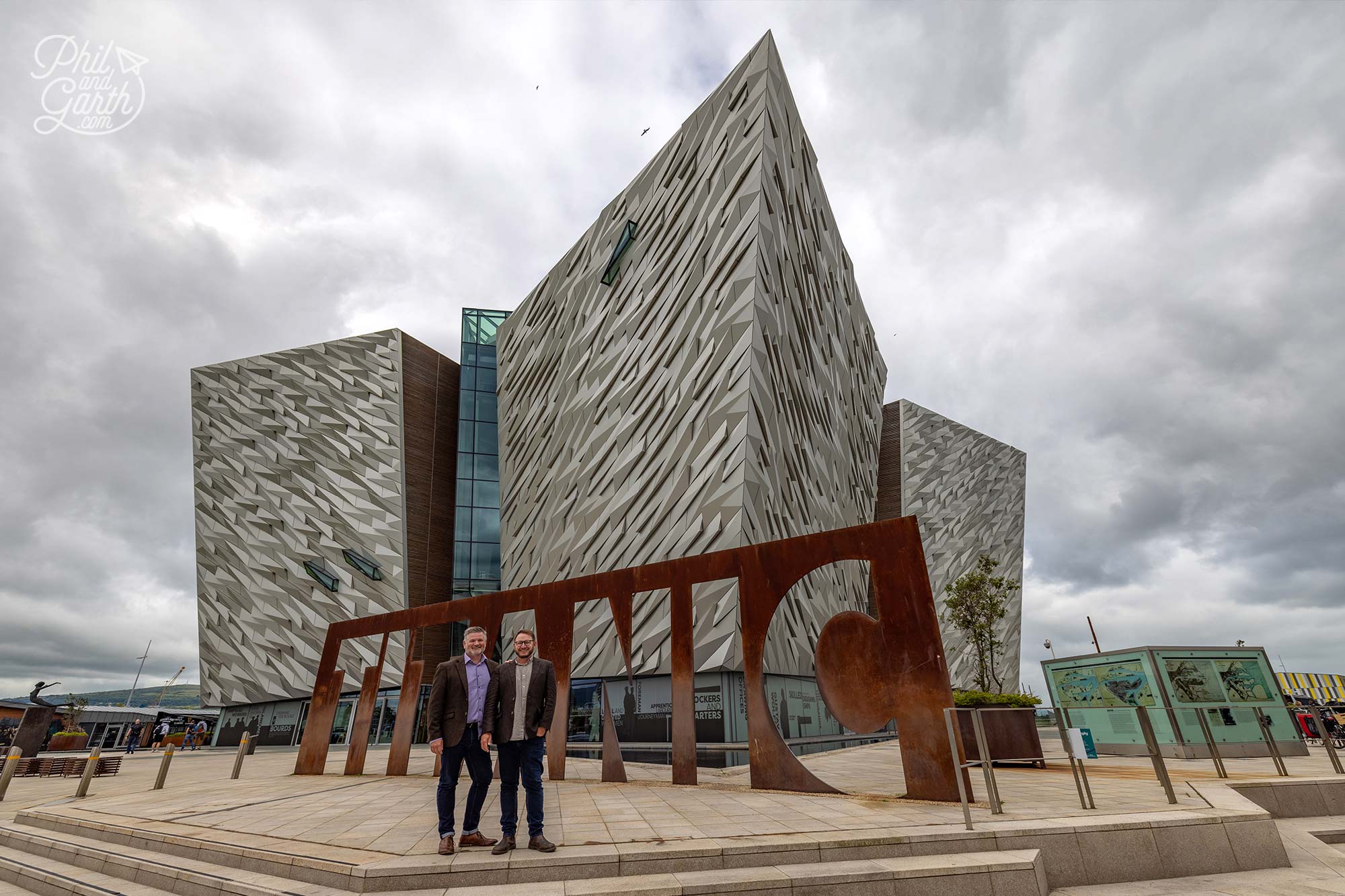
Phil and Garth outside the Titanic Belfast Museum
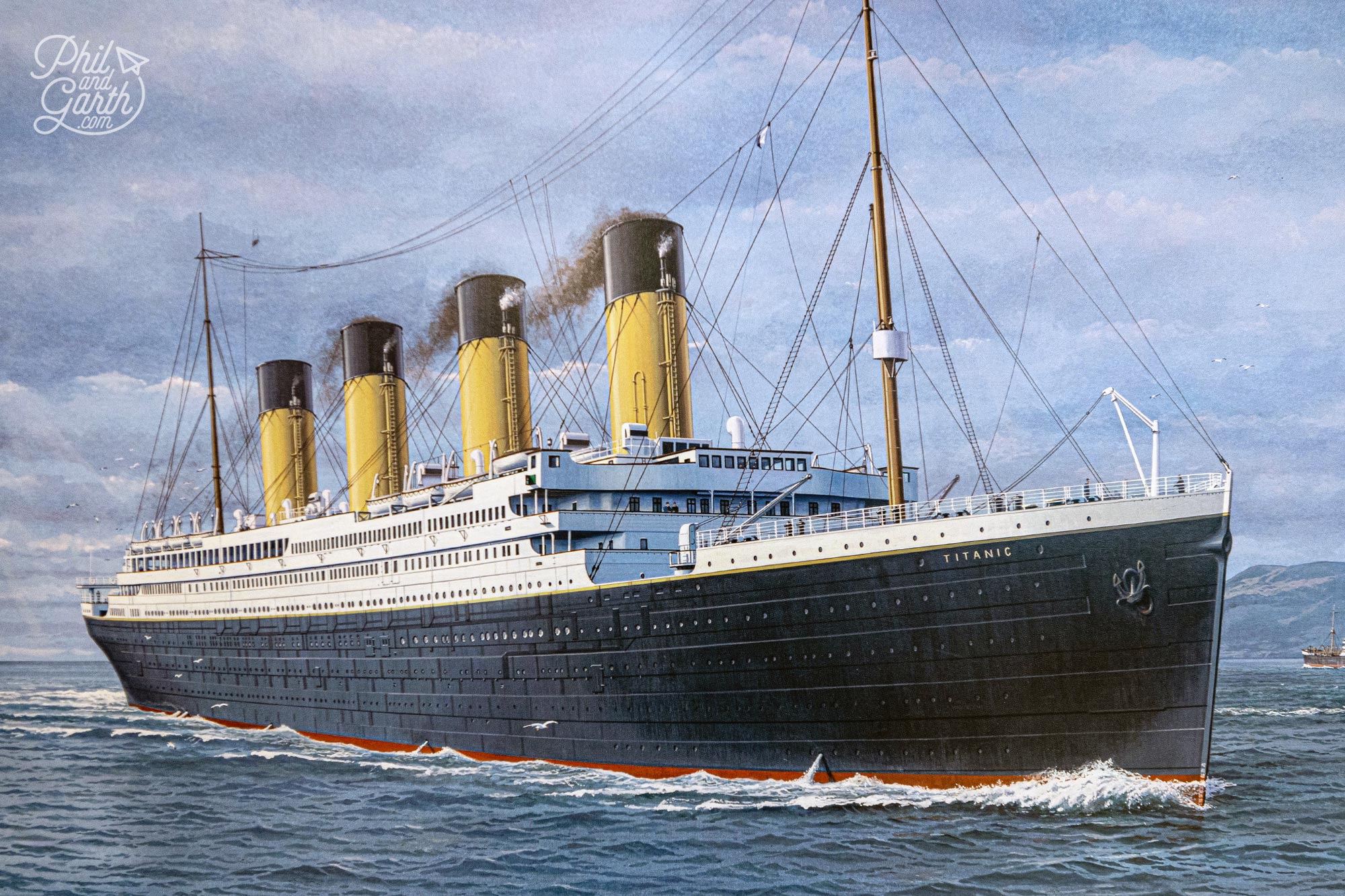
RMS Titanic operated by the White Star Line. It sank on its maiden voyage on 15 April 1912 after striking an iceberg
Inside are 9 exhibition galleries over 6 floors. The self-guided journey of Titanic starts with stories of the ship’s designers and builders who crafted her over 3 years. Then it’s time for a ride! – The Shipyard Ride, which is brilliant and recreates the harsh reality of the shipyard during construction. There are even furnaces where you can actually feel the heat! This dark ride finishes passing a full-scale replica of Titanic’s rudder. The only issue was the images and sounds were a bit out of sync so a little difficult to hear and watch the scenes, but still really good.
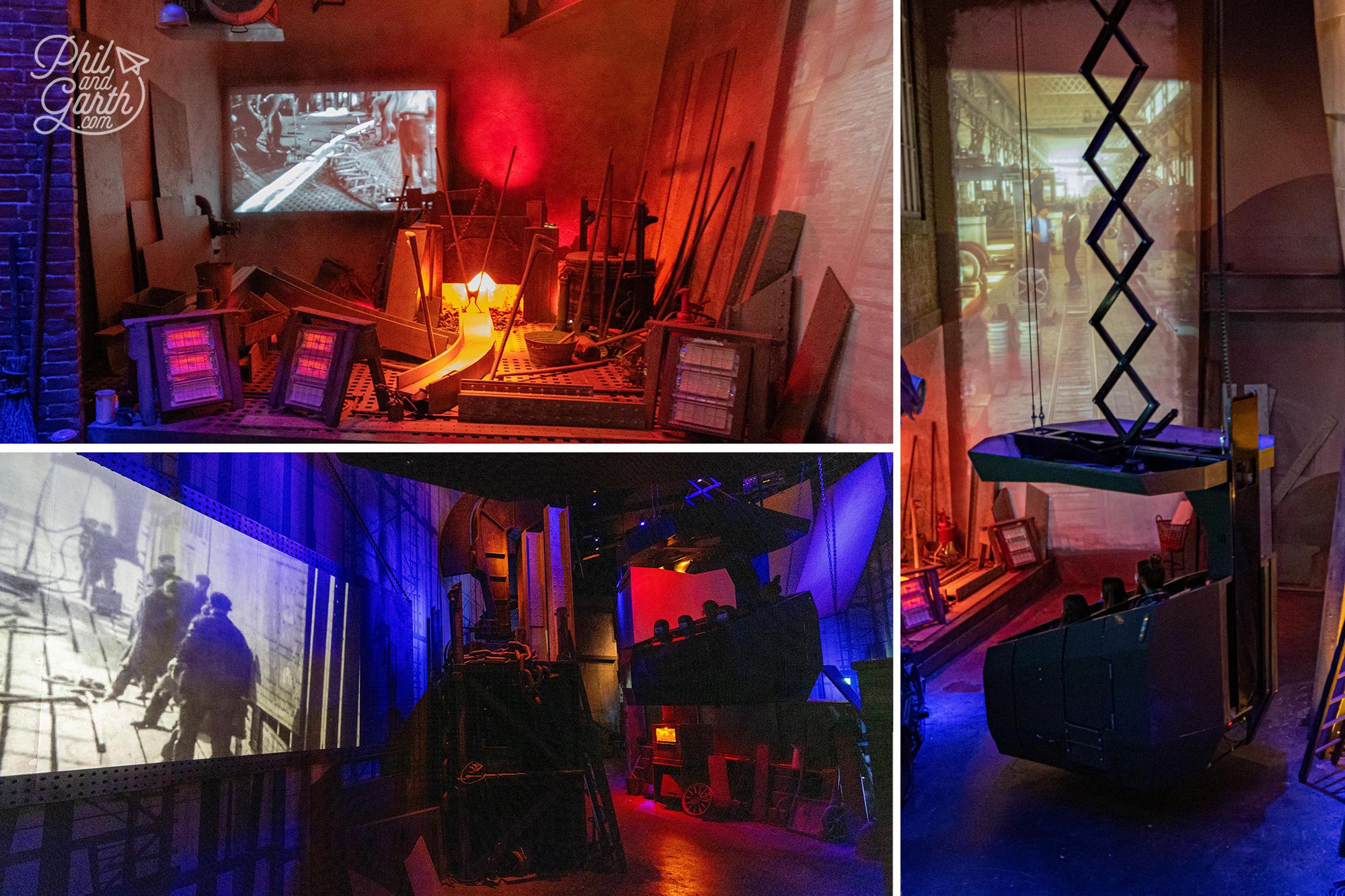
The Shipyard Ride twists and turns through the shipyard construction site
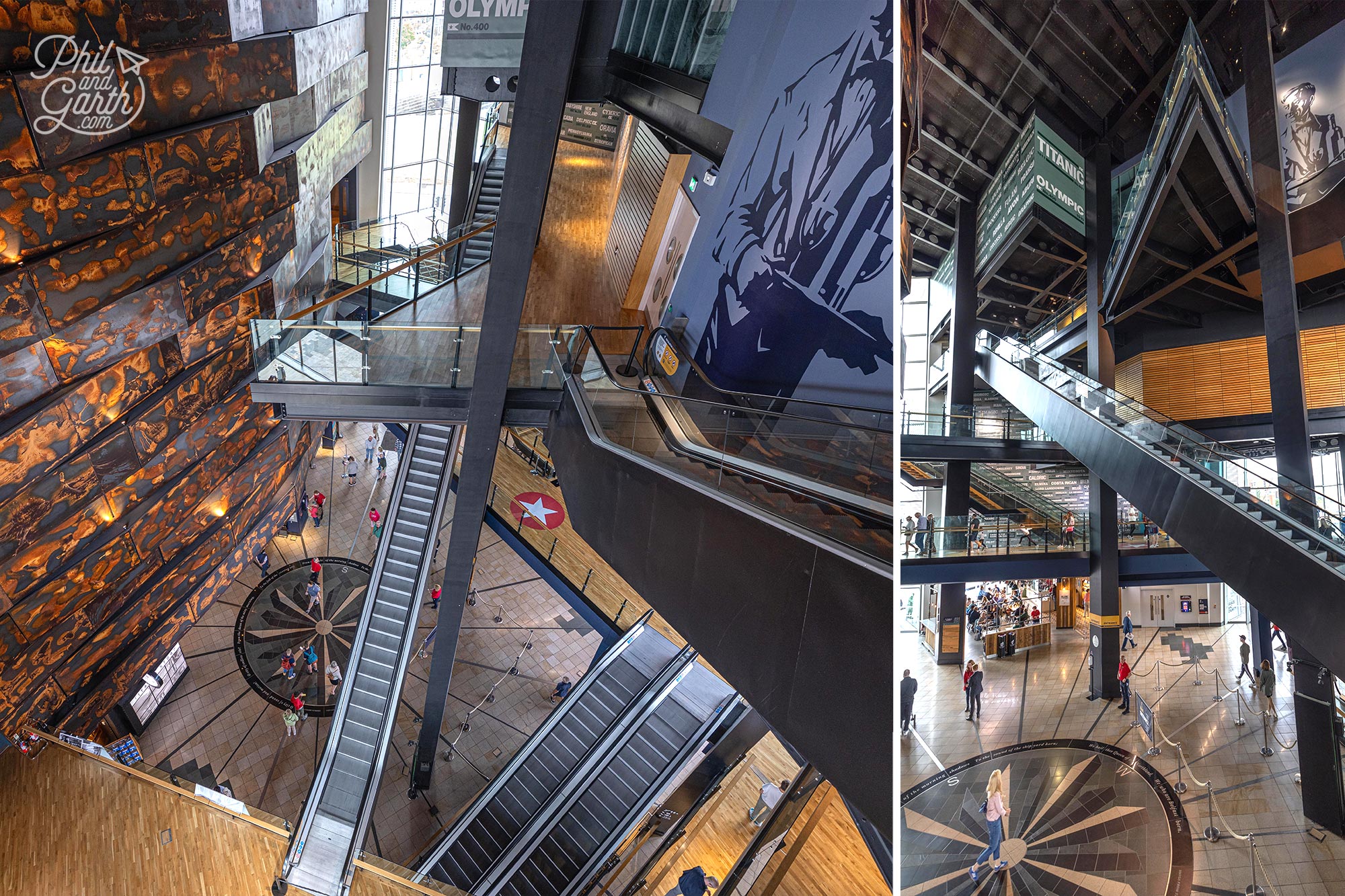
Titanic Belfast – 9 exhibition galleries over 6 floors
Next is the launch day exhibition, followed by another immersive experience in a 360-degree cinematic room. This again is brilliant and makes you feel like you are onboard as you stand watching a tour of all Titanic’s decks. Starting with the engine room, through the Third Class C deck, you sweep through the grand first class staircase and end up on the bridge. From here you can explore recreations of the Titanic’s opulent bedrooms done with immaculate details and more clever video projections with ghostly images of passengers and staff in period dress.
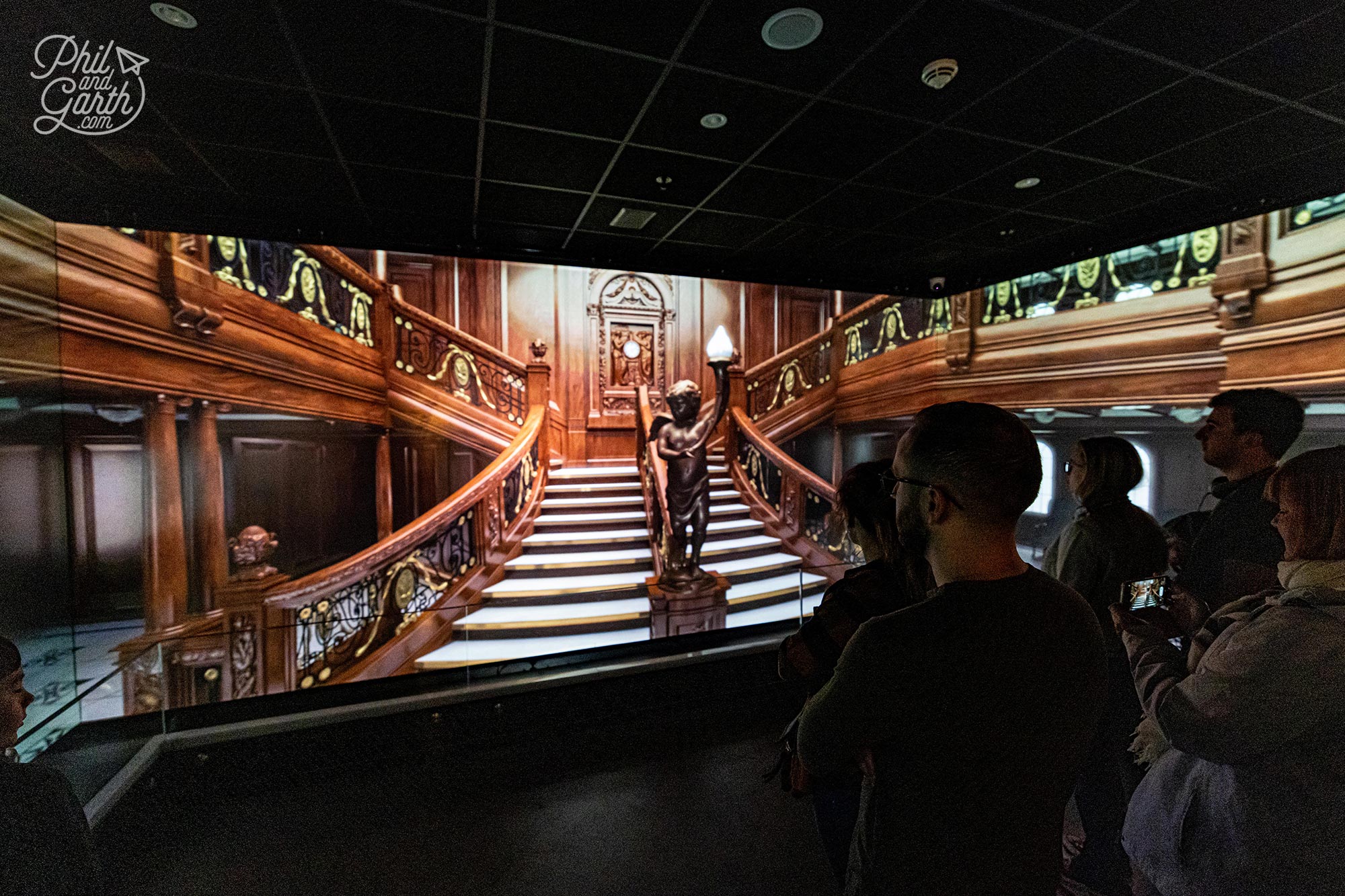
Journey through the different decks of Titanic
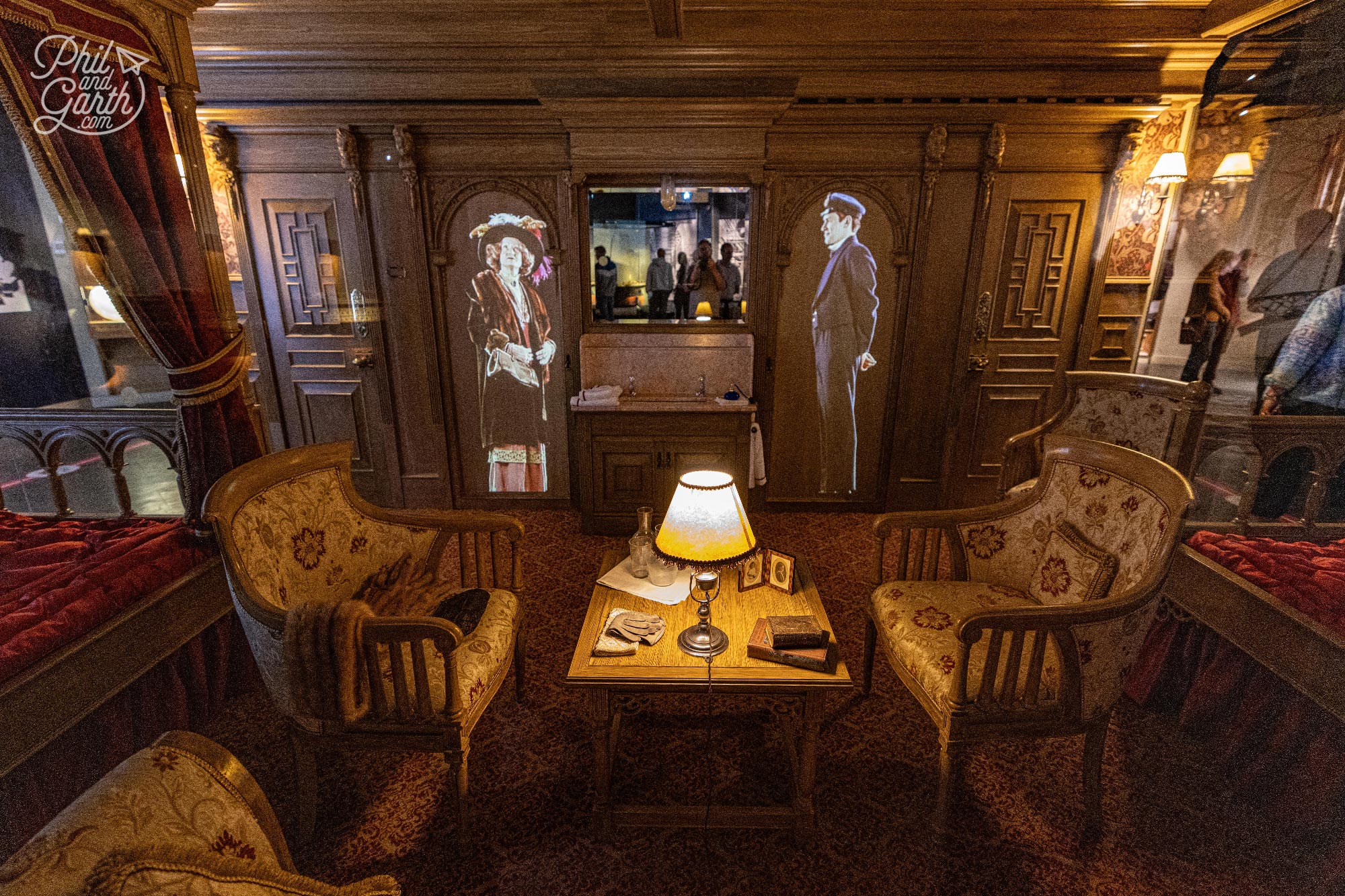
Great recreations of Titanic’s 1st and 2nd class bedrooms
Next is the tragic tale of the iceberg and that fateful day that led to the sinking of Titanic, over 1,500 lives were lost. This part of the exhibition is dark and poignant, especially with the sounds of SOS Morse code messages. There’s a replica of a lifeboat used for the rescue and stories and images of the passengers who died.
The tour ends with ‘Titanic Beneath’ – a cinematic tour of the Titanic wreck. And in case you are wondering, yes at one point they played Celion Dion’s famous Titanic song! so emotional!
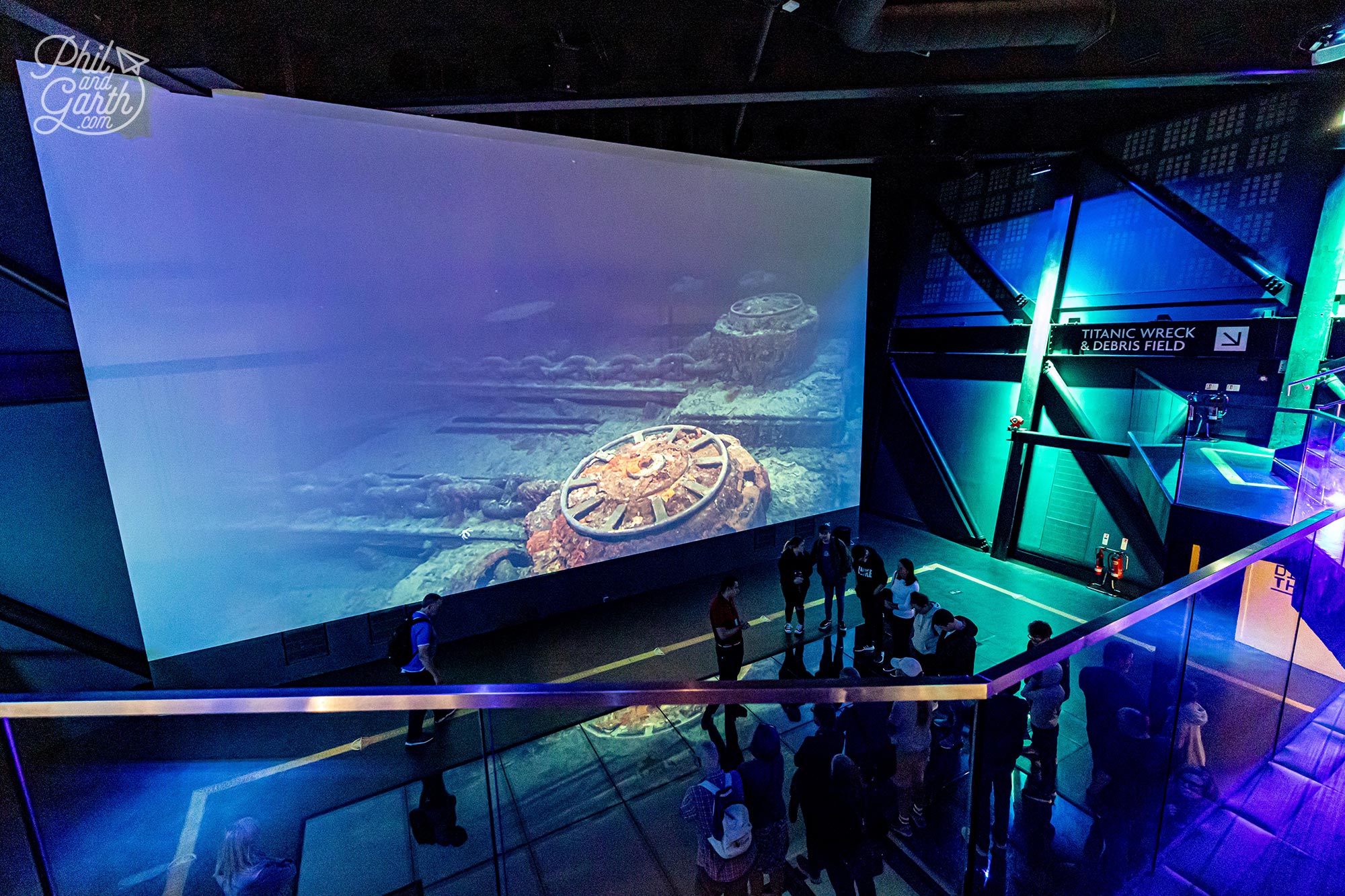
Titanic Beneath – a cinematic tour of the Titanic wreck
Included with your ticket is entry to SS Nomadic – the last remaining White Star Line vessel. This tender ship was used to ferry passengers, luggage, and goods to Titanic and Olympic. SS Nomadic is exactly one-third the size of Titanic and carried 400 first-class passengers and 500 second-class passengers. Inside we could feel the Edwardian grandeur and how luxurious Titanic would have been because Nomadic features some of the same luxurious interior finishes. Garth liked the design of the lino floor pattern in the first-class areas which was exactly the same as the one used in the first-class dining saloon on Titanic.
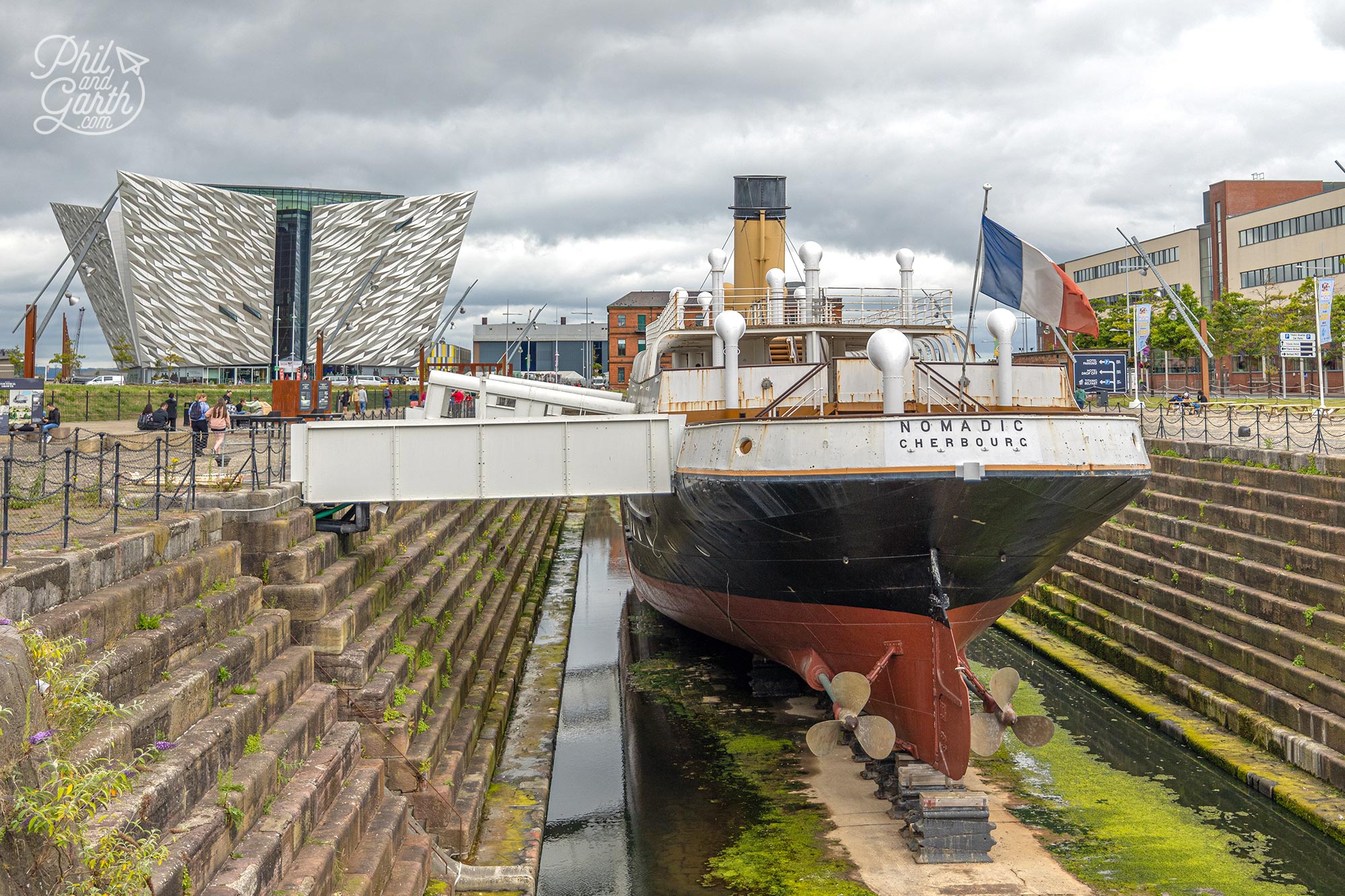
SS Nomadic was a tender ship used to ferry passengers to Titanic
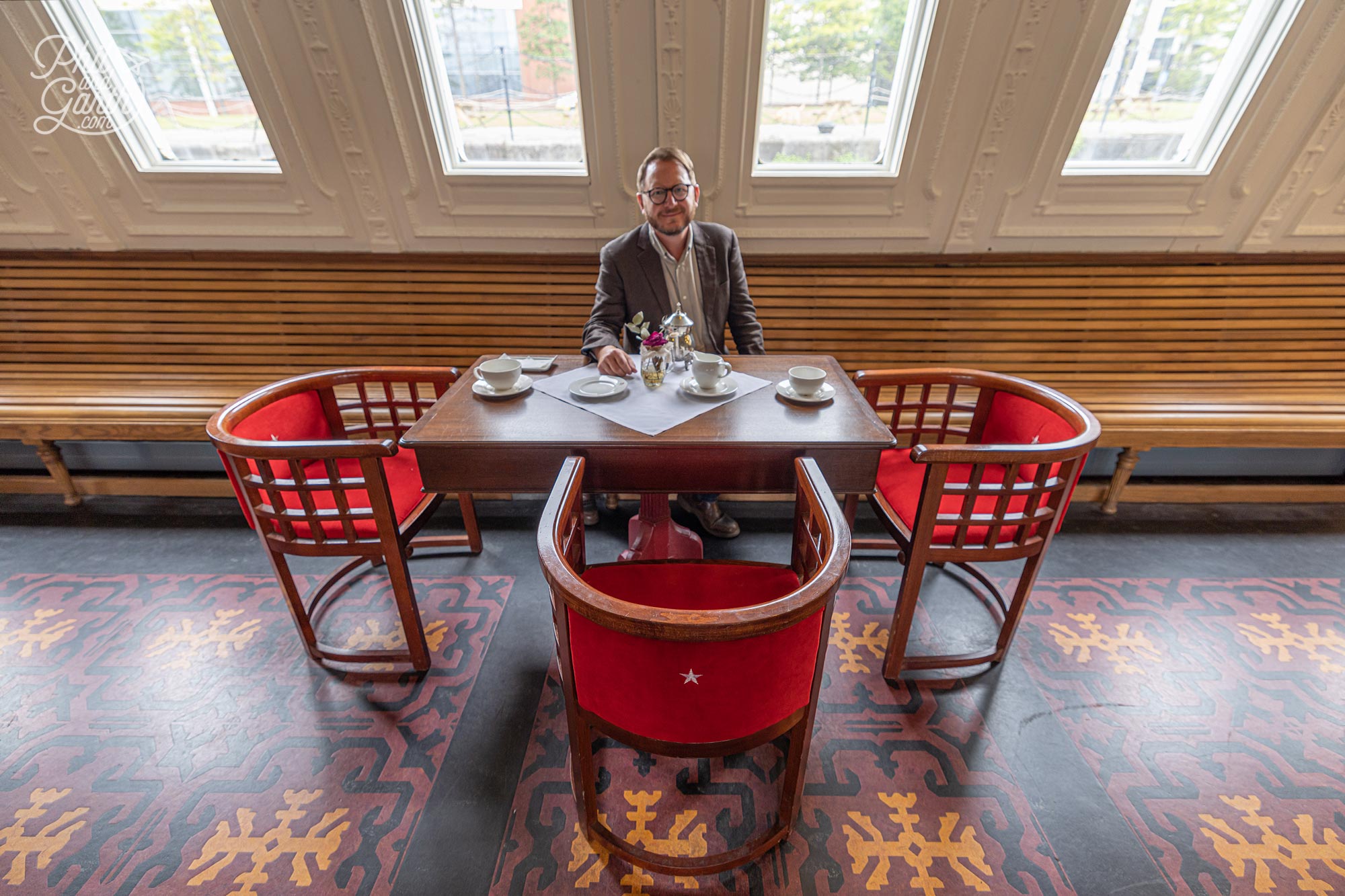
Garth in another first class cabin. The floor is exactly the same design as the dining saloon on Titanic
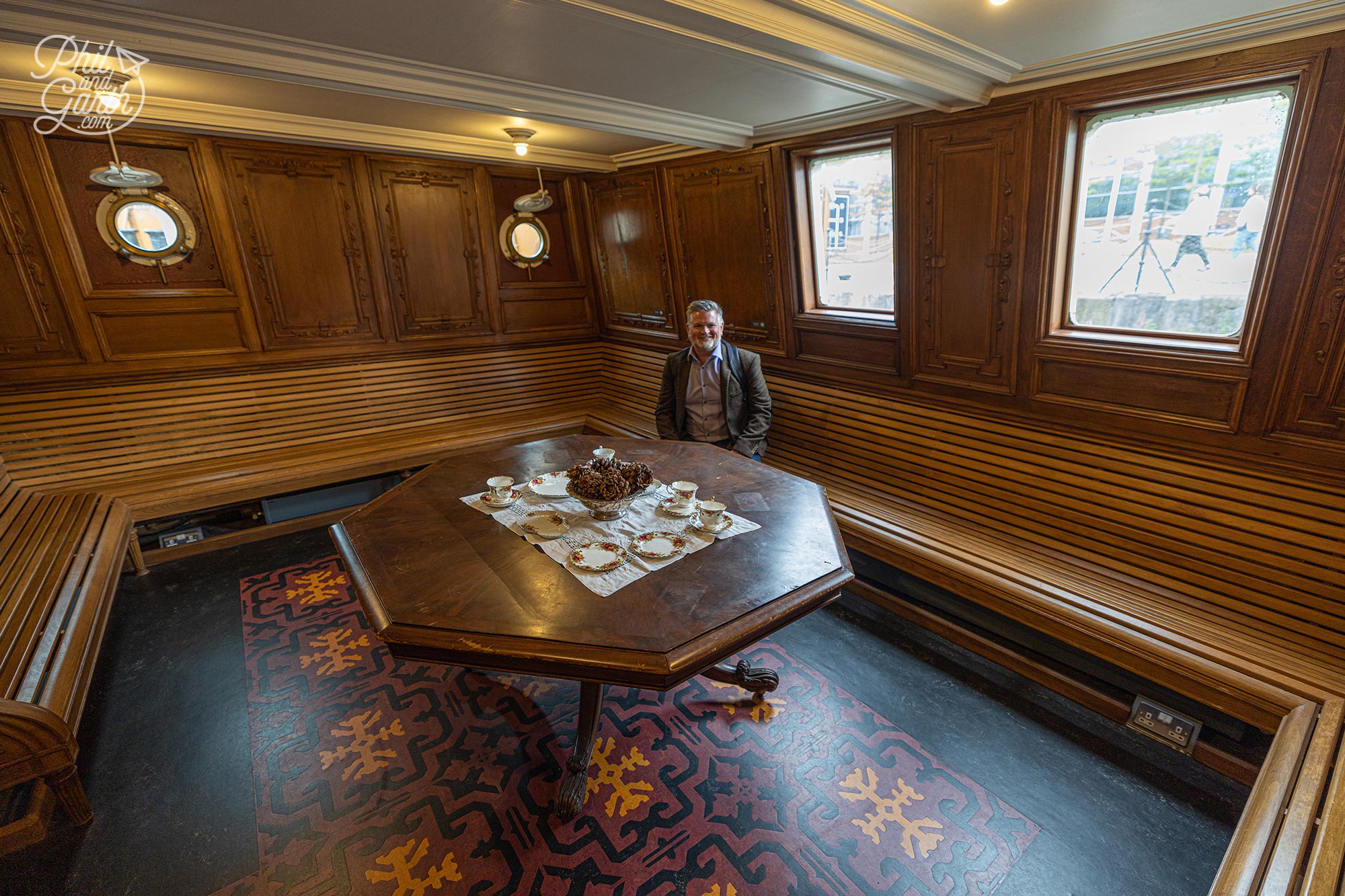
Phil in one of SS Nomadic’s first class cabins
Cocktails at The Titanic Hotel Belfast
After spending a few hours in the museum enjoy a cocktail or two at the Titanic Hotel Belfast next door. This is where the Titanic was designed and where the bar is situated in the old Harland and Wolff drawing office No.2. Make sure you check out the tiles that decorate the bar – they are the same ones used in Titanic’s swimming pool.
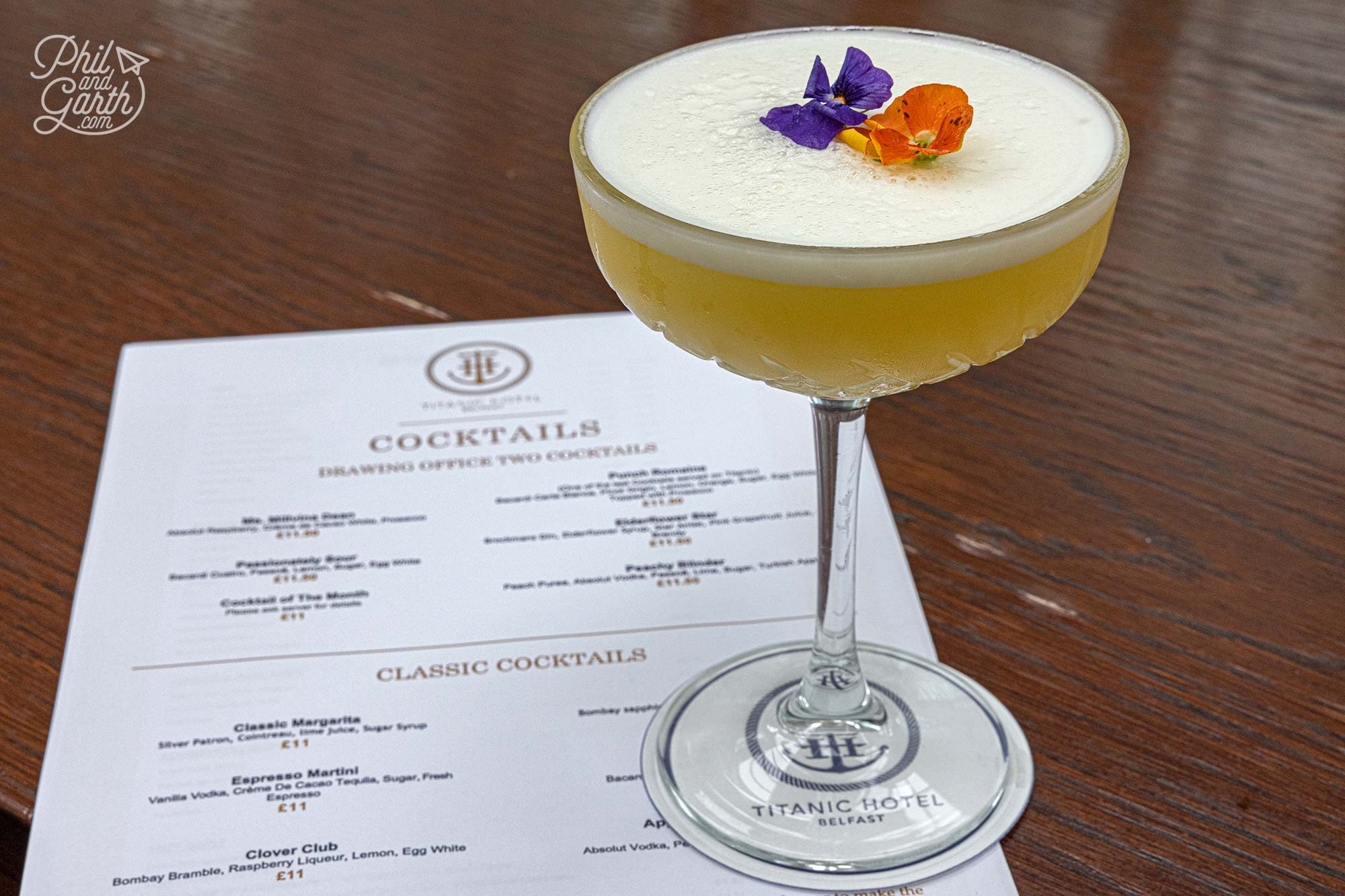
A Punch Romaine cocktail – one of the last cocktails served on Titanic
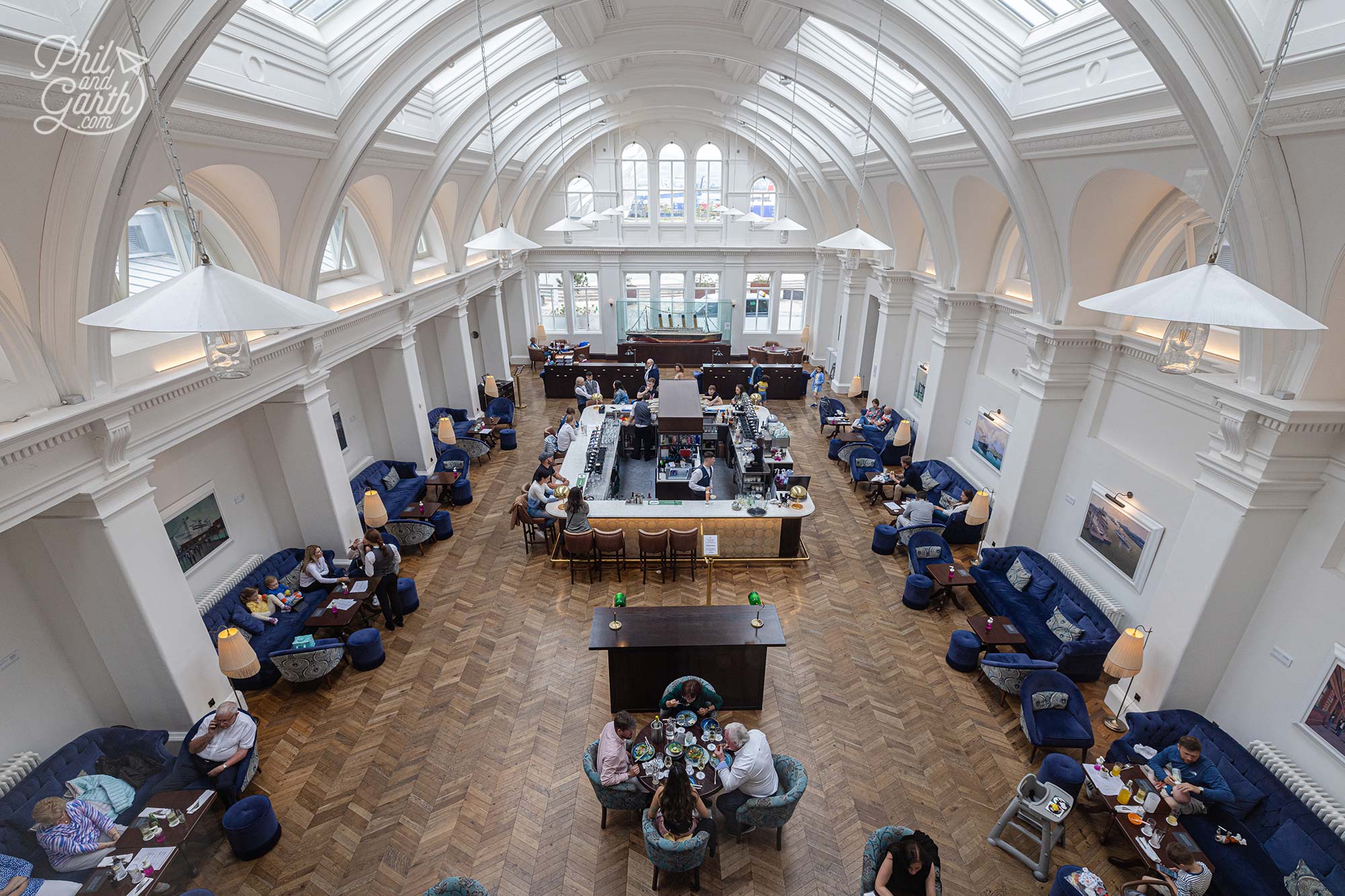
The fabulous space and cocktail bar of Drawing Office Two
Day 2 – Belfast Itinerary
Giant’s Causeway Day Trip
Day 2 of our Belfast 3-day itinerary starts with a day trip to the Giants Causeway with McCombs Coach Tours. It was such a great day where we packed in loads and learned so much from our driver and guide called Patrick (obvs). He was super funny and very knowledgeable and really keen to take questions and answer them. The tour leaves every morning at 8.30 am outside the Europa Hotel and returns at 5.30 pm.
Carrickfergus Castle
Our first stop was a quick photo stop at Carrickfergus Castle. A 12th-century castle built by Anglo-Normans (the English) that was later captured by the Scots and the French. It went on to be used as a garrison during the First World War and as an air raid shelter in World War Two.
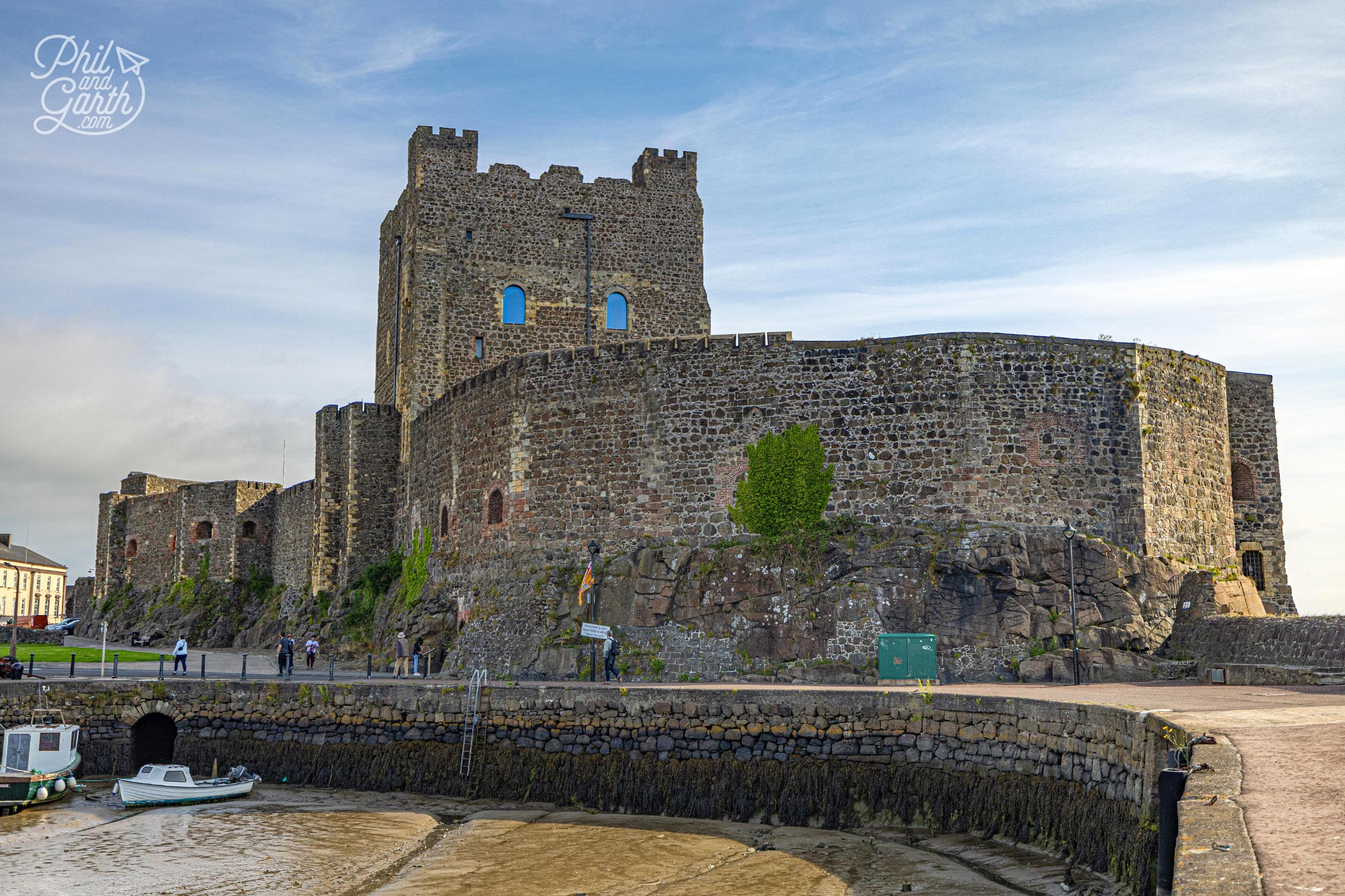
Carrickfergus Castle in the town of Carrickfergus, County Antrim
Outside the castle is a life-size bronze statue of King William III, also known as William of Orange. Back in the day, he reigned as the King of England, Scotland, Ireland, and The Netherlands from 1689 to 1702. He was a champion of Protestants and defended them against Roman Catholics.
Quick history lesson – In 1677 William of Orange married his cousin Mary. Mary’s father became Britain’s King James II in 1685 after the death of his brother, King Charles II. James was a Roman Catholic, but many people in England were Protestant. The English turned against King James II when he tried to give more power to Catholics. James was overthrown in the “Glorious Revolution” of 1688, forced out, and fled to France. William of Orange and his wife Mary were invited to be Britain’s new King and Queen and were crowned King William III and Queen Mary II in 1689.
In 1689 the former king – James II invaded Ireland to reintroduce Catholicism. After gathering forces and through various battles, Britain’s King William III eventually defeated James for good at the Battle of the Boyne in 1690. Today every year on July 12th people across Northern Ireland commemorate the victory of King William by displaying orange colours in his honour, but it divides Northern Ireland’s society and is not for everyone.
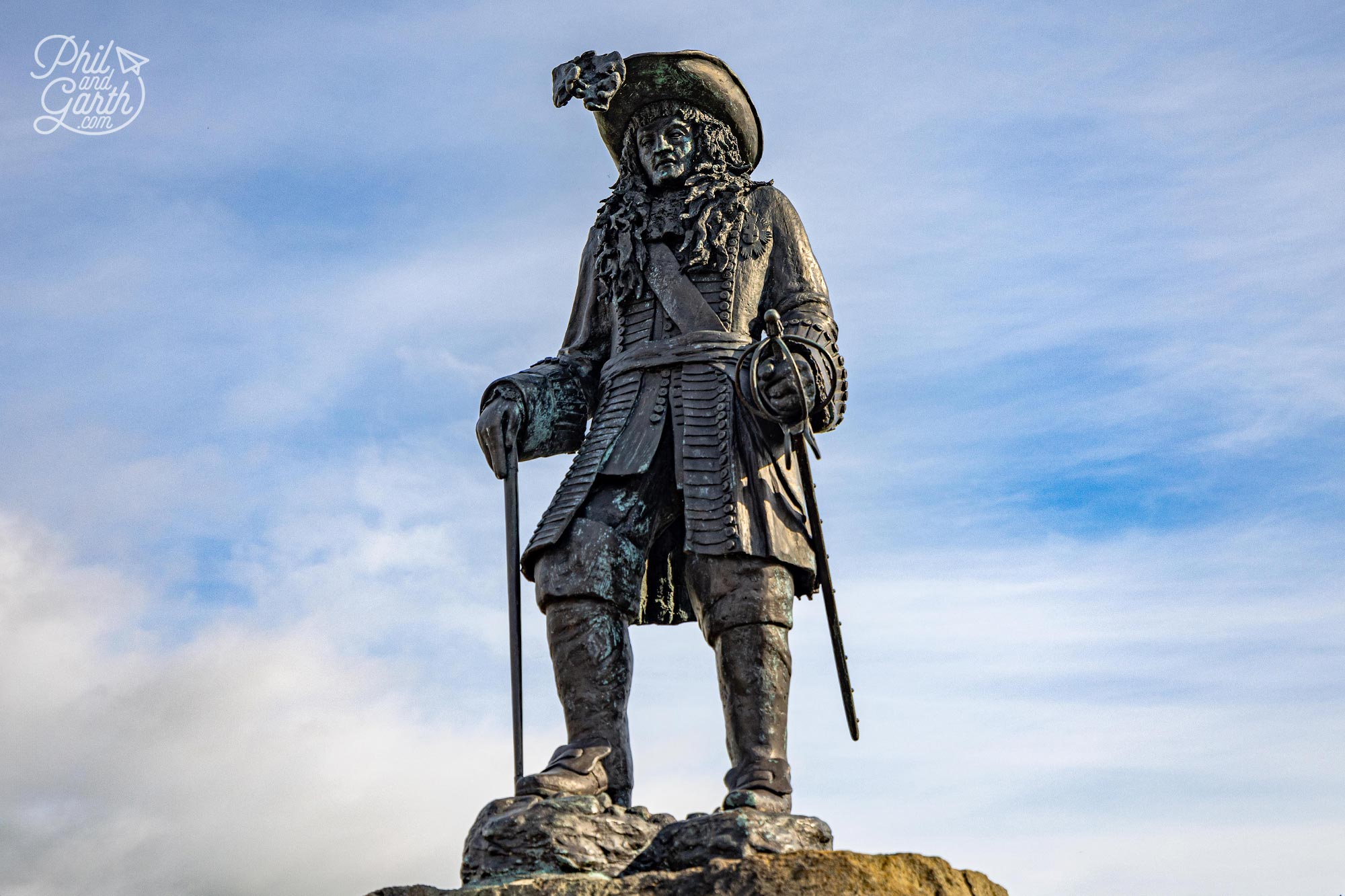
Bronze statue of King William III
Fun fact: King William ‘The Prince of Orange’ was responsible for orange carrots – they were developed by people in the Netherlands and introduced to Great Britain.
Back on the coach we had to choose our lunch order from the menu (not included).
Antrim Coastal Route
Before too long we were on the Antrim Coast Road, described by Patrick as “one of the world’s most spectacular drives” He’s right the scenery is pretty spectacular. We passed lots of sheep grazing on the glens and could even see Scotland to the right at times. It was interesting passing through Unionist villages where they painted everything red white and blue and displayed Union flags and the Ulster flag with the red hand, which actually has no official status.
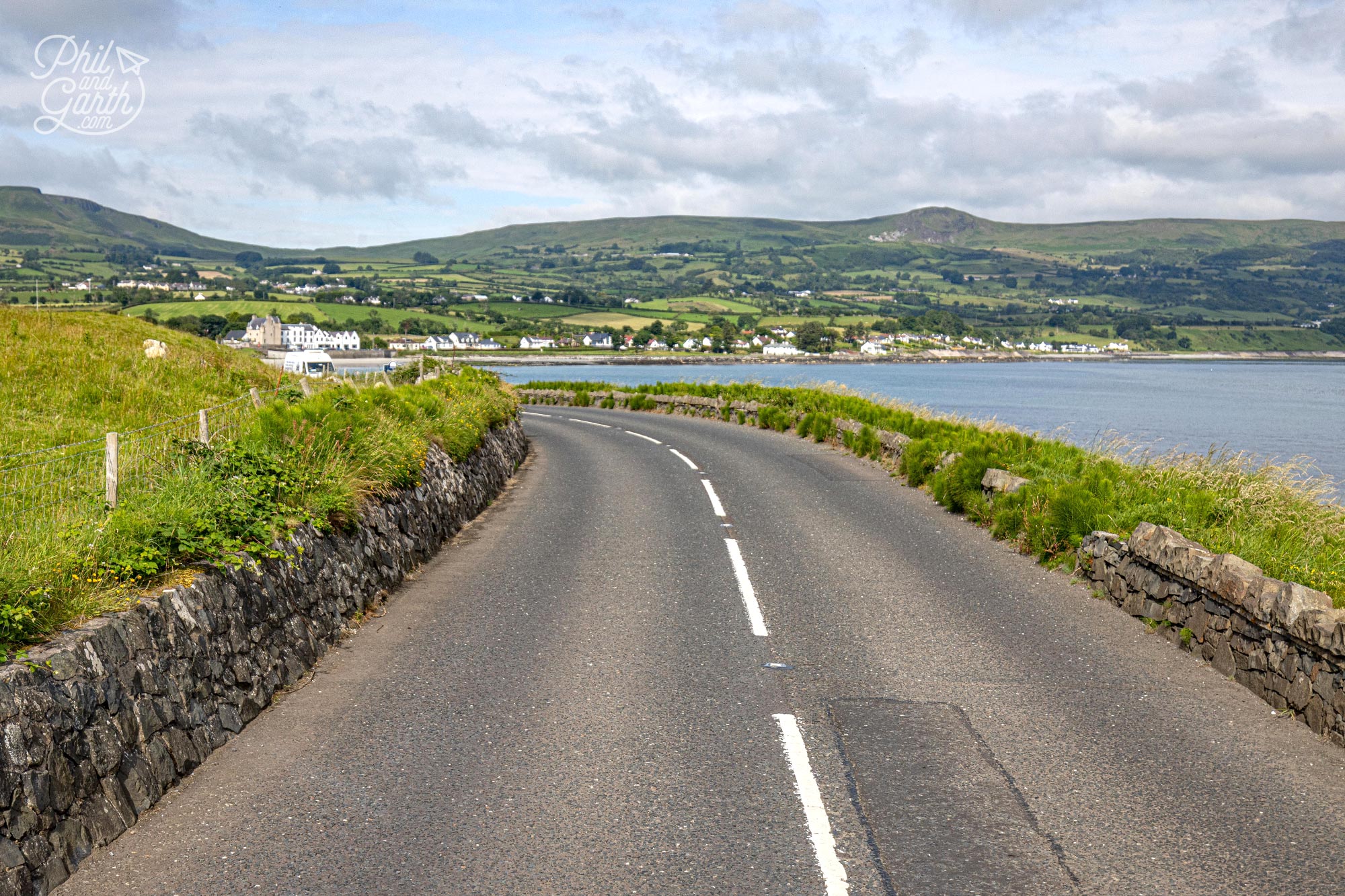
The Antrim Coast Road is a stunning road trip
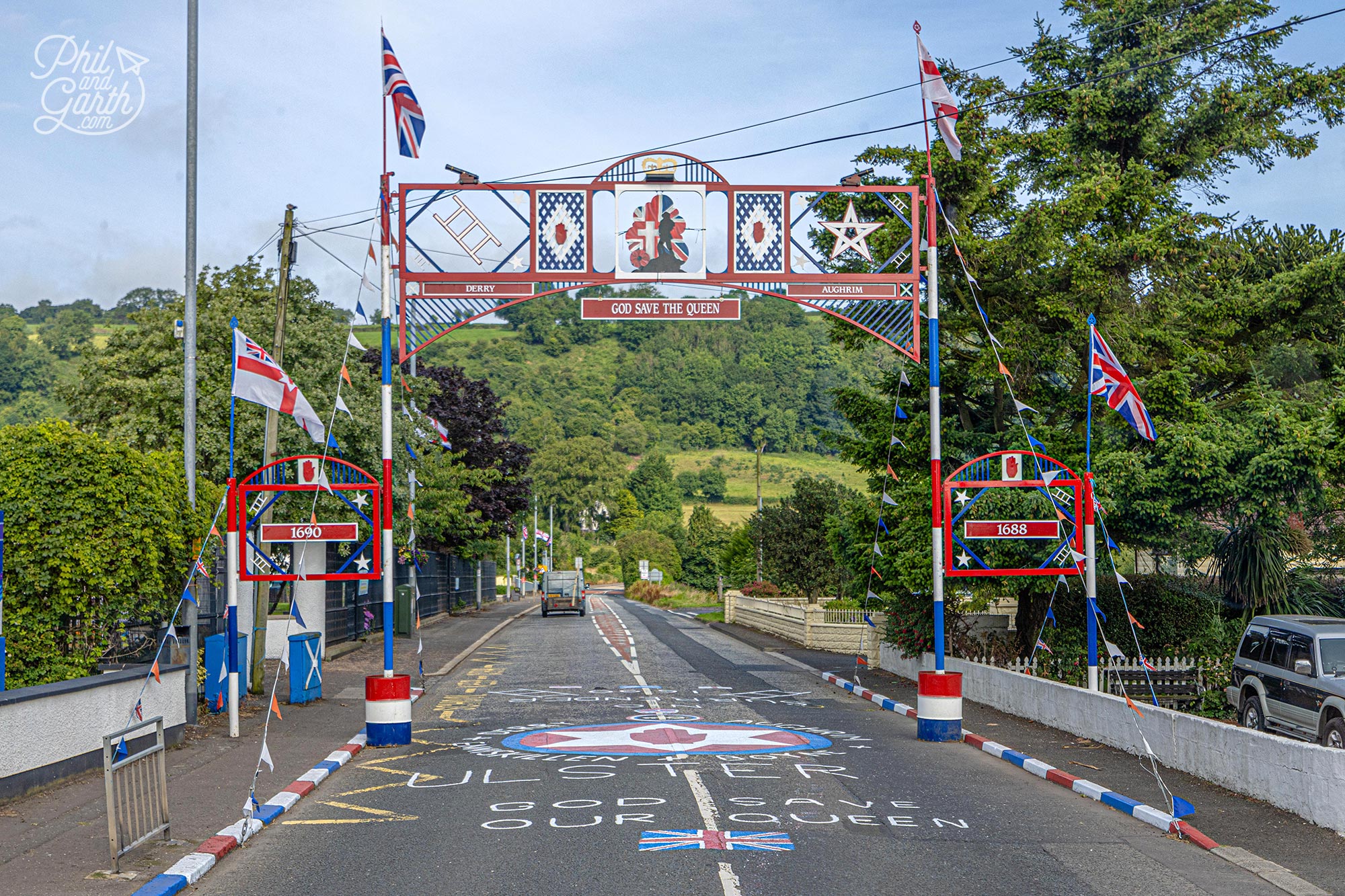
Passing through a distinctly Unionist village
Patrick briefly explained the political split in Northern Ireland – Unionists are very British and are very patriotic, they love being a part of the UK, displaying symbols like union flags and images of the Royal family. Nationalists prefer an Irish identity and promote the Gaelic language, their ultimate goal is to reunite Ireland as one country.
Carnlough Village
Our second stop was the sleepy fishing village of Carnlough. The village harbour was our first Game of Thrones filming location. In Season 6, Episode 7 Carnlough’s harbour was used as the fictional city, Braavos. Where Arya Stark jumps into the harbor to escape a brutal attack and then crawls up the harbor steps to survive.
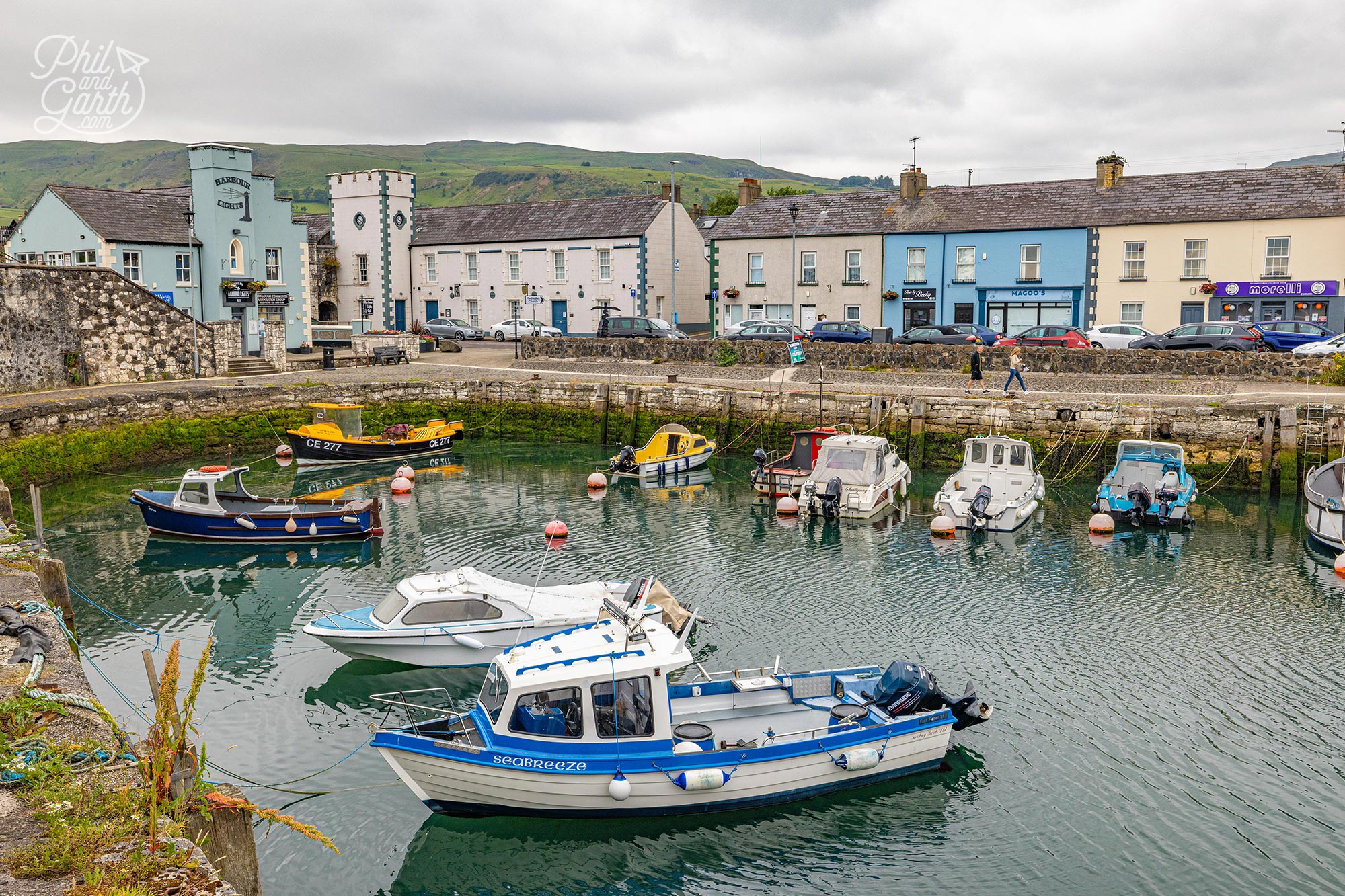
Carnlough’s pretty harbour
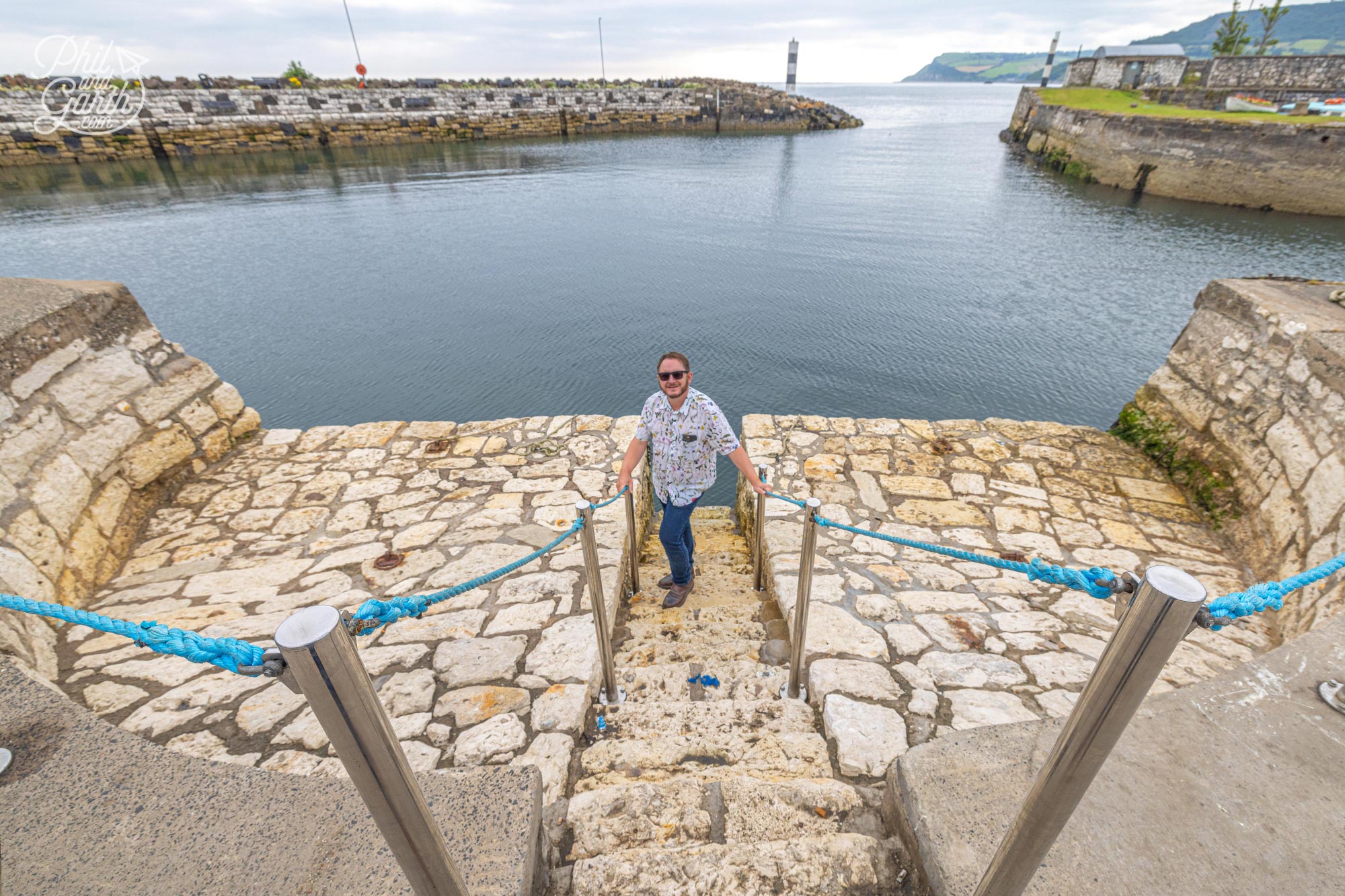
Carnlough Village – our first Game Of Thrones filming location
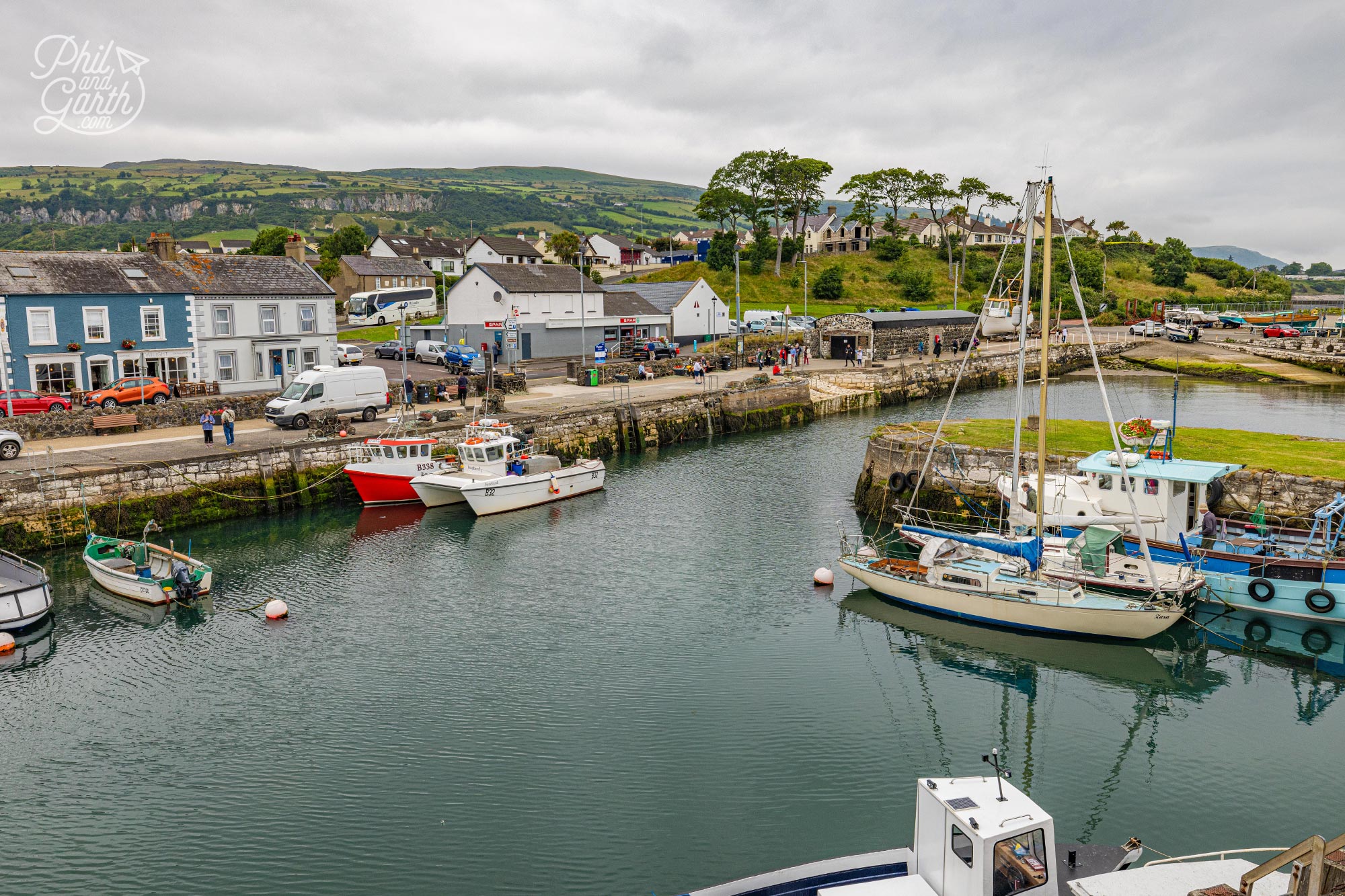
Carnlough is located off the stunning Antrim coastal road in Northern Ireland
Cushendun Caves
Our third stop was Cushendun Caves, another Games of Thrones location where in season 2 Lady Melisandre gave birth to a terrifying shadow baby. The caves might look man-made, but they are actually over 400 million years old! wow. Locals call them the pudding stones because the walls inside are like a mosaic of little rocks. Created naturally over time – carved by humidity, the ocean, and salt. There are 2 caves to explore and you make your way there across a shingle beach.
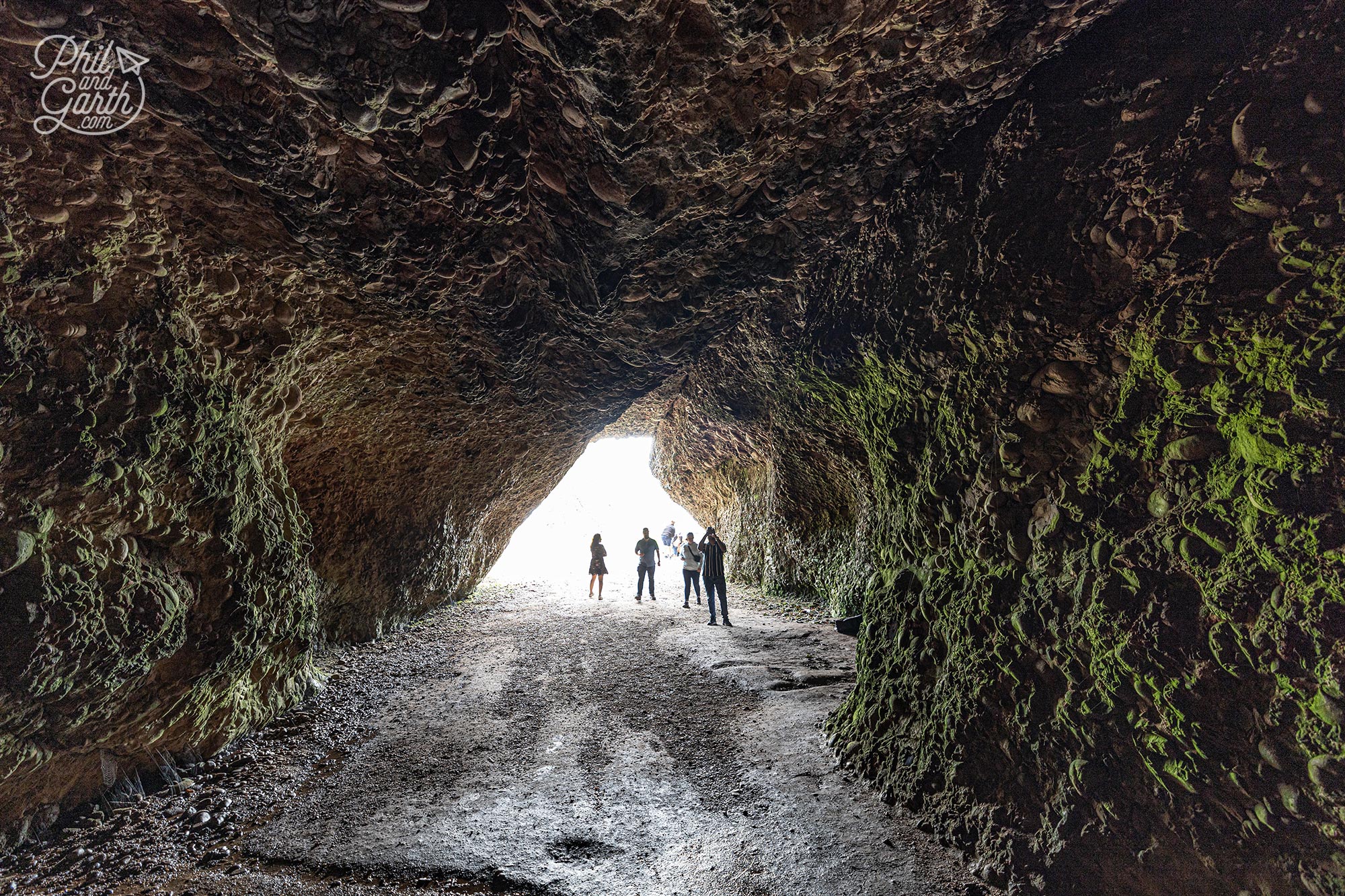
The dramatic and eerie Cushendun Caves
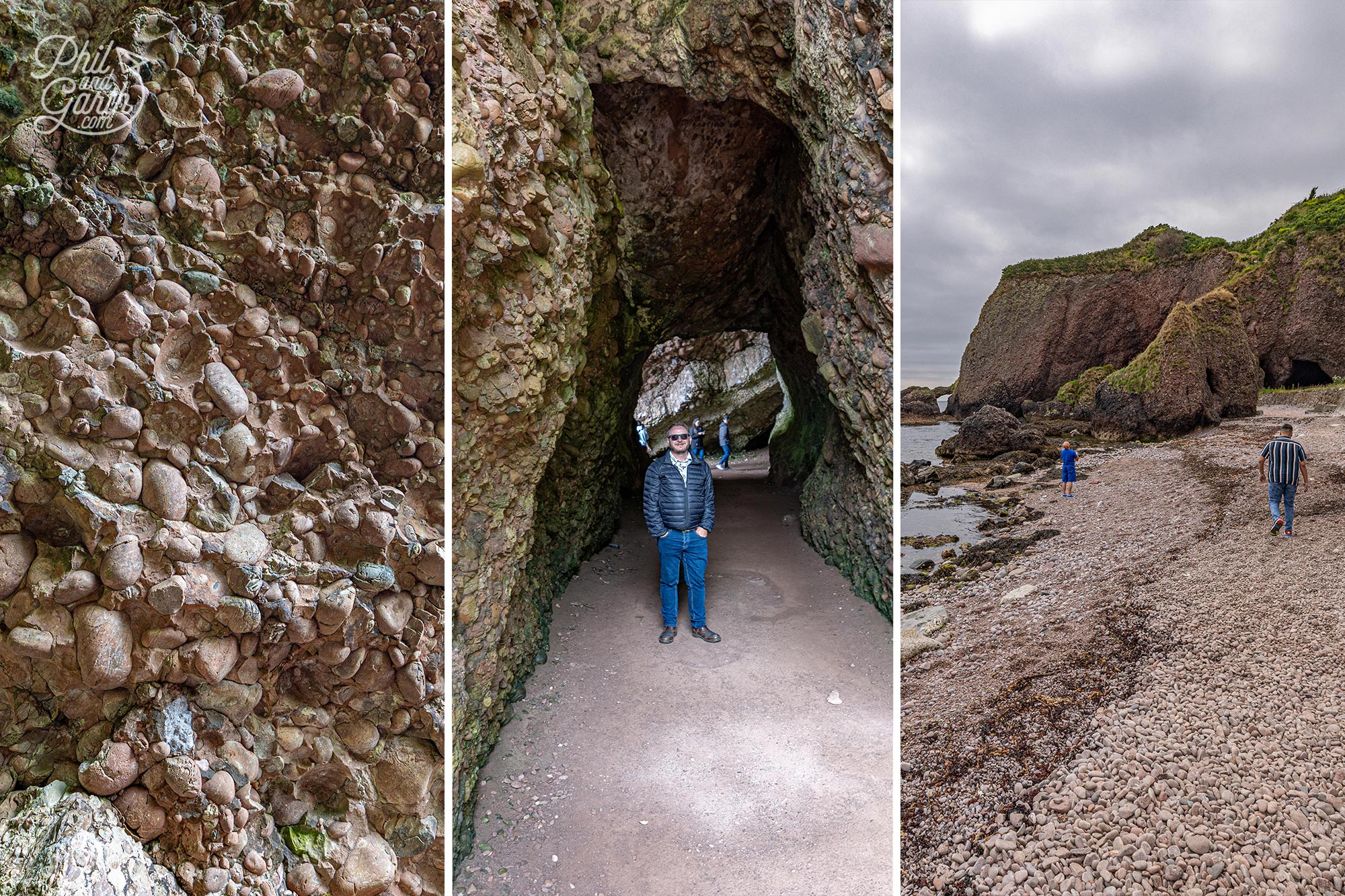
Garth in the Cushendun Caves
The Dark Hedges
Our 4th stop was The Dark Hedges – another Game of Thrones filming location that featured in Season 2 for just 8 seconds as the King’s Road. It’s been made even more famous on Instagram and is a super popular location for wedding photos. It’s a stunning avenue of serpentine beech trees where its branches have reached out over the years to create an atmospheric tunnel. They were planted over 200 years ago and designed to be an impressive entrance to the mansion house you walk past to get here. We could see why they are called the Dark Hedges because they have an eerie look about them, really quite beautiful. Bet they’d be really spooky at night.
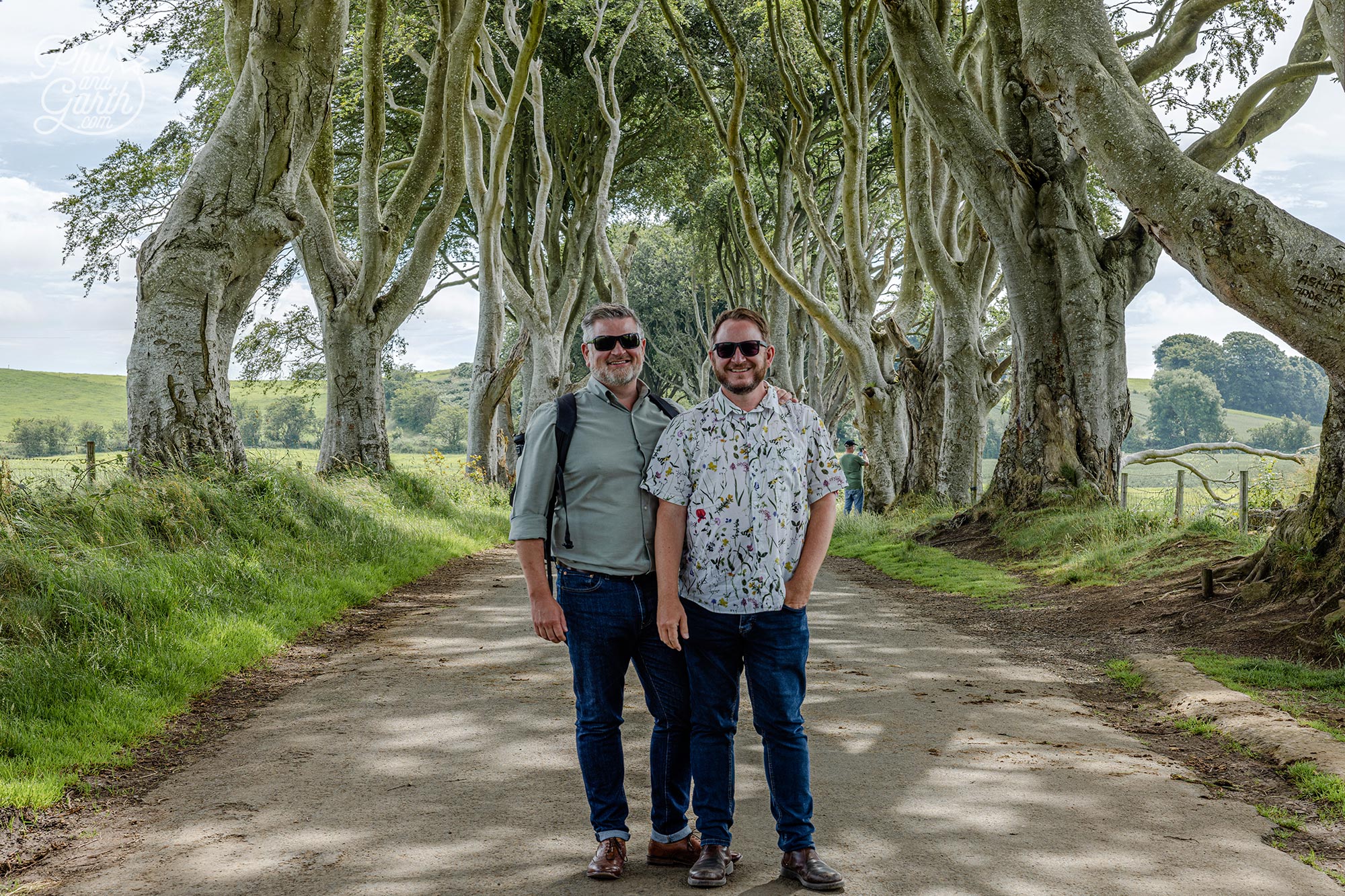
Phil and Garth at the famous Dark Hedges Games of Thrones location
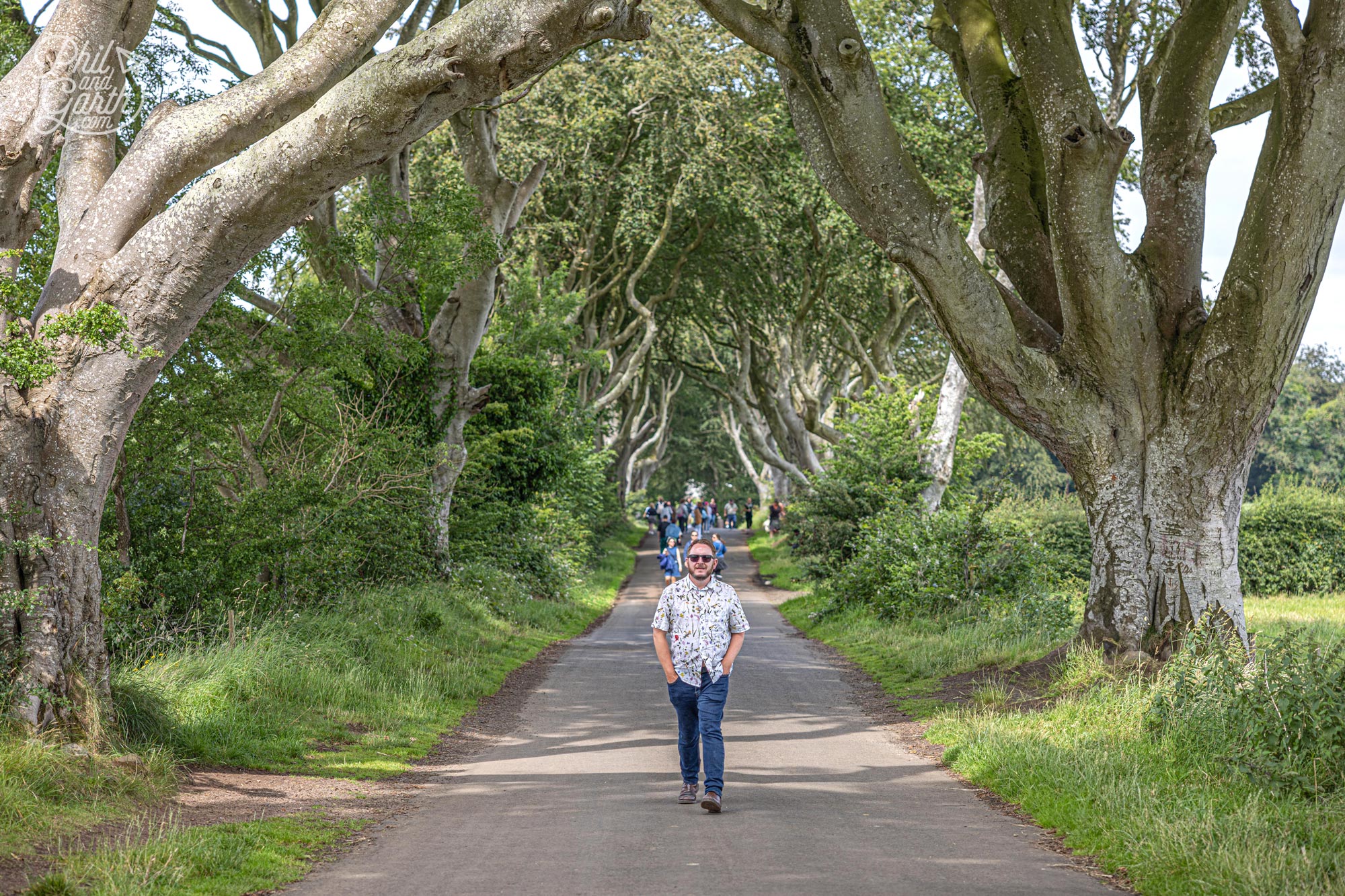
Garth strolling down The Dark Hedges
Lunch
Time for lunch and we stopped at The Fullerton Arms pub in Ballintoy. The food is pub grub style, we ordered the chicken goujons and chips and they were tasty! On your way out check out the Game of Thrones door! It tells the story of a Season 6 episode. It’s carved from trees that fell down in storms along the Dark Hedges – these were made into 10 intricate doors located across Northern Ireland. The Fullerton Arms has door No.6.
From here it’s a 15-minute drive to The Giants Causeway.
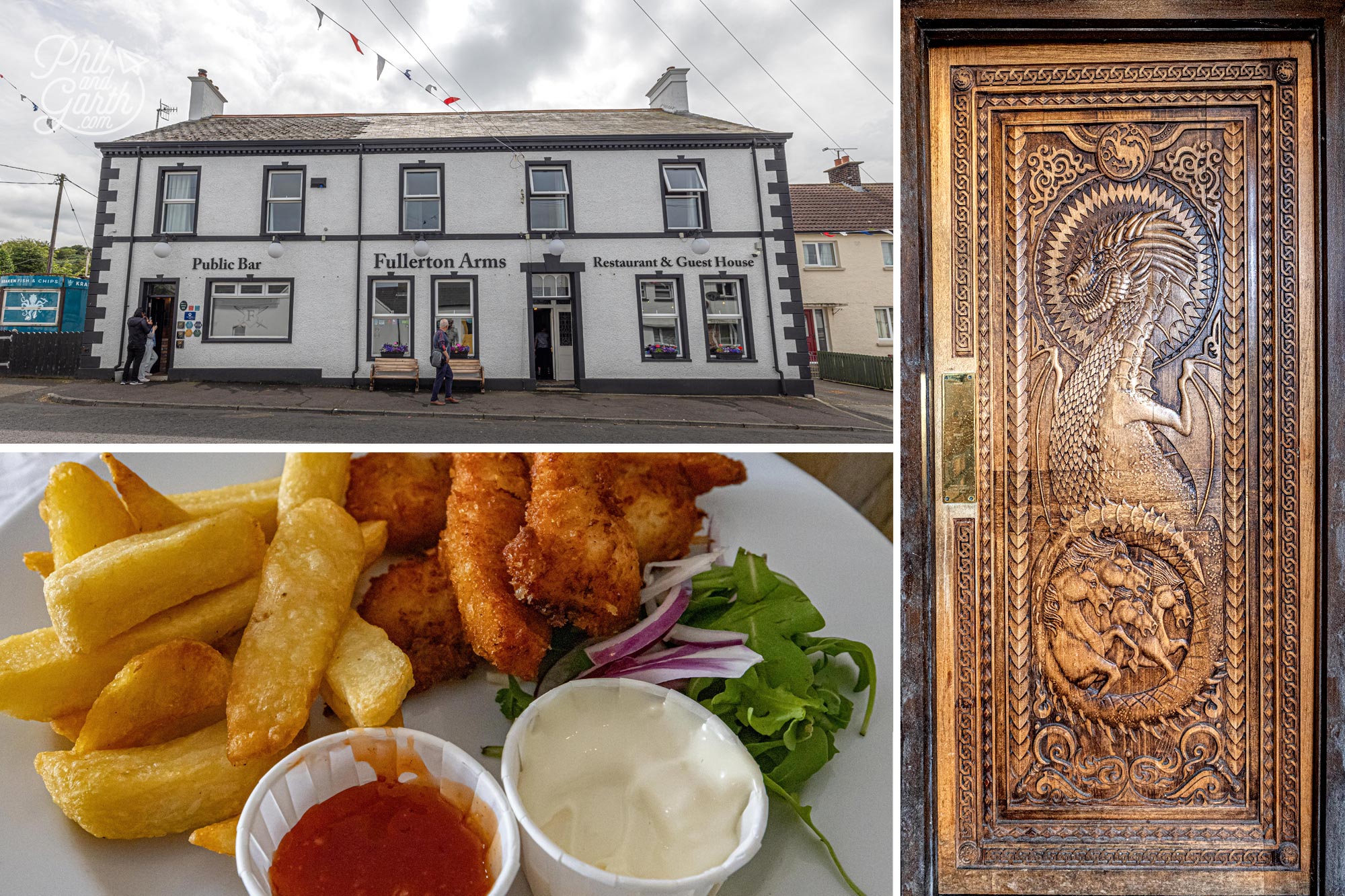
Fullerton Arms for lunch
The Giant’s Causeway
Time for the main event – a 2-hour stop at the UNESCO World Heritage Site Giant’s Causeway. It’s one of the world’s greatest natural wonders. The site features over 40,000 6-sided basalt columns that formed 50-60 million years ago when molten lava cracked and crystallised to form these hexagonal shapes. The pillars vary in height from a couple of centimetres to some reaching 39 feet.
We prefer the less scientific explanation – where legend says a 50ft Irish giant called Fionn Mac Cumhaill built the stones as a walkway to get to Scotland for a fight with the Scottish giant Benandonner. We’ve been to the other end of the causeway on Staffa Island, where Fingal’s Cave is located. We thought the Giant’s Causeway stones looked more worn down than the ones on Staffa, maybe because of the huge numbers of visitors or coastal erosion, not sure. The Giant’s Causeway is smaller than we thought it would be, that’s social media for you! Our tip here is to look for worn-down stones as a path up or down, as some of the taller parts are difficult to navigate.
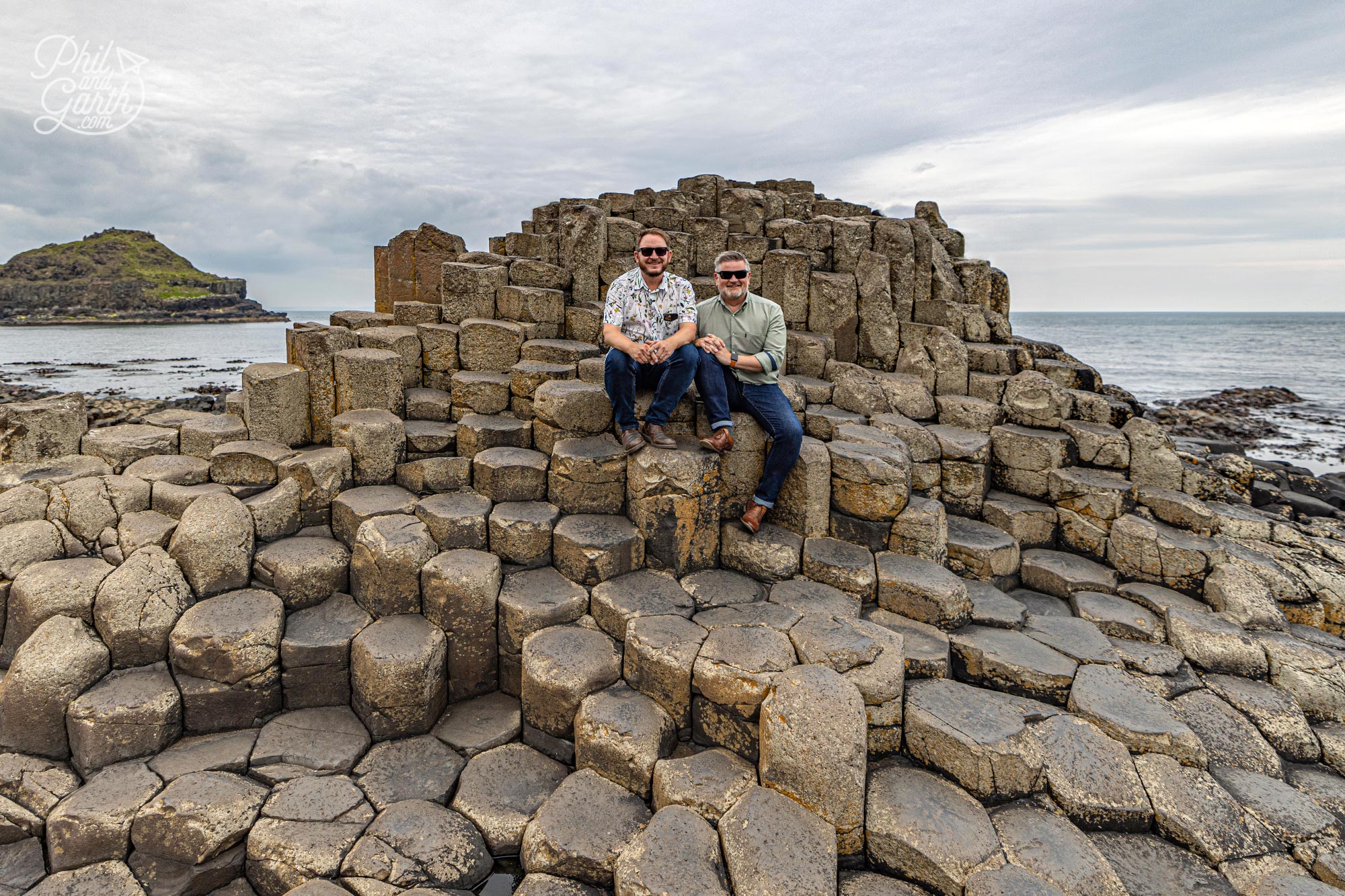
The Giant’s Causeway is the only UNESCO world heritage site in Northern Ireland
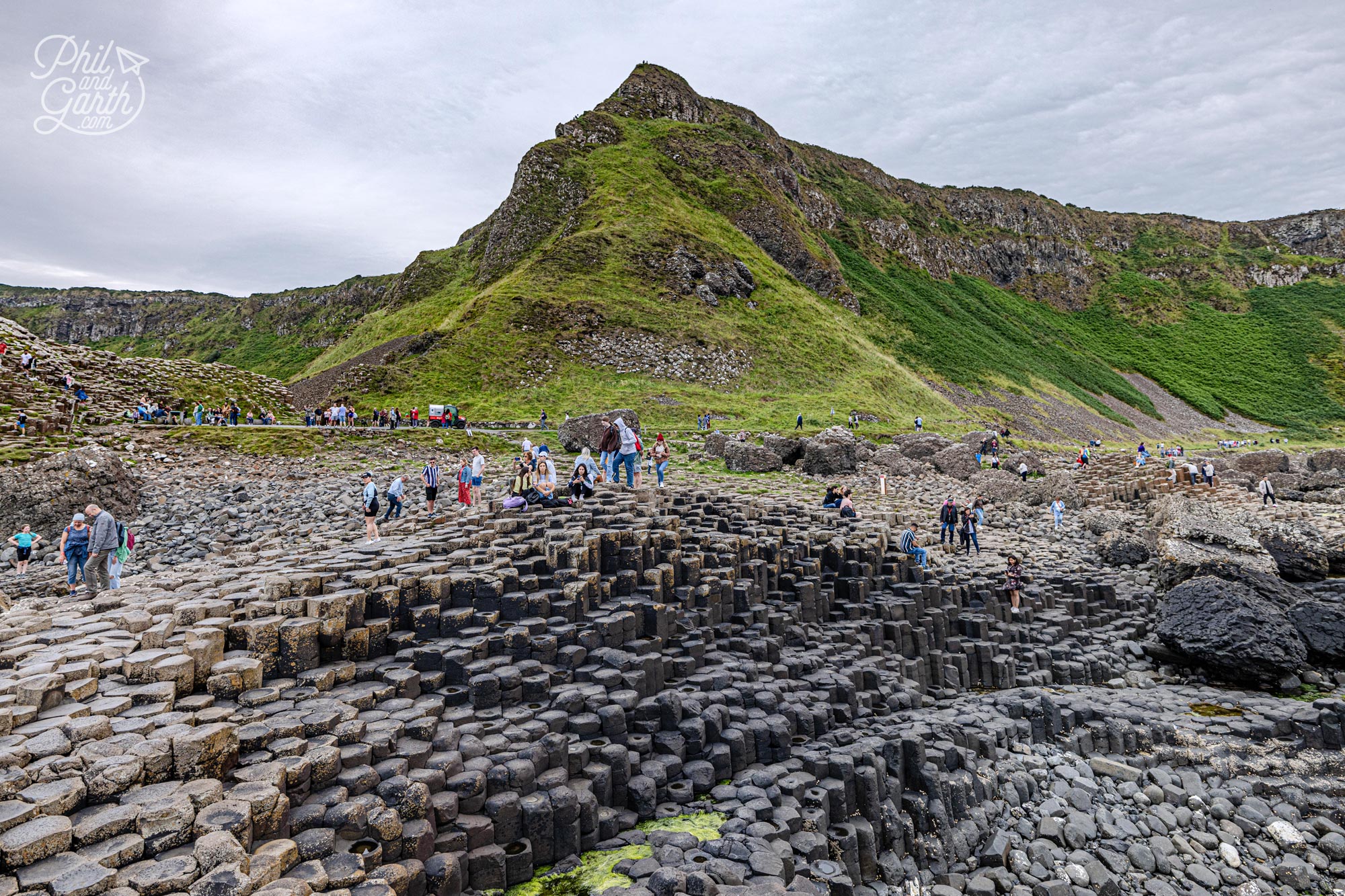
Some of the stones go 39 feet into the air
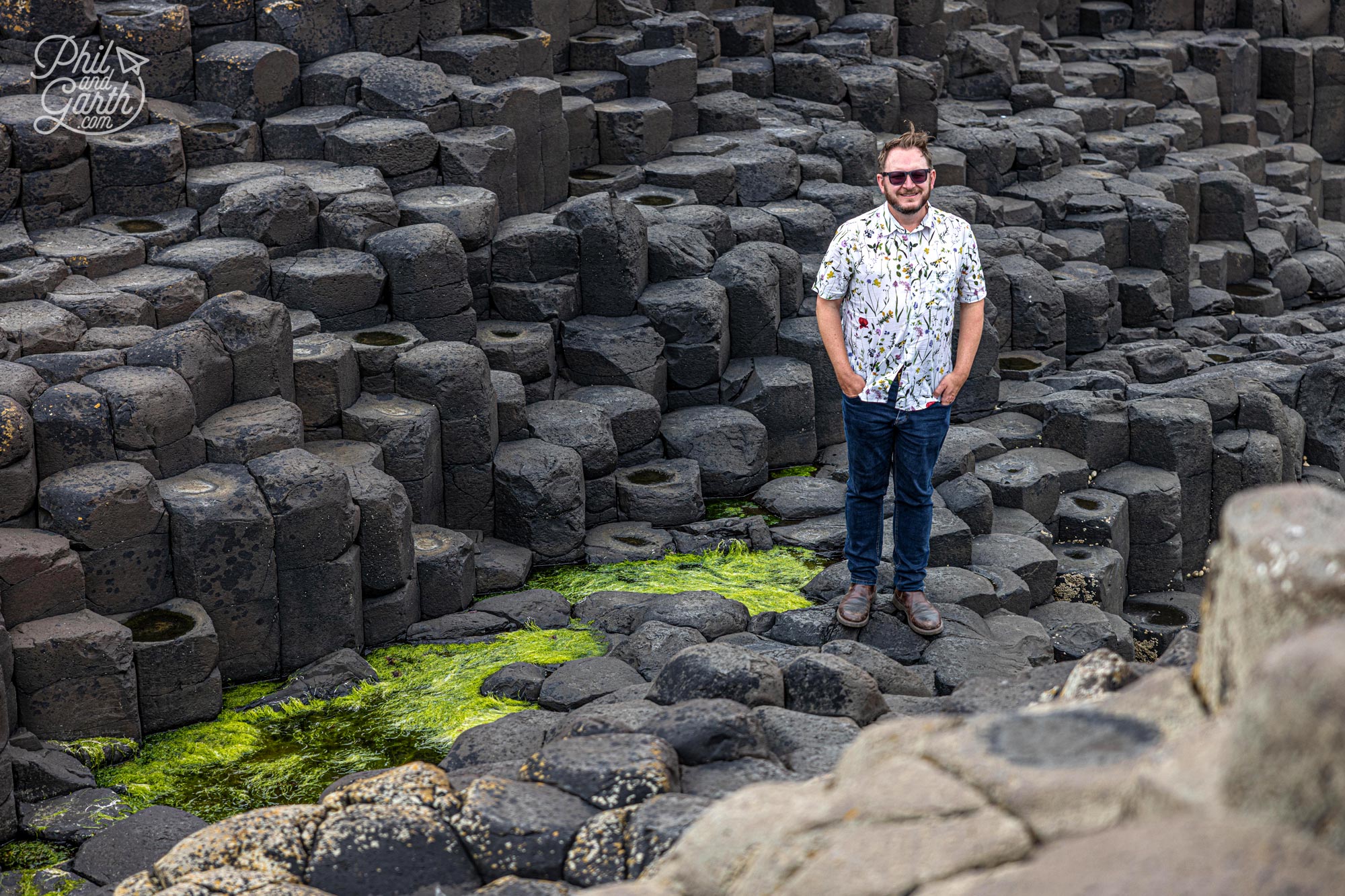
Love these black stones with bright green algae pools
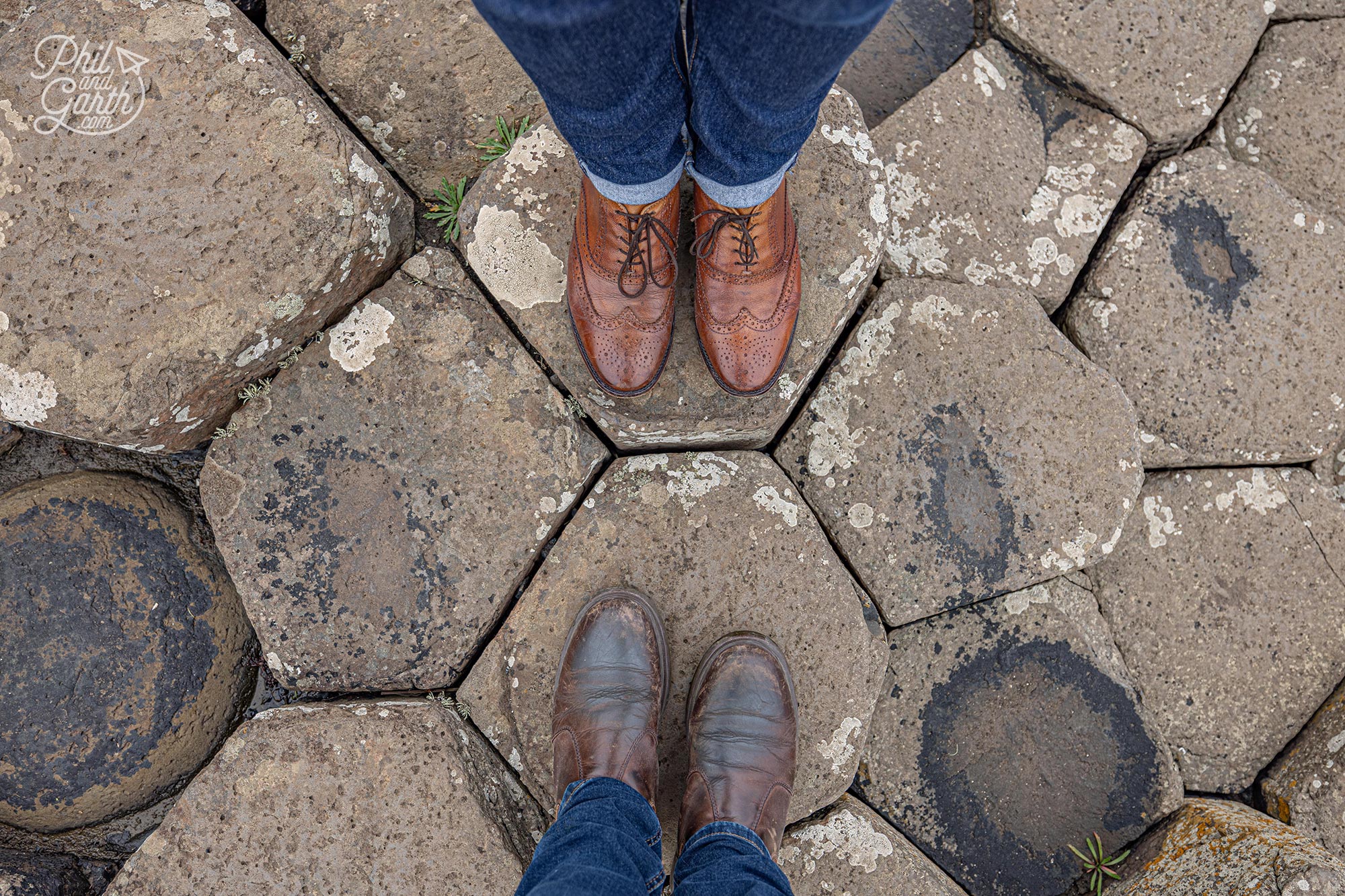
There are 40,000 of these hexagon shaped stones
It’s totally free to visit the Giants Causeway, charges only apply if you want to go inside the National Trust’s Visitor Centre or if you’re parking your car here. We thought it’s much better to spend all your time on the stones of the actual site. There are 2 trails – blue and red. The quickest from the coach is the blue trail, it has no steps and follows a gentle path down to the stones, about a 15-minute walk from the car park.
After we’d seen enough we had a quick drink in the Nook Pub, a former school next to the car park.
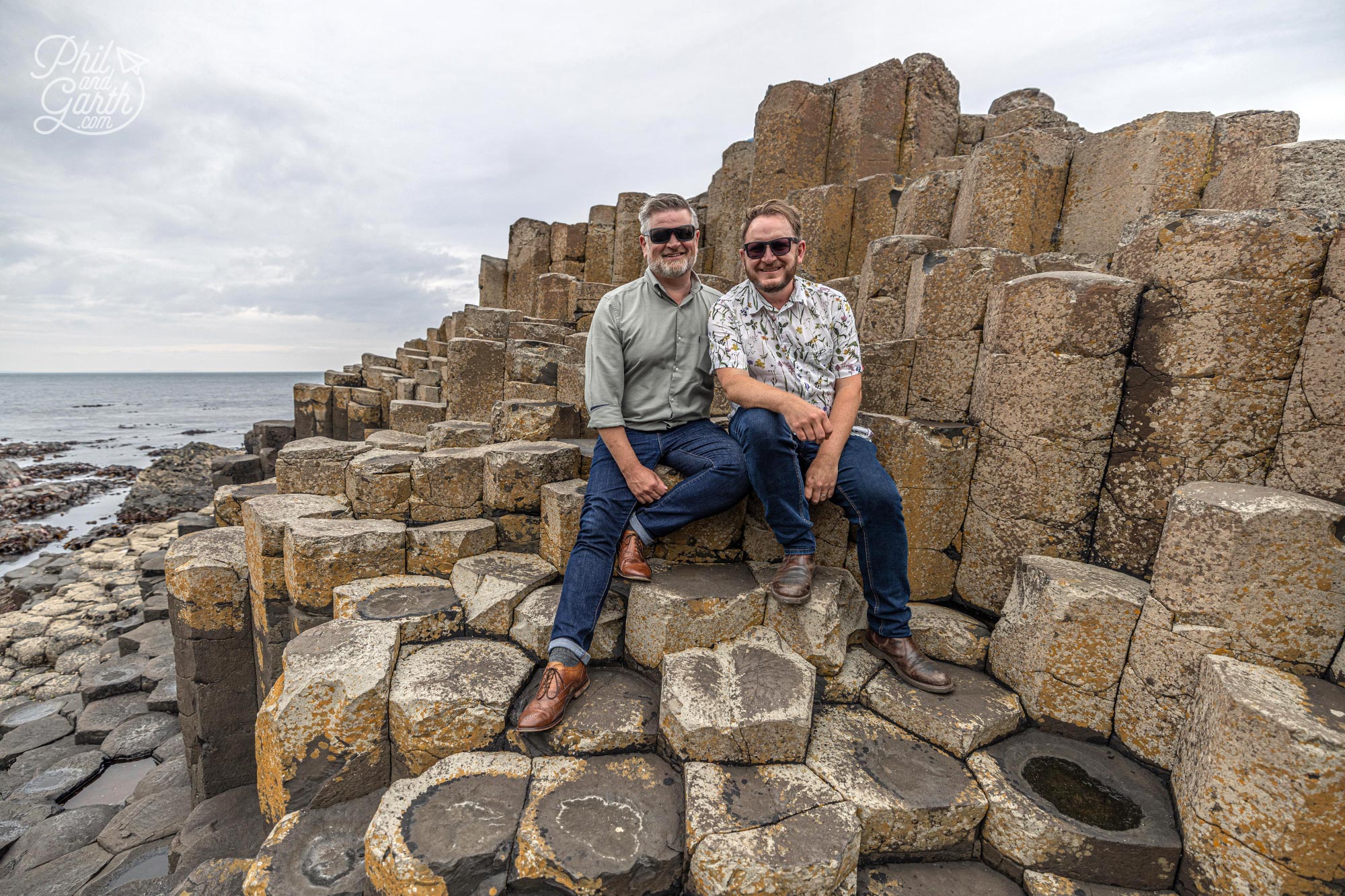
Sitting on 50+ million year old volcanic rock
Dunluce Castle
The final stop on the tour was a short drive from the Giant’s Causeway for a quick photo stop of Dunluce Castle. It’s one of Ireland’s most picturesque and romantic castles. It is a sight to see, perched high on a headland dropping down to the sea. The ruins you see today date back to the 16th and 17th centuries. Exterior shots of Dunluce were used in Game of Thrones as Greyjoys’ Pyke Castle.
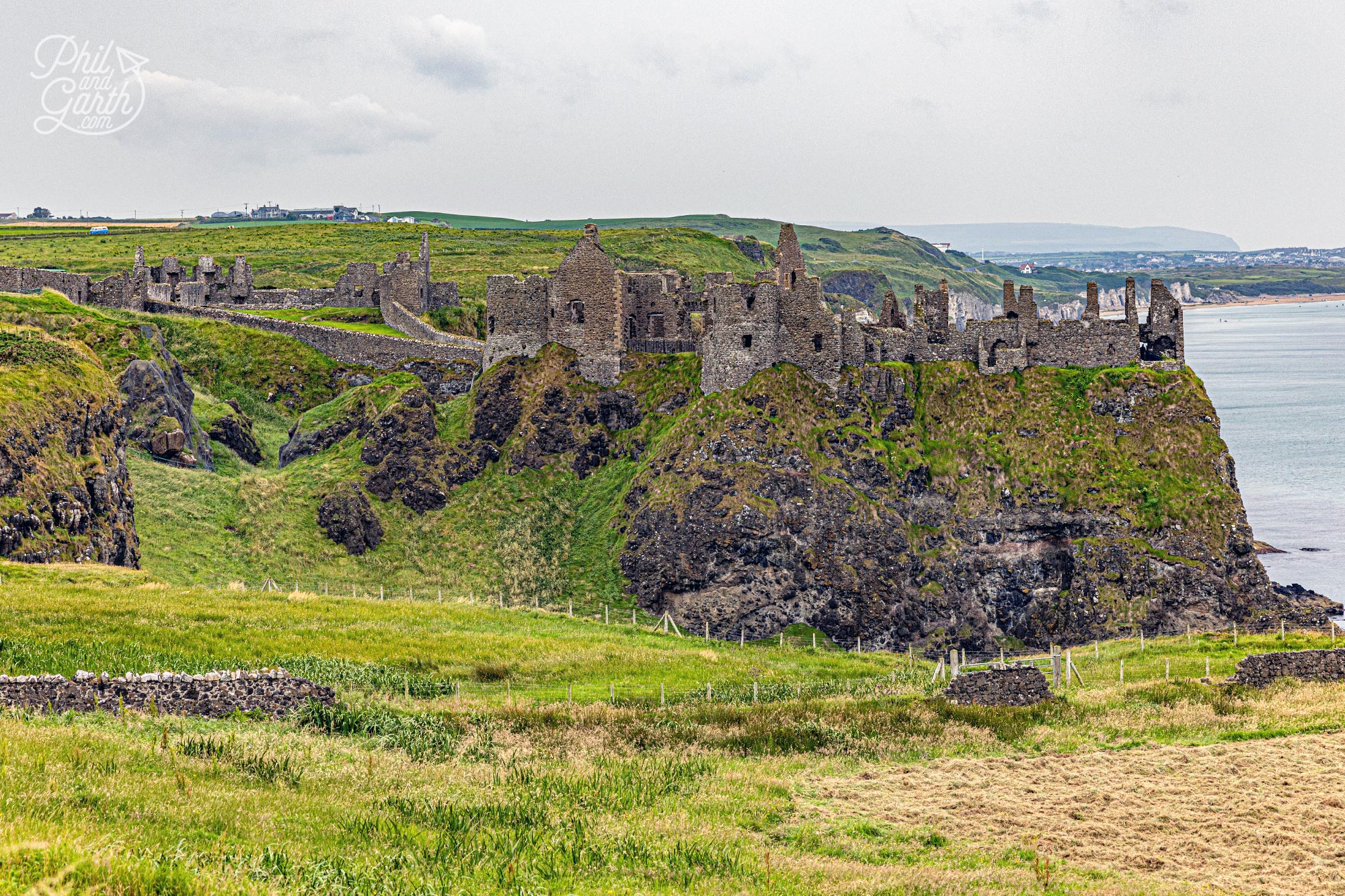
The medieval Dunluce Castle dates back to 1500
After Dunluce Castle, it’s a non-stop drive back to Belfast on the motorway which takes 1 hour 15 minutes.
Cathedral Quarter
After the coach tour, we had a quick spruce up at the hotel and then spent the evening at the Cathedral Quarter which is best known for its bars and restaurants. We loved the fabulous rainbow-coloured umbrellas above Commercial Court.
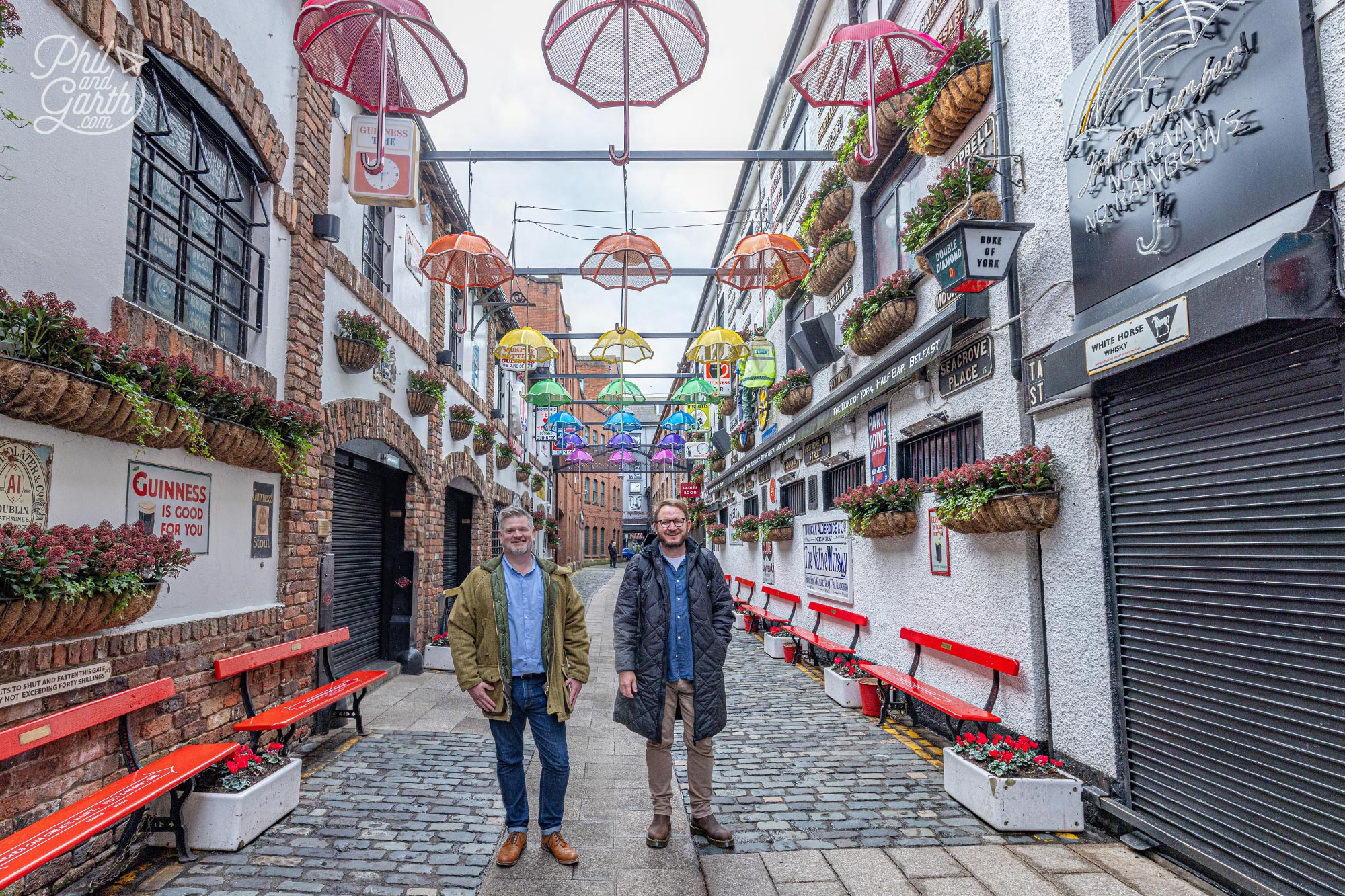
The rainbow umbrellas above Commercial Court
Day 3 – Belfast Itinerary
Belfast Black Cab Tour
It’s the final day of our Belfast 3-day itinerary and we start with a black taxi tour of “The Troubles” – 30 years of conflict and violence in Belfast. We both vividly remember growing up as kids watching TV news bulletins about the troubles but never really fully understood it. So we booked BlackTaxiTours to learn more about the political history of Belfast between the Catholic and Protestant communities.
Putting it simply politics in Northern Ireland has been dominated for years by the issue of separation or union with the United Kingdom or the Republic of Ireland. This split follows religious beliefs. Roman Catholics identify as Irish and believe in a united Ireland free from British control and are known as nationalists or republicans. Whilst Protestants identify as British and believe in a union with the UK, they are known as unionists or loyalists. These differences created a deep cultural divide. Violence spread in the late 60s with the involvement of the Irish Republican Army (IRA) on the Catholic side and the Ulster Defence Force (UDF) on the Protestant side.
Our guide and driver was Brendan who was very knowledgeable about all aspects of The Troubles and told the story in a sensitive, emotive, and engaging way. With some funny stories at times and keen to answer our questions, which we had a lot of! This is a gritty tour, yes it’s disturbing at times, but it’s an unmissable tour of Belfast. Brendan illustrated it with photos from the era as we arrived at different locations and showed us things like rubber and plastic bullets which were much larger than we thought, we were both quite shocked.
We started the tour on the Falls Road, where the Catholic community lives. It’s an area, not a road, 7 miles long with various housing estates. Brendan seemed to know so many people often waving at fellow cabbies and people from his cab window. We stopped at the political murals which depict various families seeking inquests and other murals showing allies like Cuba and Palestine. We also witnessed a demonstration by families who are seeking inquests into the killings of their family members – they protest every year.
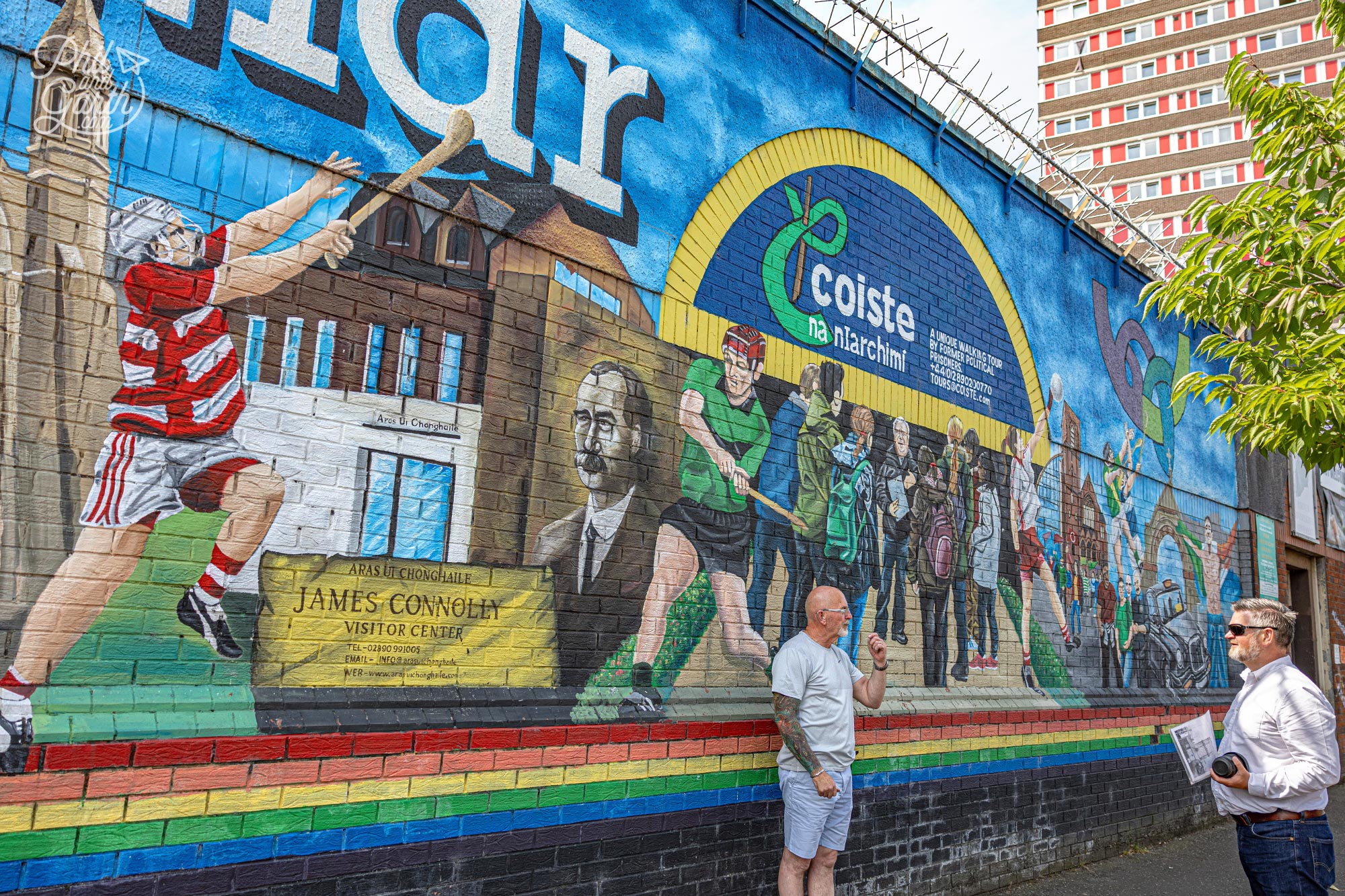
Our guide Brendan explains the meaning behind the murals
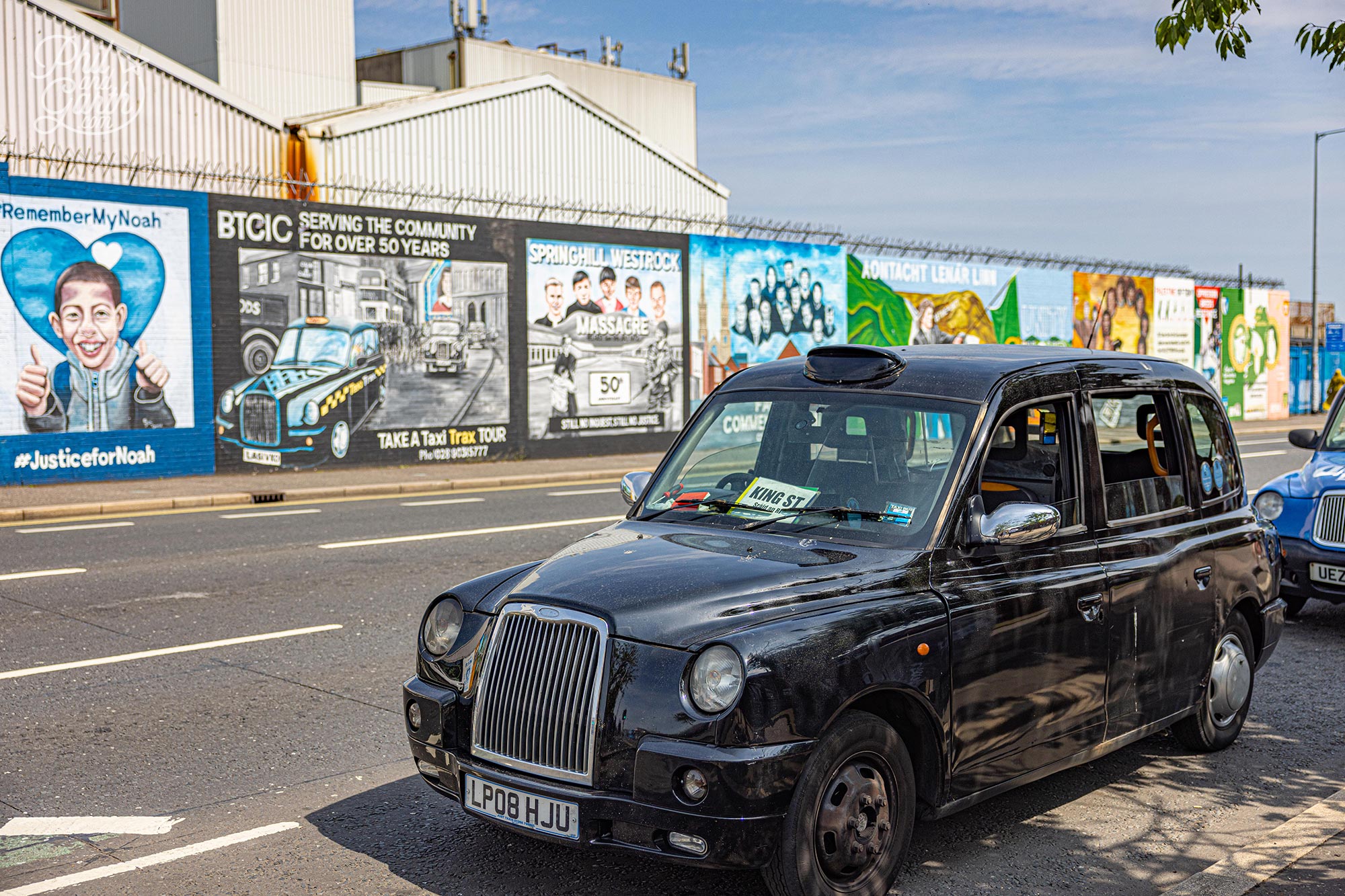
Political murals on the Falls Road
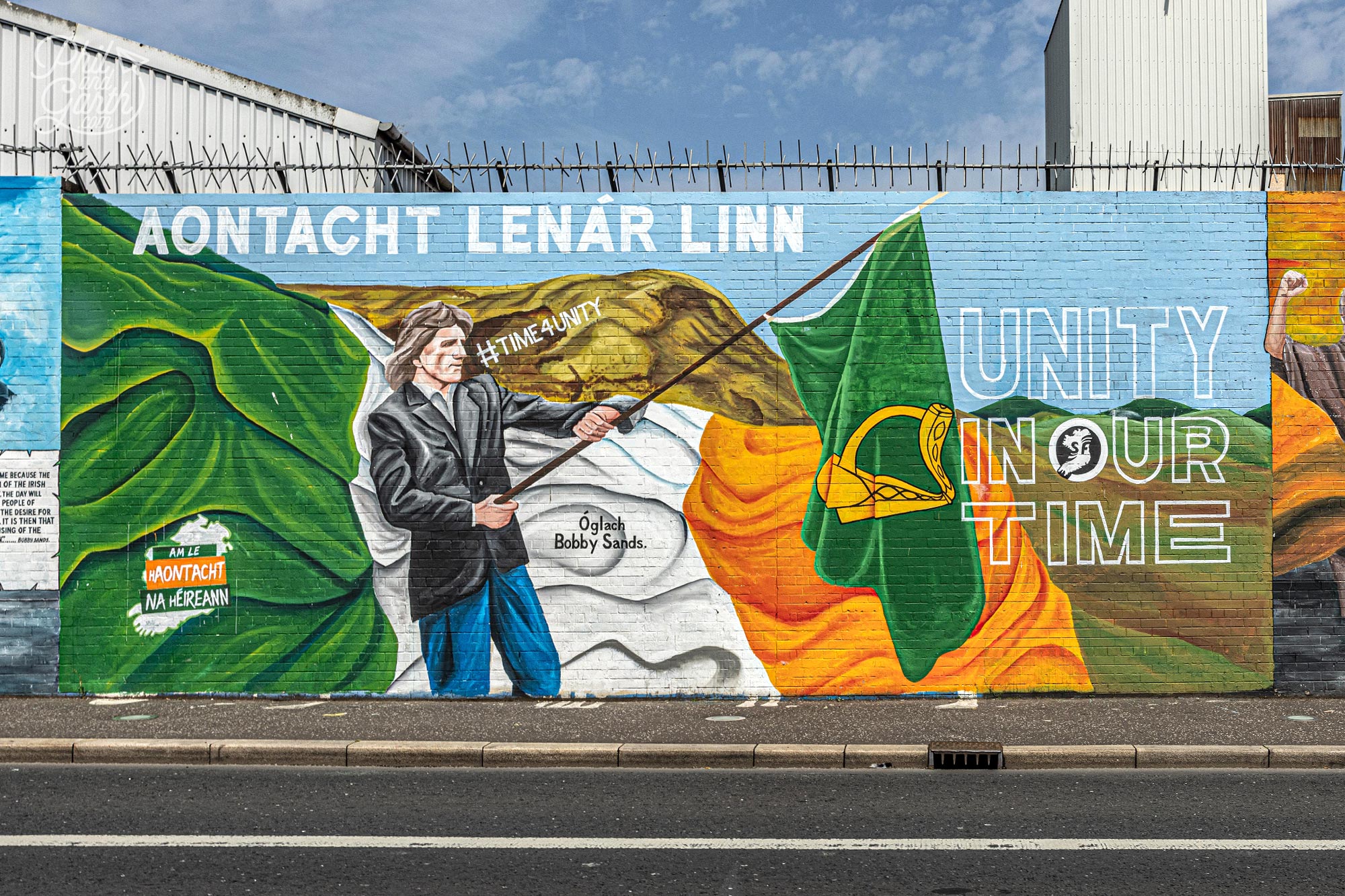
Mural on the Falls Road
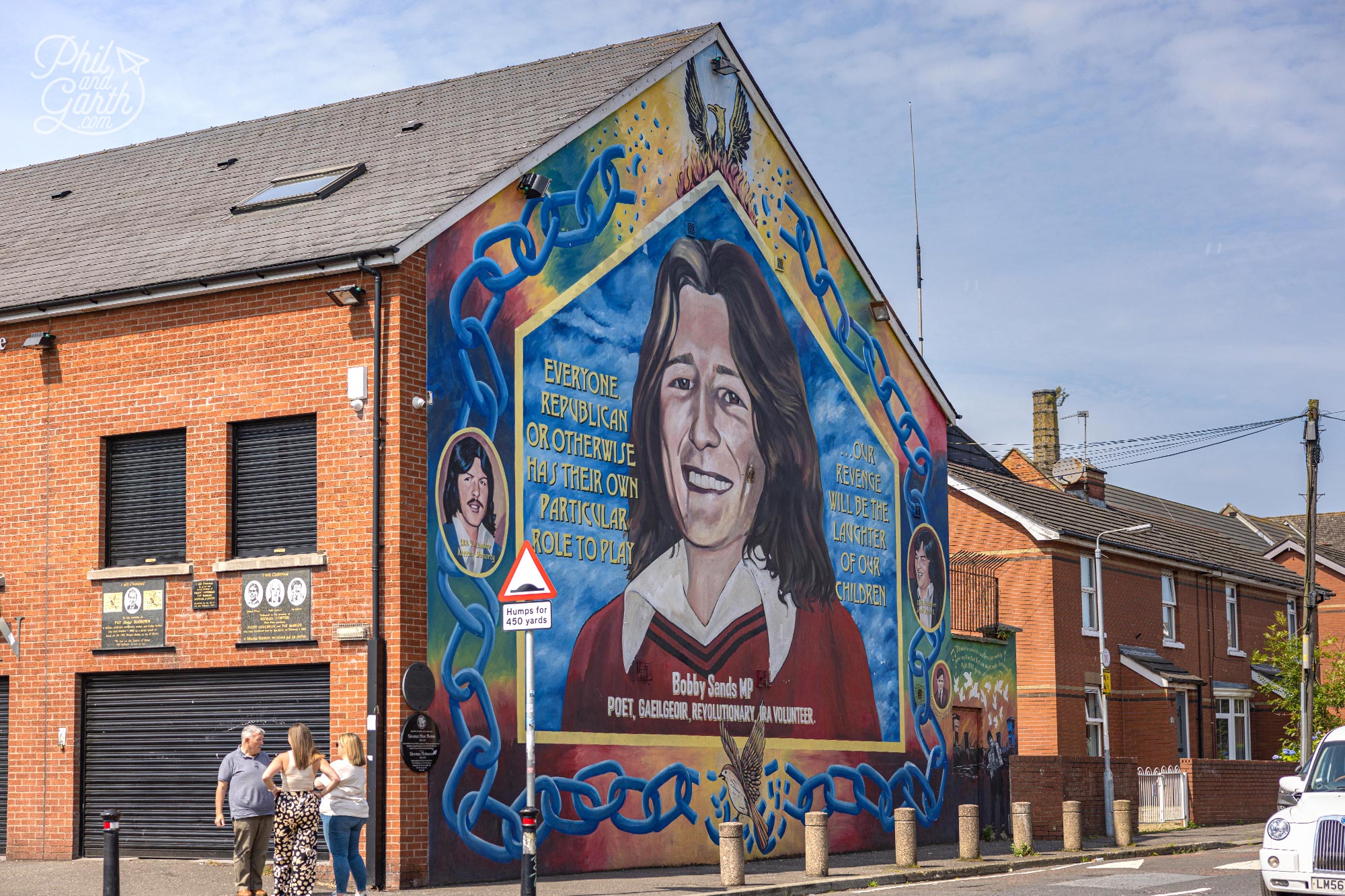
Bobby Sands mural on the Sinn Fein offices
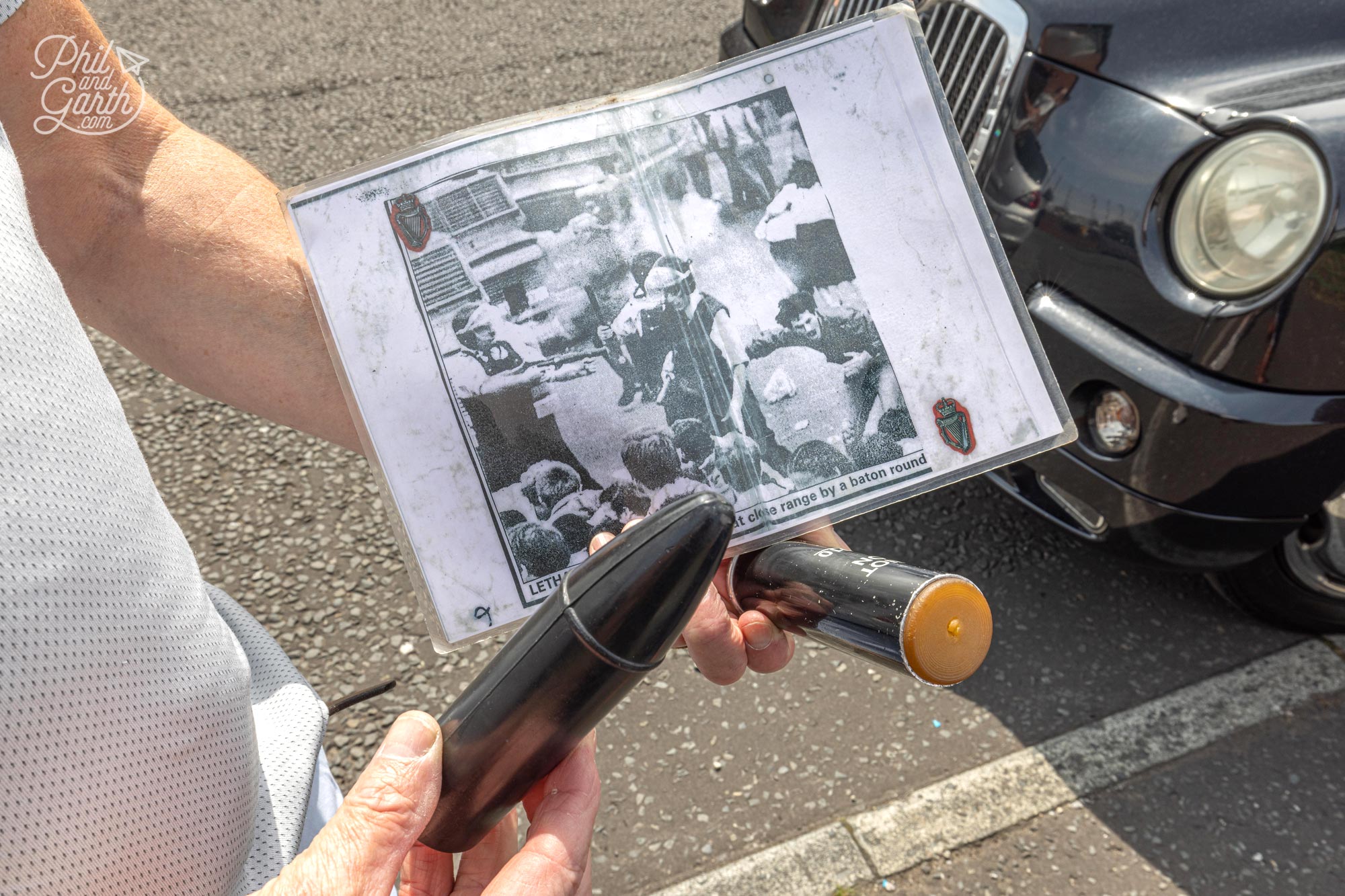
Our guide Brendan shocked us with the size of plastic and rubber bullets
The next stop on our black cab tour was a visit to the Clonard Martyrs Memorial Garden. There are many of these memorials in the Falls Road area, usually right next to where the families live in residential streets. Right next to this memorial are homes with giant cages that cover their back gardens to prevent bricks and stones being thrown over the Peace Wall that back onto them.
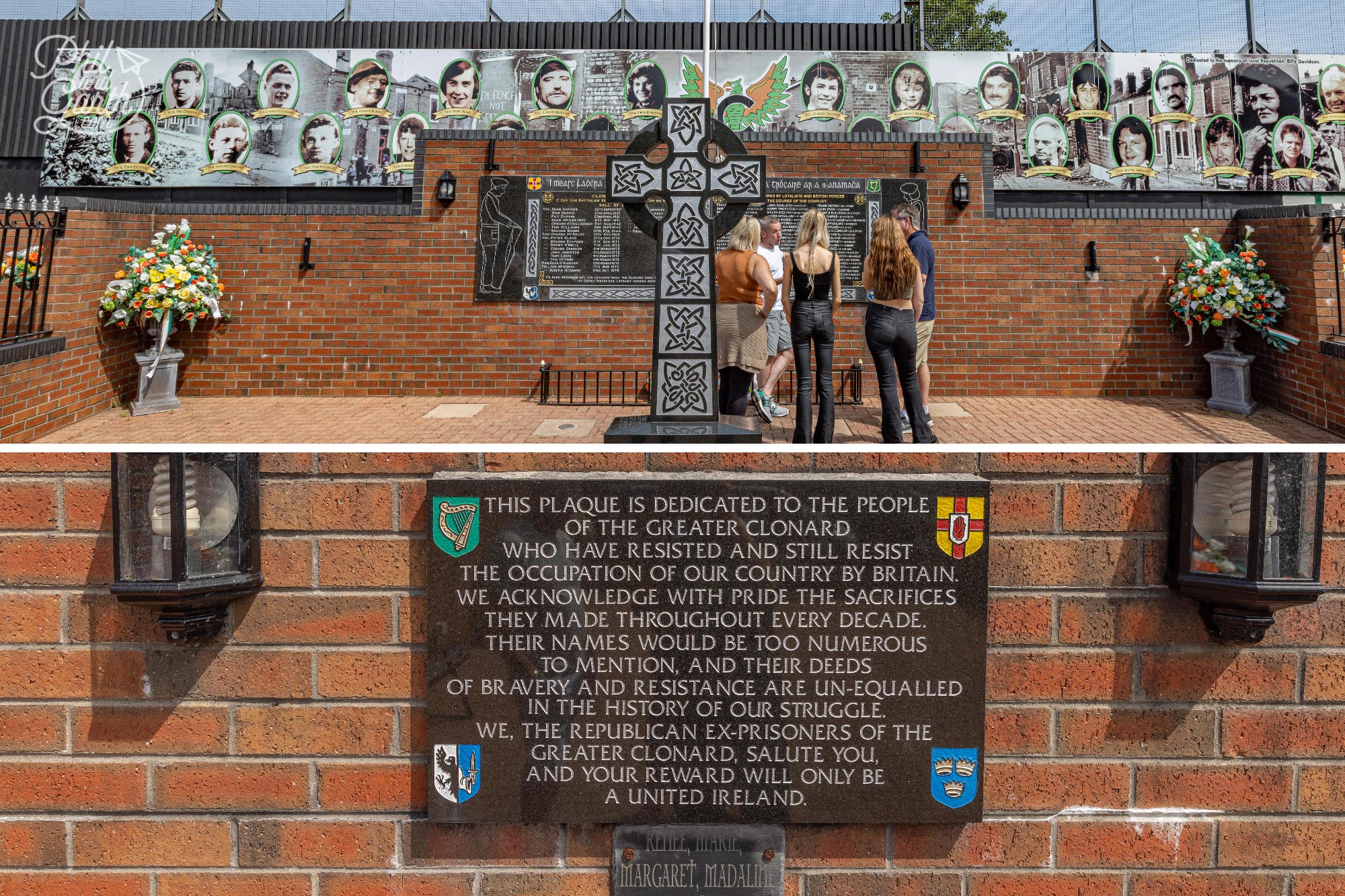
Clonard Martyrs Memorial Garden
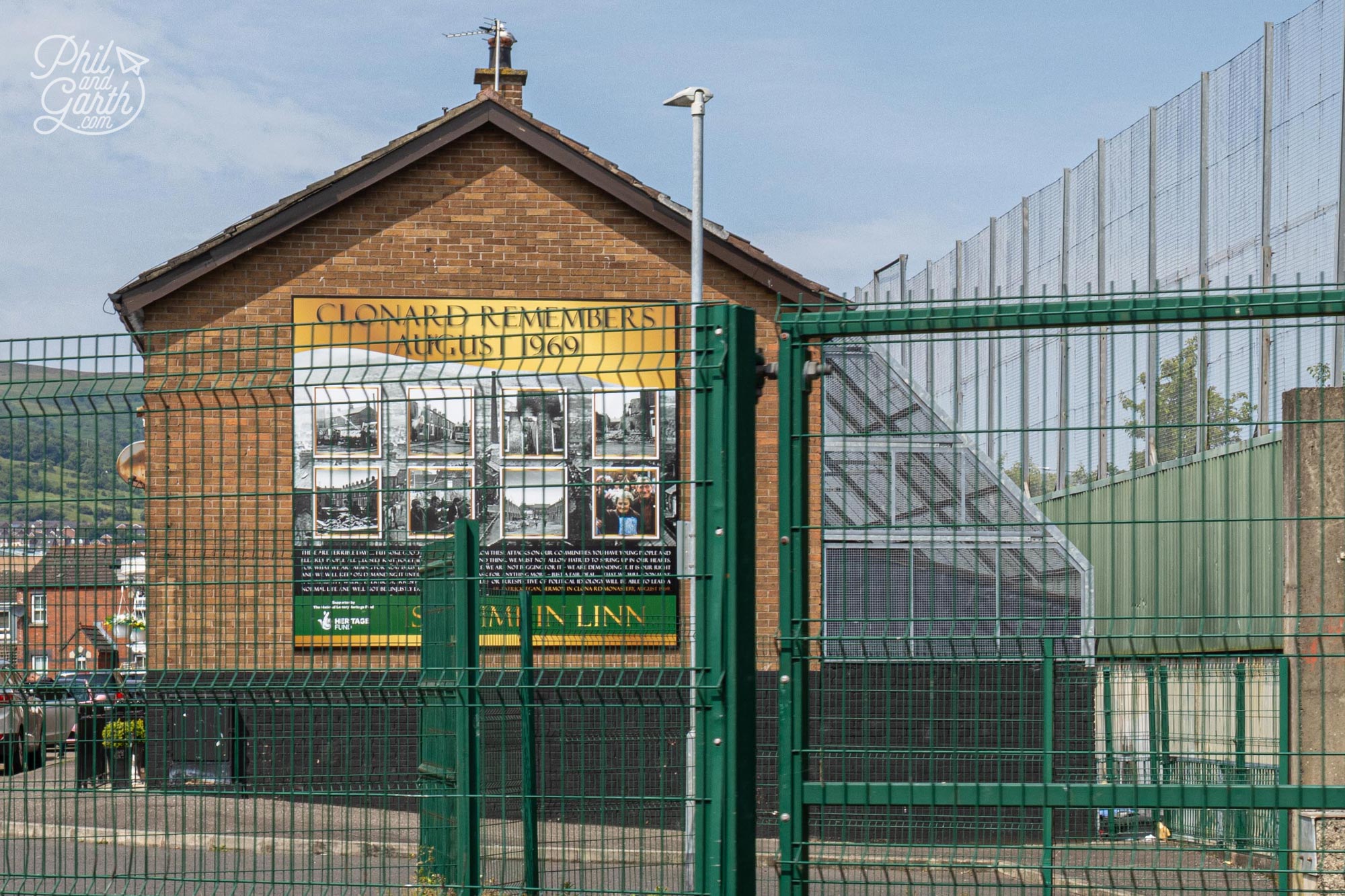
Catholic family homes are protected by cages that back onto the Peace Wall
Next, it was onto the Shankill Road home to the Protestant community. We passed through a gate that opens at 6am and closes at 6pm. This was by far our biggest surprise, we had no idea there were still gated entrances with curfews. After a short drive, we arrived at the Peace Walls, we both knew about them but had no idea how massive they are. They literally divide the Catholic (Republican) neighbourhood from the Protestant (Loyalist) community. We were also shocked at the small rocks and bricks on the pavement that are still thrown across the wall. It’s sad how the Catholics and Protestants lead mostly separate lives.
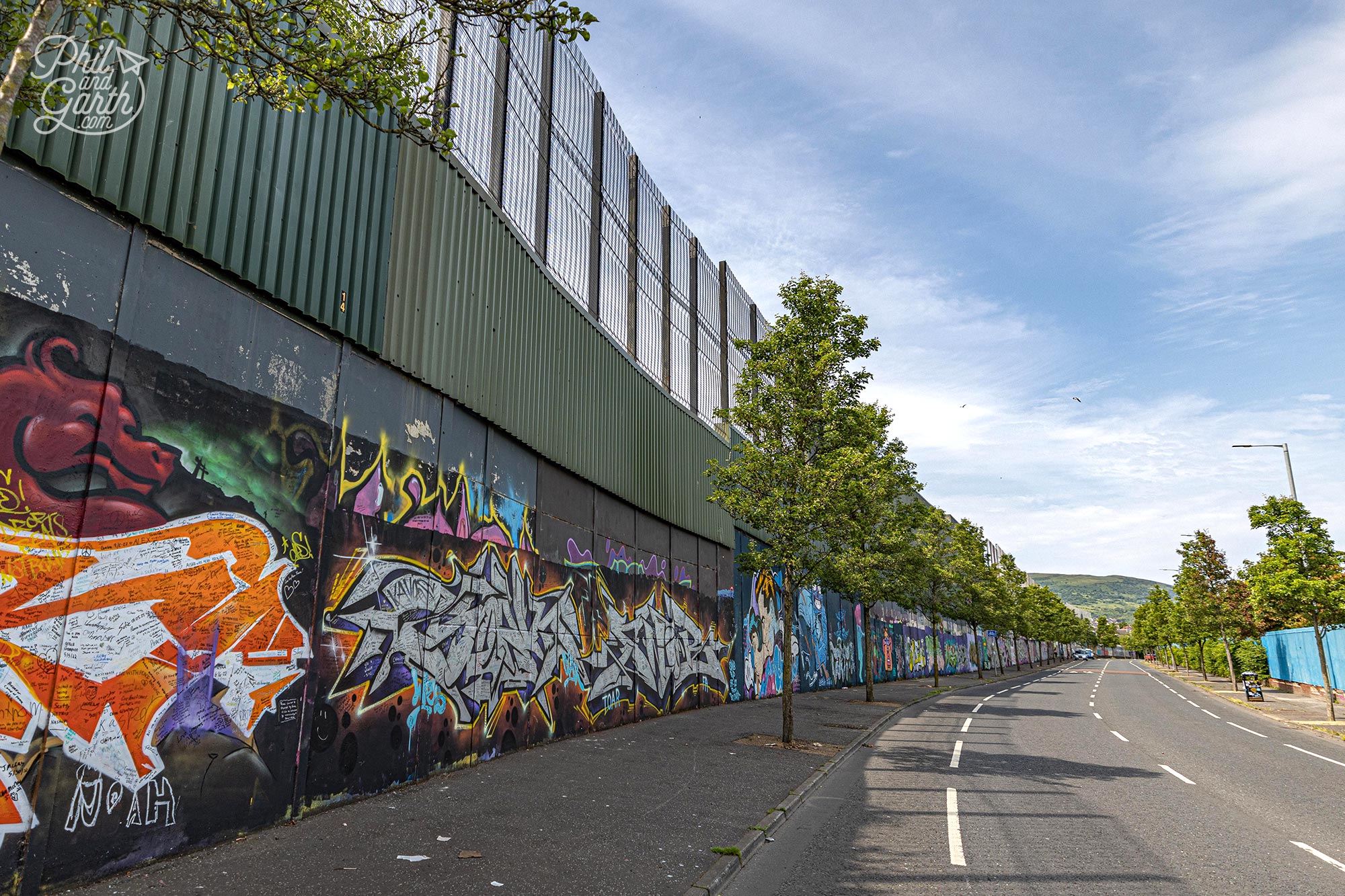
Belfast’s Peace Walls divide the Catholic and Protestant communities
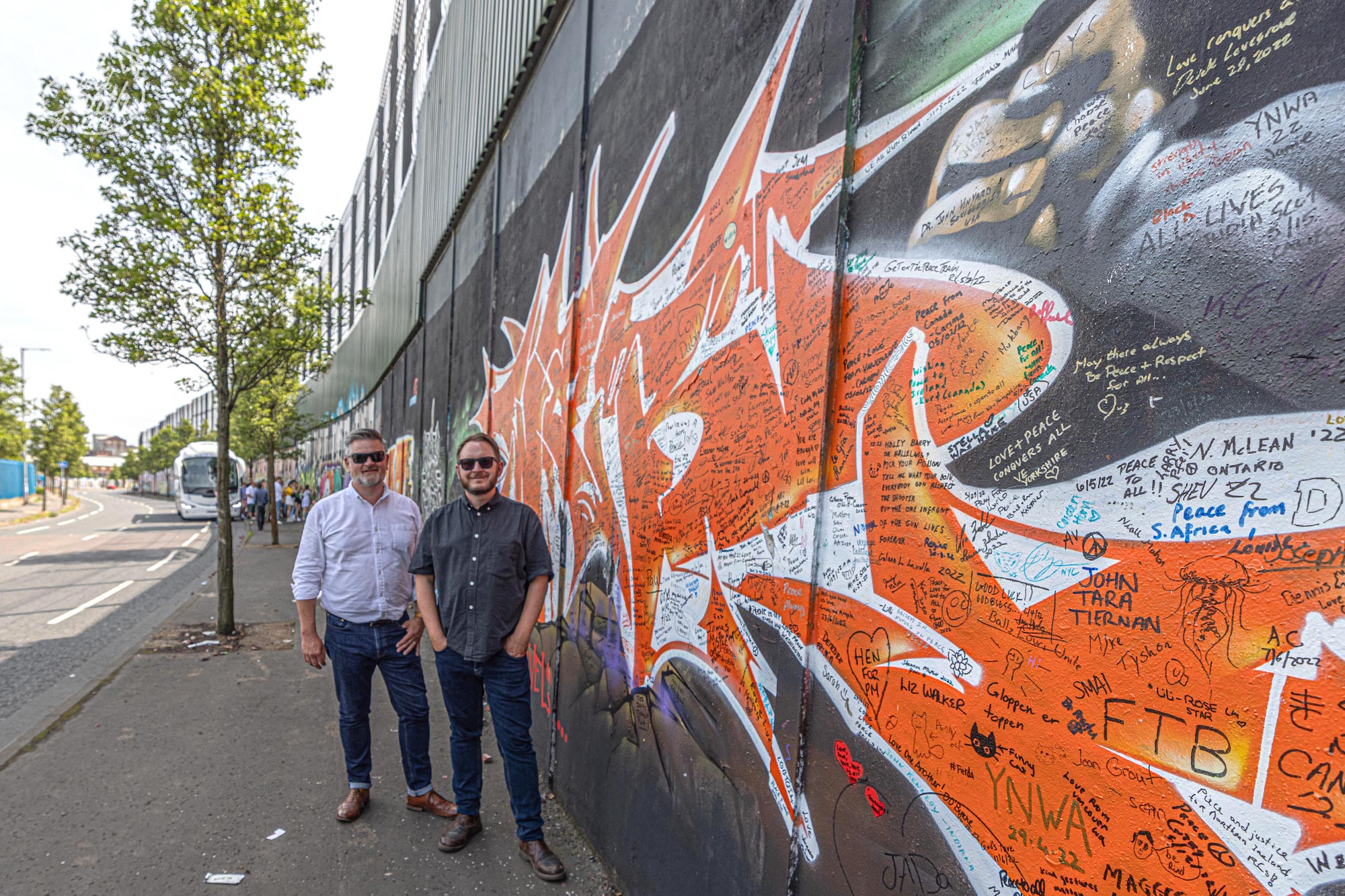
We signed Belfast’s peace wall
Brendan stopped at the wall and gave us the opportunity to write our own message. It’s covered in murals, signatures, and messages of hope. Brendan told us many famous people have signed the wall including US President Bill Clinton and the Dalai Lama.
Next, it was on to see more of Belfast’s famous political murals, this time artworks on the Protestant side passing many homes covered in union flags, we thought there must be more flags here than on the streets of England.
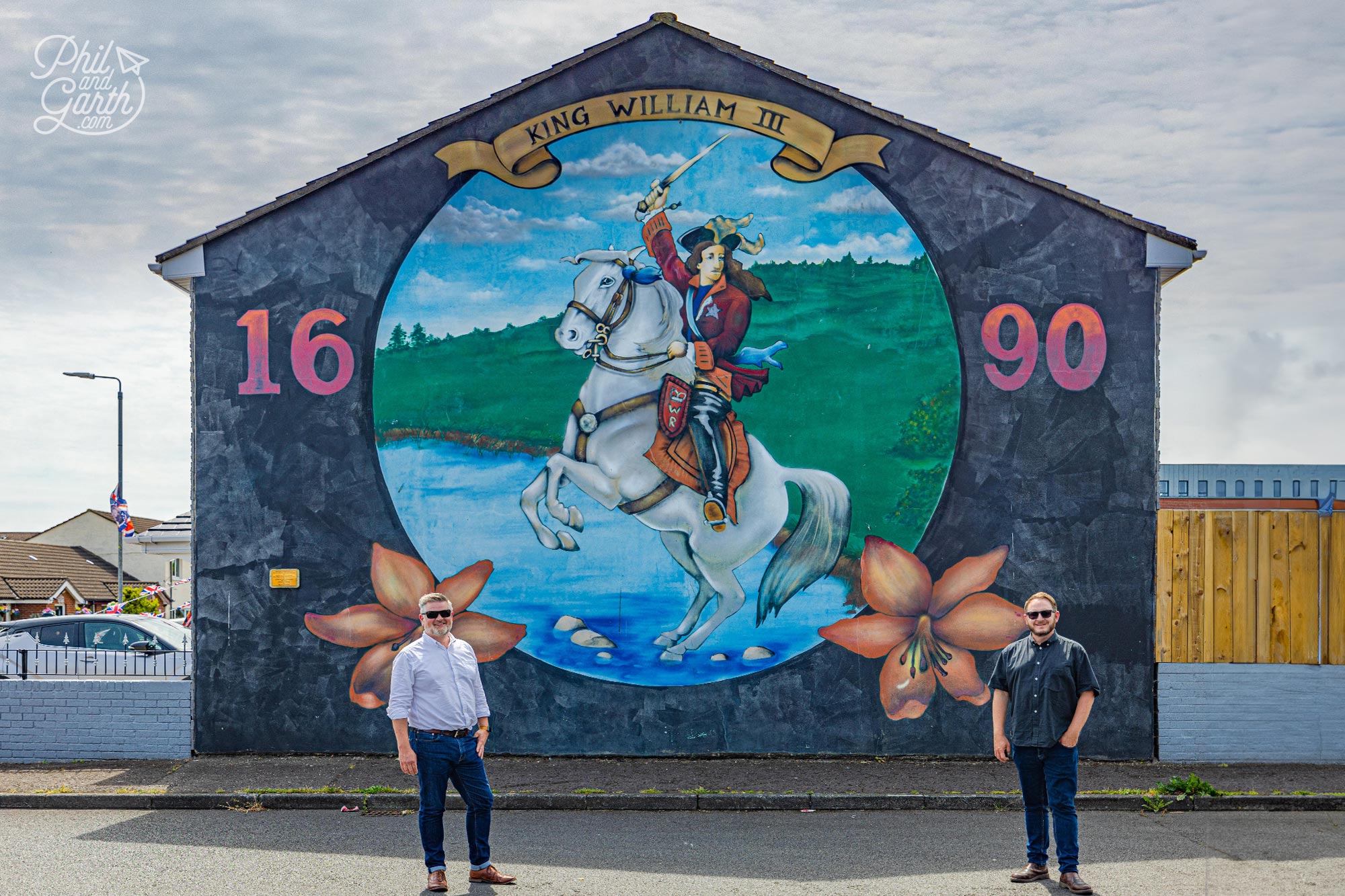
A Protestant mural celebrating King William III
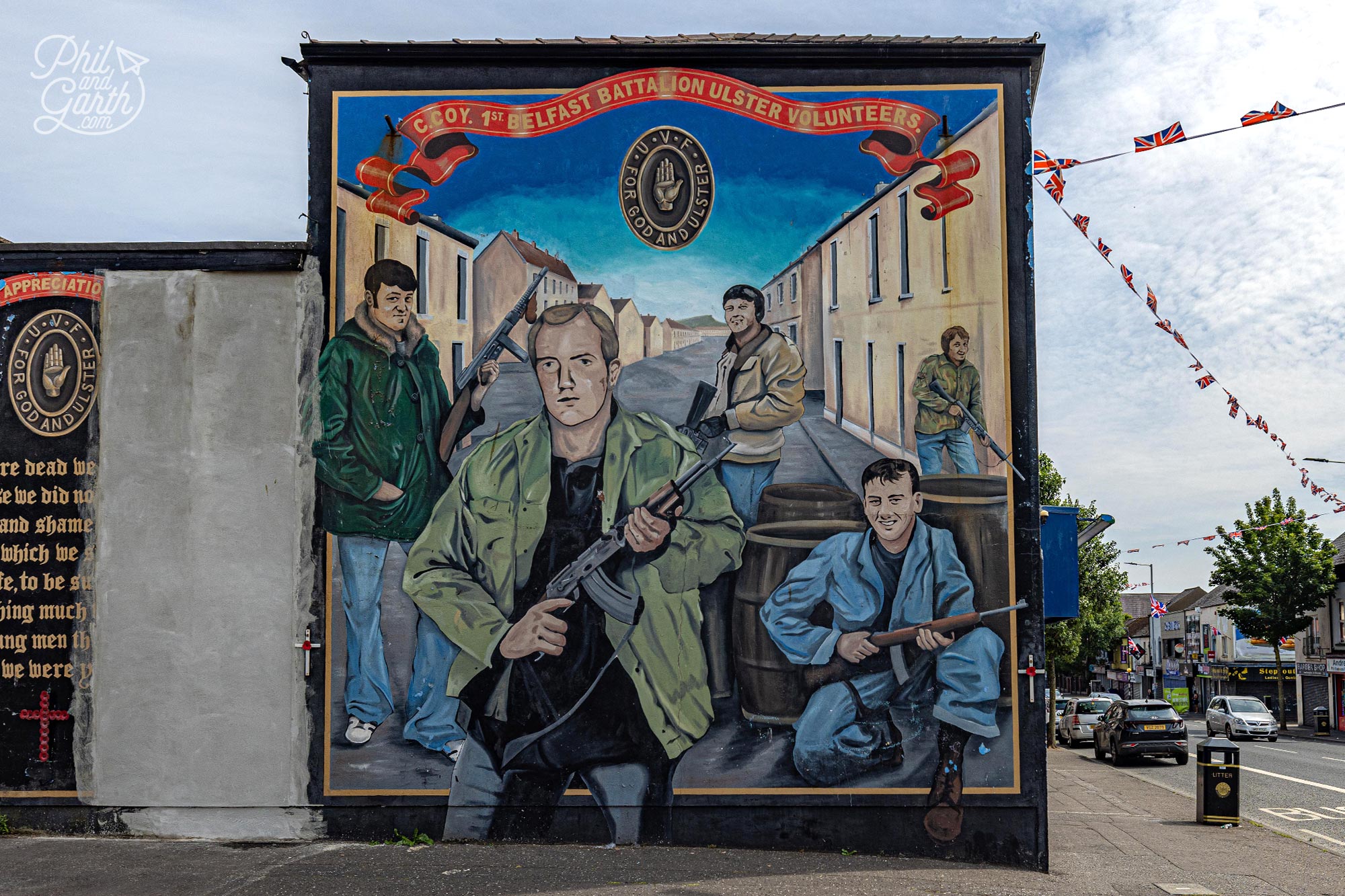
A Unionist pro-British mural and memorial to remember 5 fallen UVF members
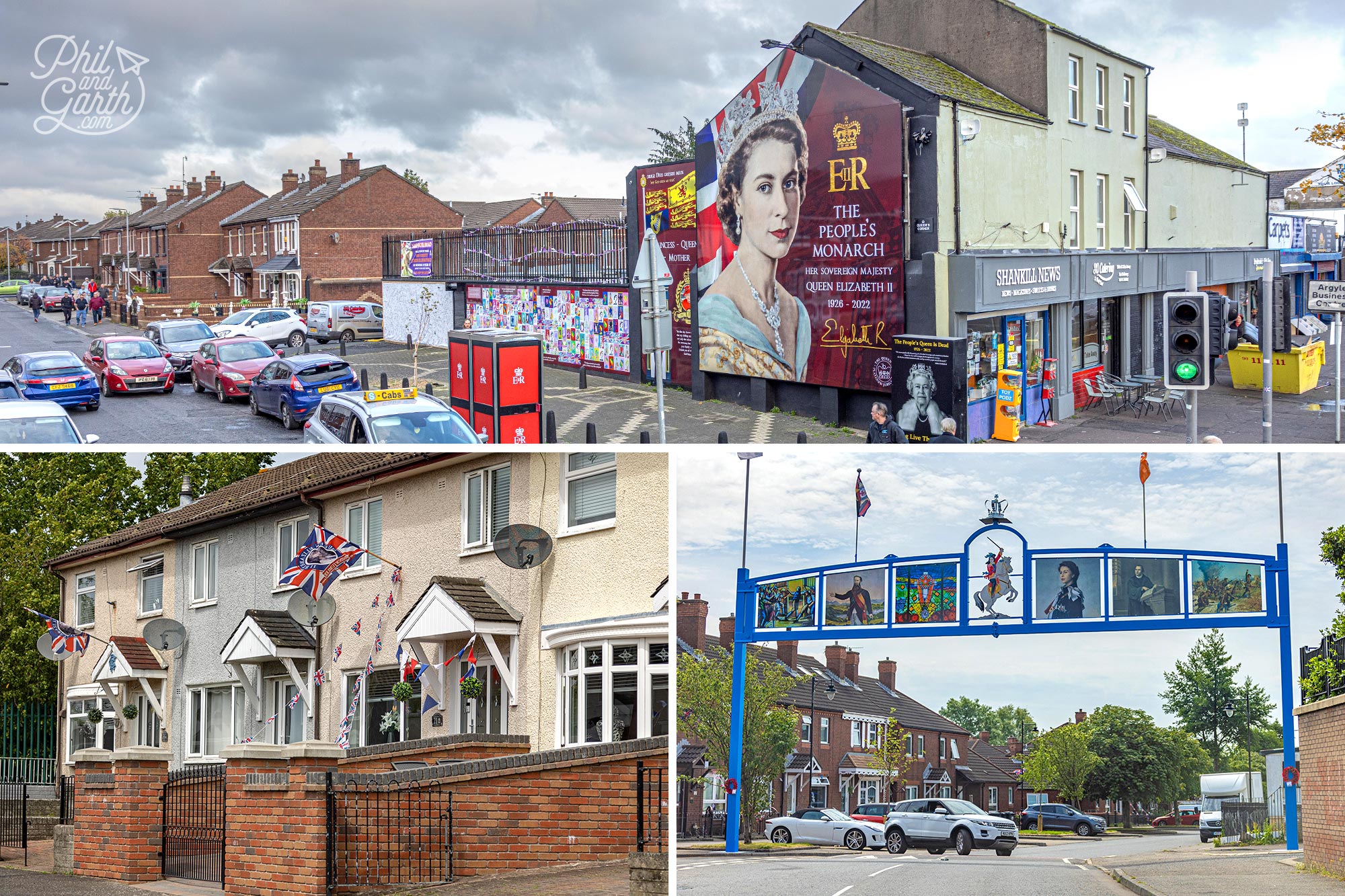
So many homes are decorated in union flags
Brendan’s last stop was at the monastery where the Good Friday Agreement began. It was started by a local priest who initiated a dialogue with both sides and then brought in politicians from the USA, Ireland, and the UK. Brendan said people in Belfast were tired of the violence and everyone just wanted peace, on April 10, 1998, that wish was achieved. Such an interesting tour, whist you might think it’s all a bit grim, it kinda is, but it’s something we can highly recommend doing.
Belfast City Hall
After the political tour head back to the city centre for some lunch and walk around the grounds of the Belfast City Hall or go inside for a free 45-minute guided tour if you’ve got time. It was built in 1906 to celebrate Belfast being awarded city status by Queen Victoria in 1888. The magnificent exterior is Baroque Revival style, constructed in Portland stone. Inside are portraits, a grand staircase, Irish oak paneling, and a visitor exhibition showcasing the city’s history to the present day. Tours run Monday to Friday at 11am, 2pm, 3pm and 4pm. Saturday and Sunday at 12 noon, 2pm, 3pm and 4pm.
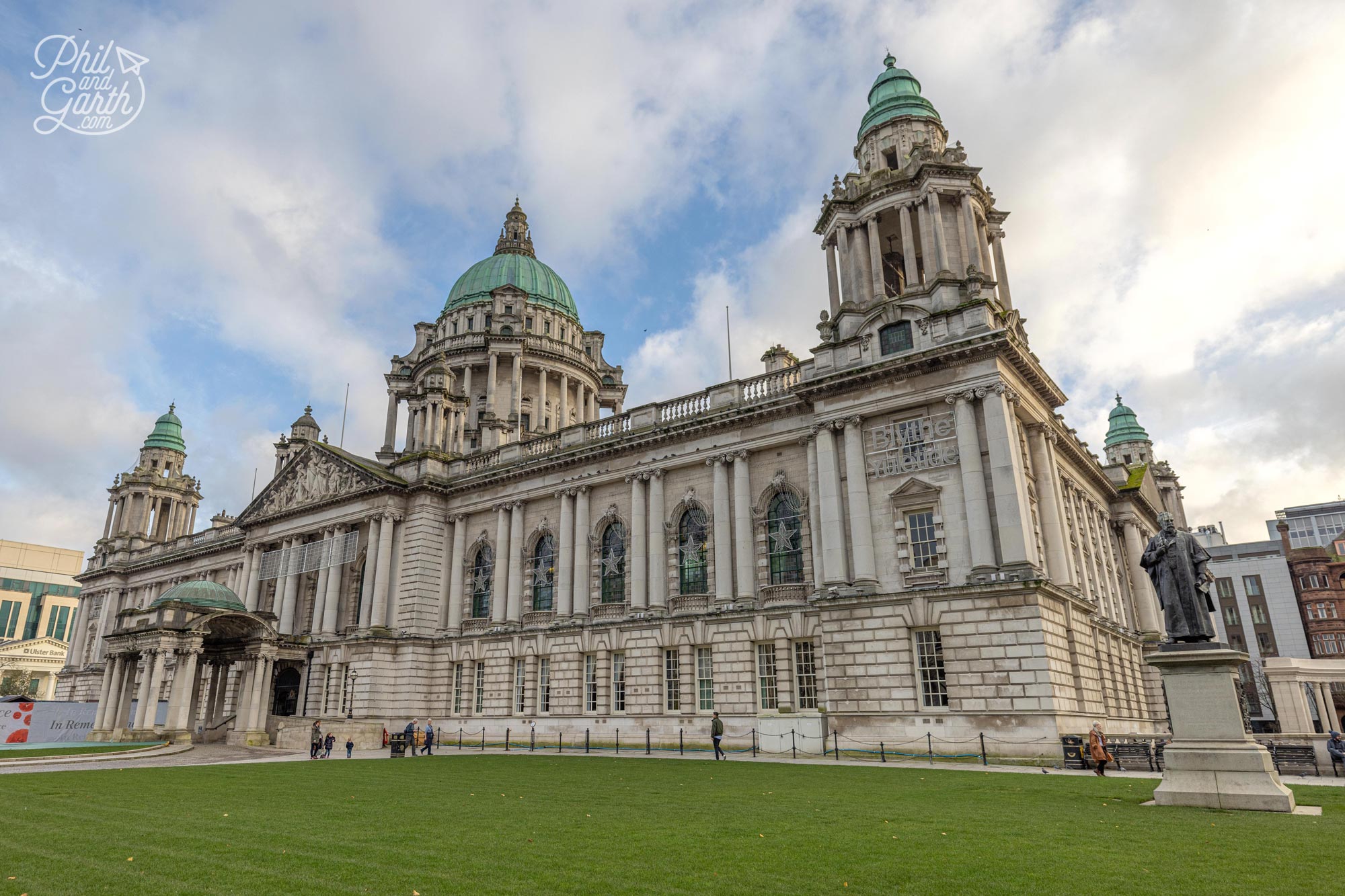
Belfast City Hall opened its doors in 1906
Waterfront & Sculptures
Go for a walk along the waterfront and check out two of Belfast’s notable art installations – The Big Fish and the Beacon of Hope.
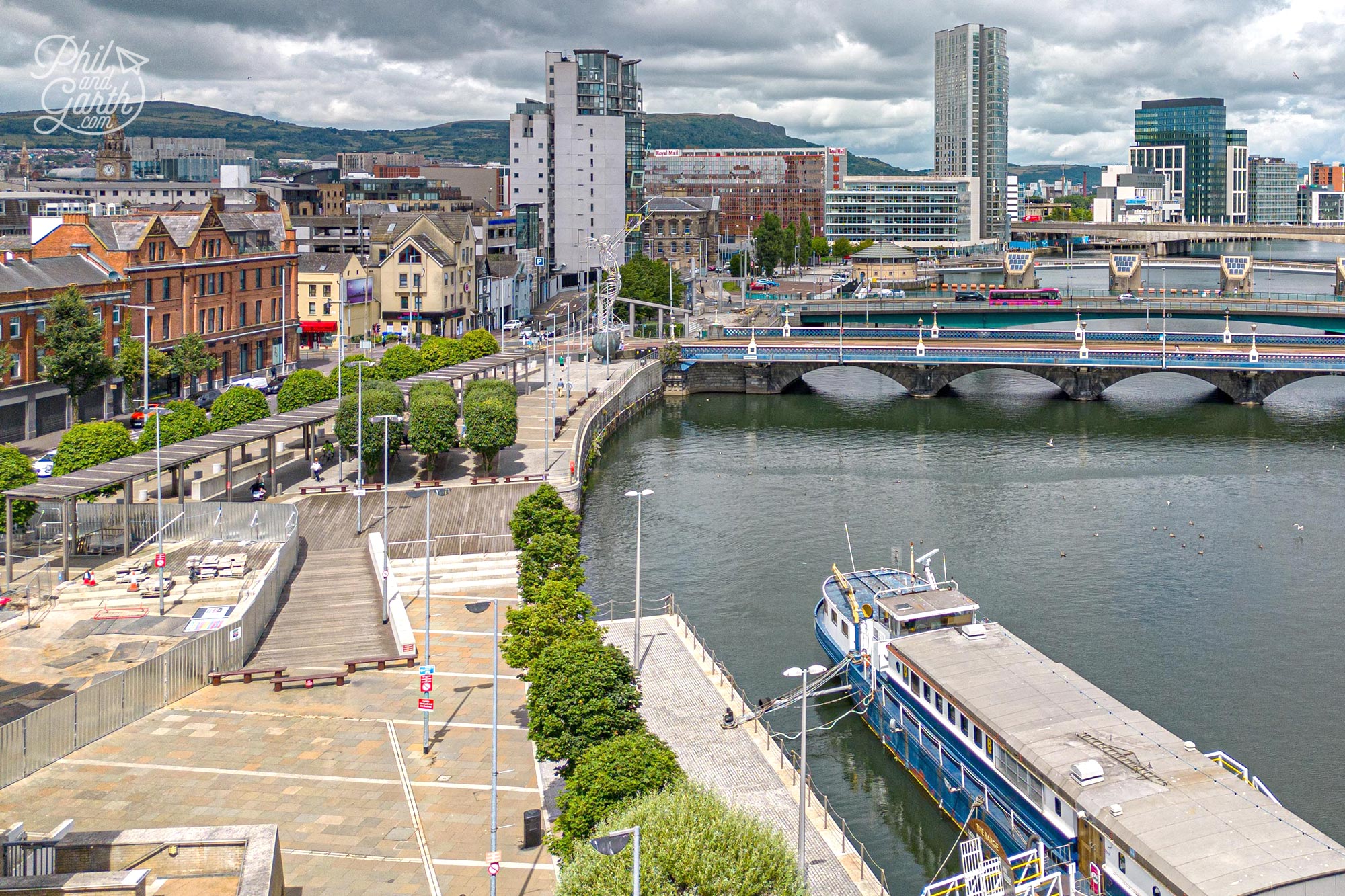
Wander down Belfast’s waterfront to see sculptures like the Big Fish
The Big Fish also called the ‘Salmon of Knowledge’ is made up of ceramic tiles depicting scenes from Belfast’s history in text and images. This clever mosaic really does look like fish scales. Apparently, if you kiss the salmon you’ll gain all of its wisdom!
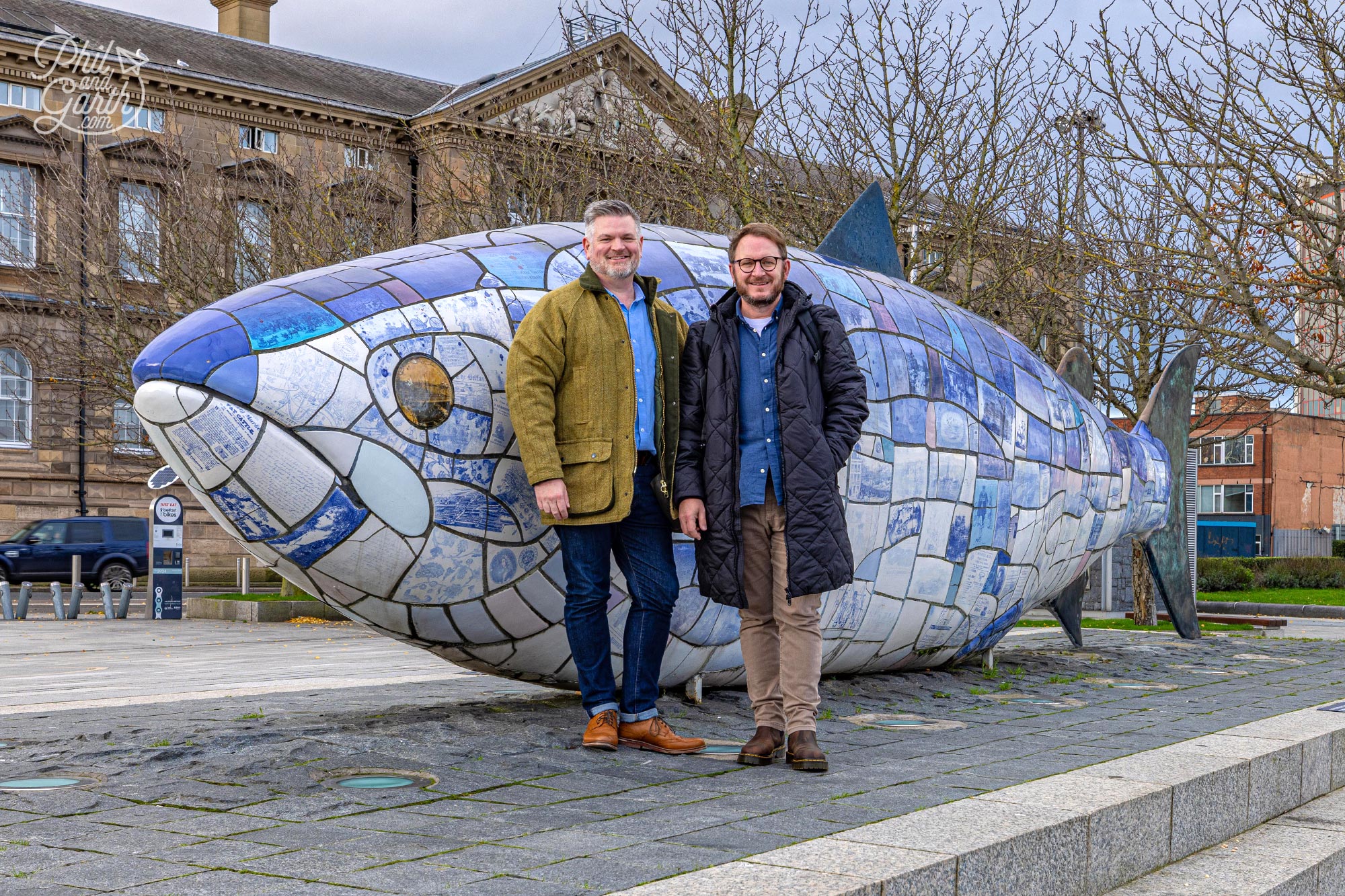
The Big Fish also known as The Salmon of Knowledge
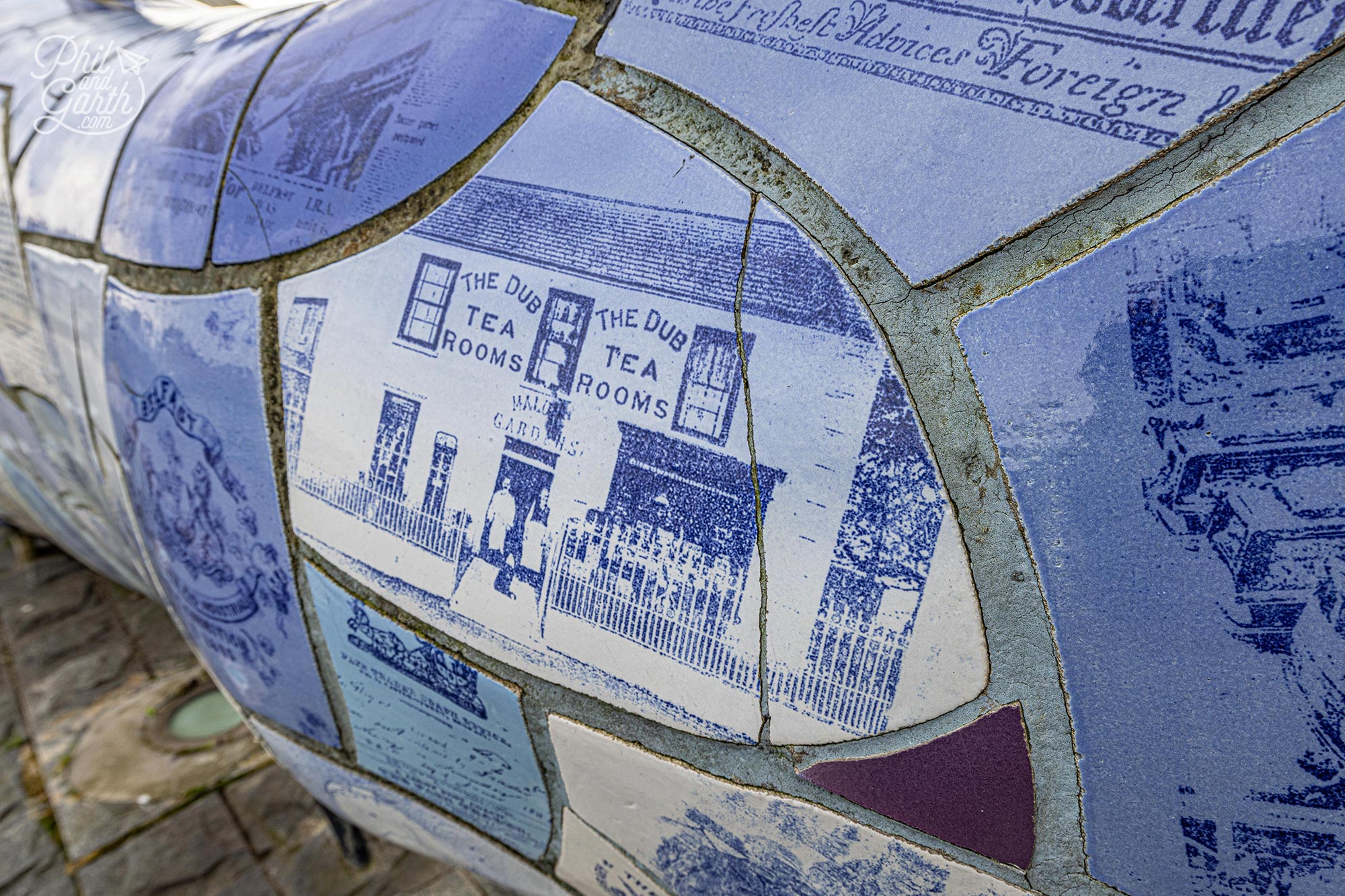
The tiles show images and text of Belfast’s history
The Beacon of Hope also known as ‘Nuala with the Hula’ is really big! standing at 19.5 metres tall. She’s made from stainless steel tubes and holds up a circular ring which represents thanksgiving. She also stands on a globe of the world that represents peace and harmony. Certain cities are highlighted on the globe that Belfast exported ships and linen to.
The Beacon of Hope is known locally as ‘Nuala with the Hula’
Belfast Street Art
If you’re into street art like Garth, then you’ll love Belfast’s thriving street art scene. Belfast has had a long tradition of political murals, but this is a new narrative of images by artists from all over the world who are leaving their mark on Belfast.
We just wandered around the edge of the Cathedral Quarter where most of the street art is based. It’s the creative and artistic area of Belfast. You can download a free Belfast street art map or book a 2-hour walking tour that starts at 12 noon on Sundays from Seedhead Arts.
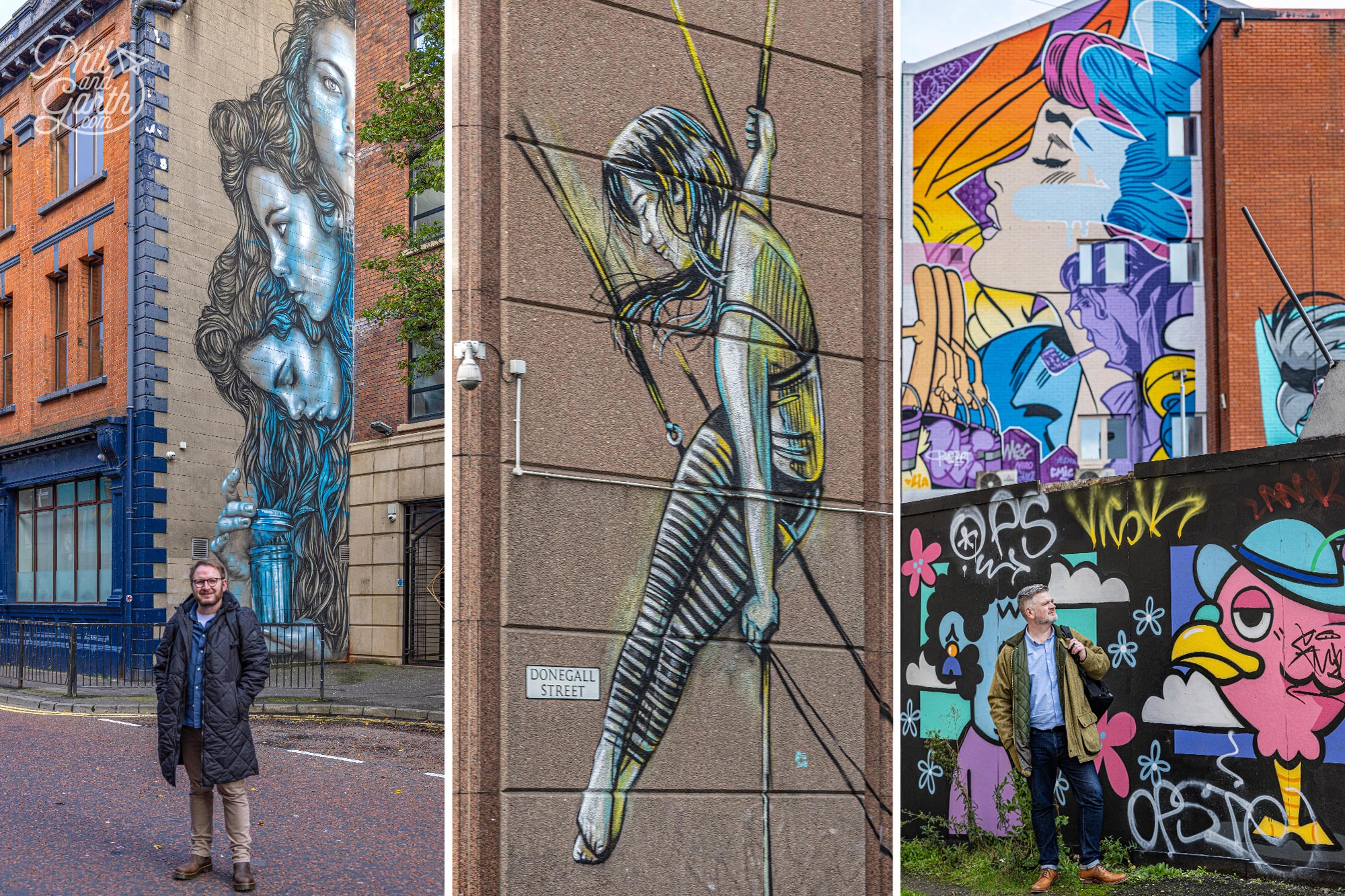
Left image -Pandora’s box by Christina Angelina, Middle image – Acrobat by Alice Pasqunini
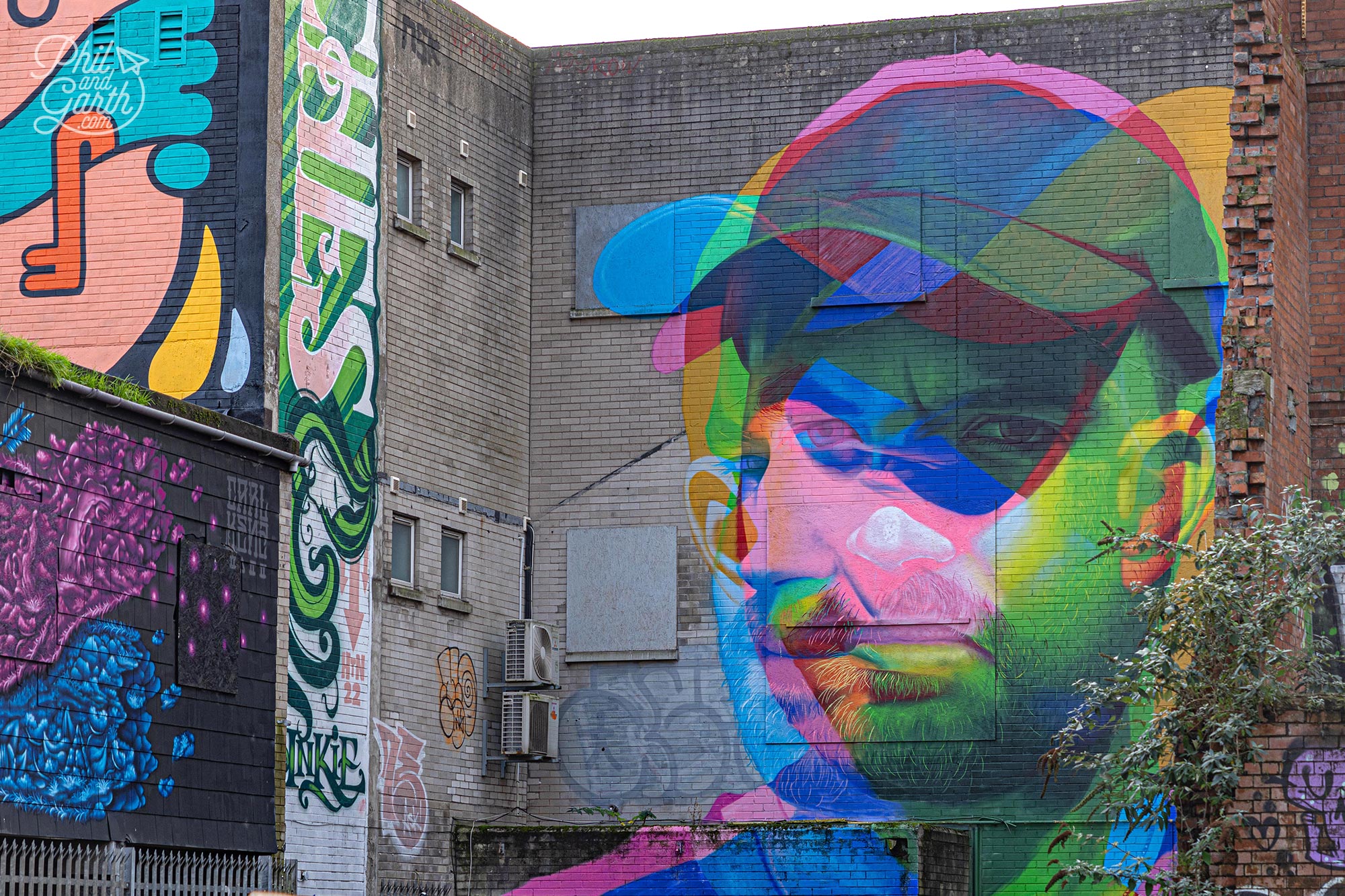
Belfast has a vibrant, contemporary street art scene
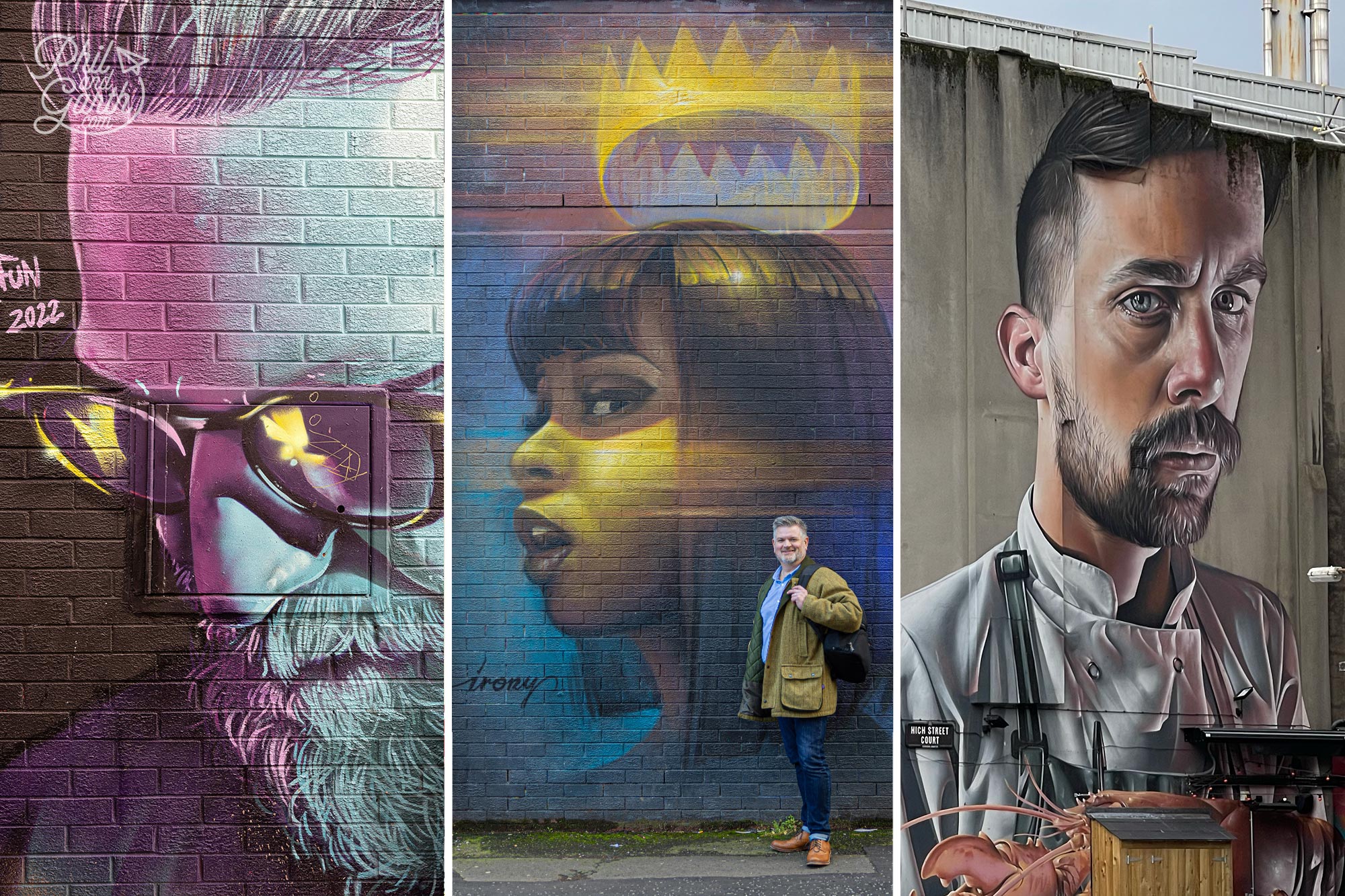
So many brilliant artworks
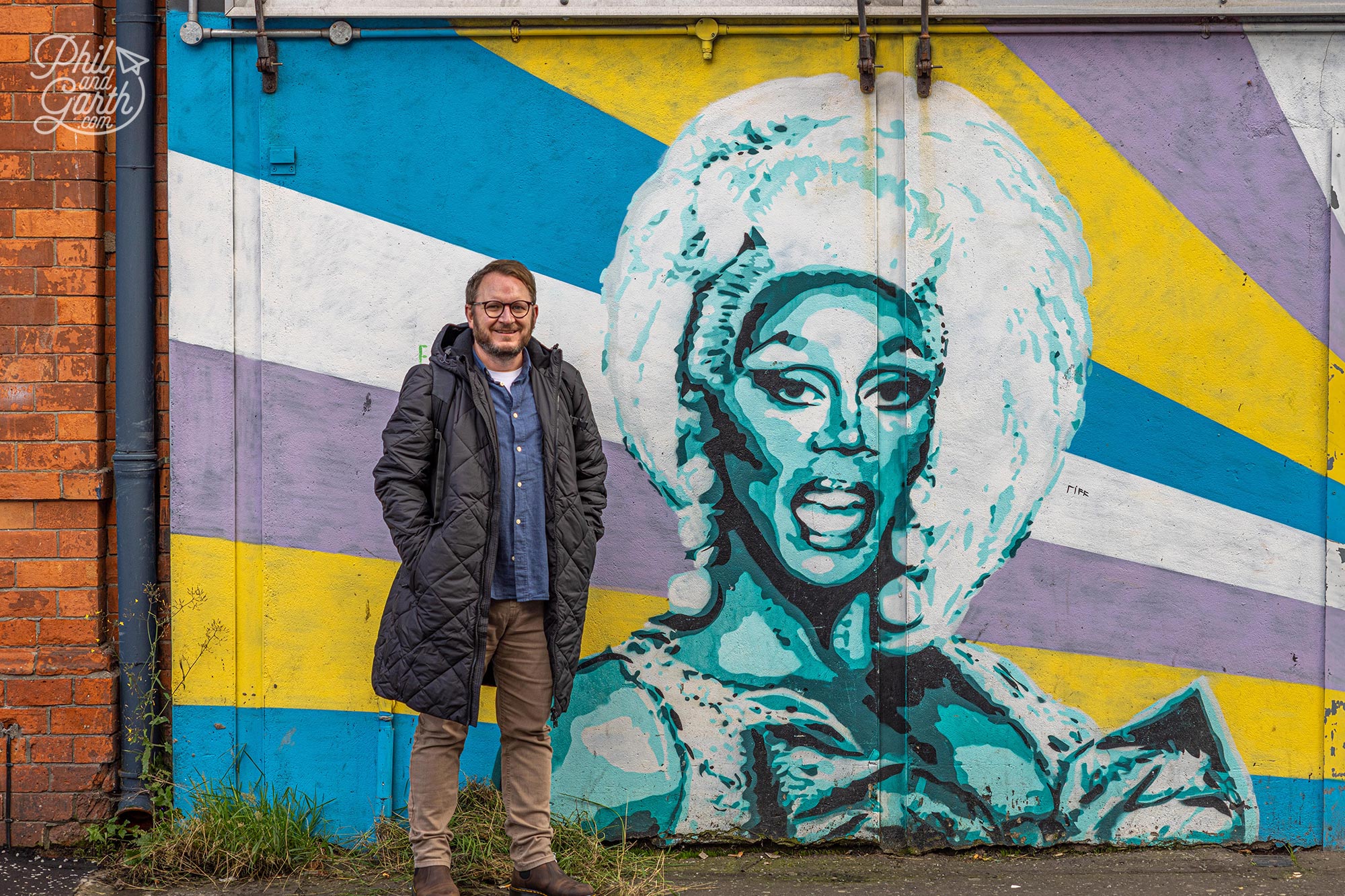
“If you can’t love yourself, how in the hell are you gonna love somebody else?”
Check out the famous Sunflower pub in this area which has been a pub for over 100 years, when it was previously called The Tavern. It still has the 1980s security cage on the front door, which has been kept as a piece of Belfast’s social history.
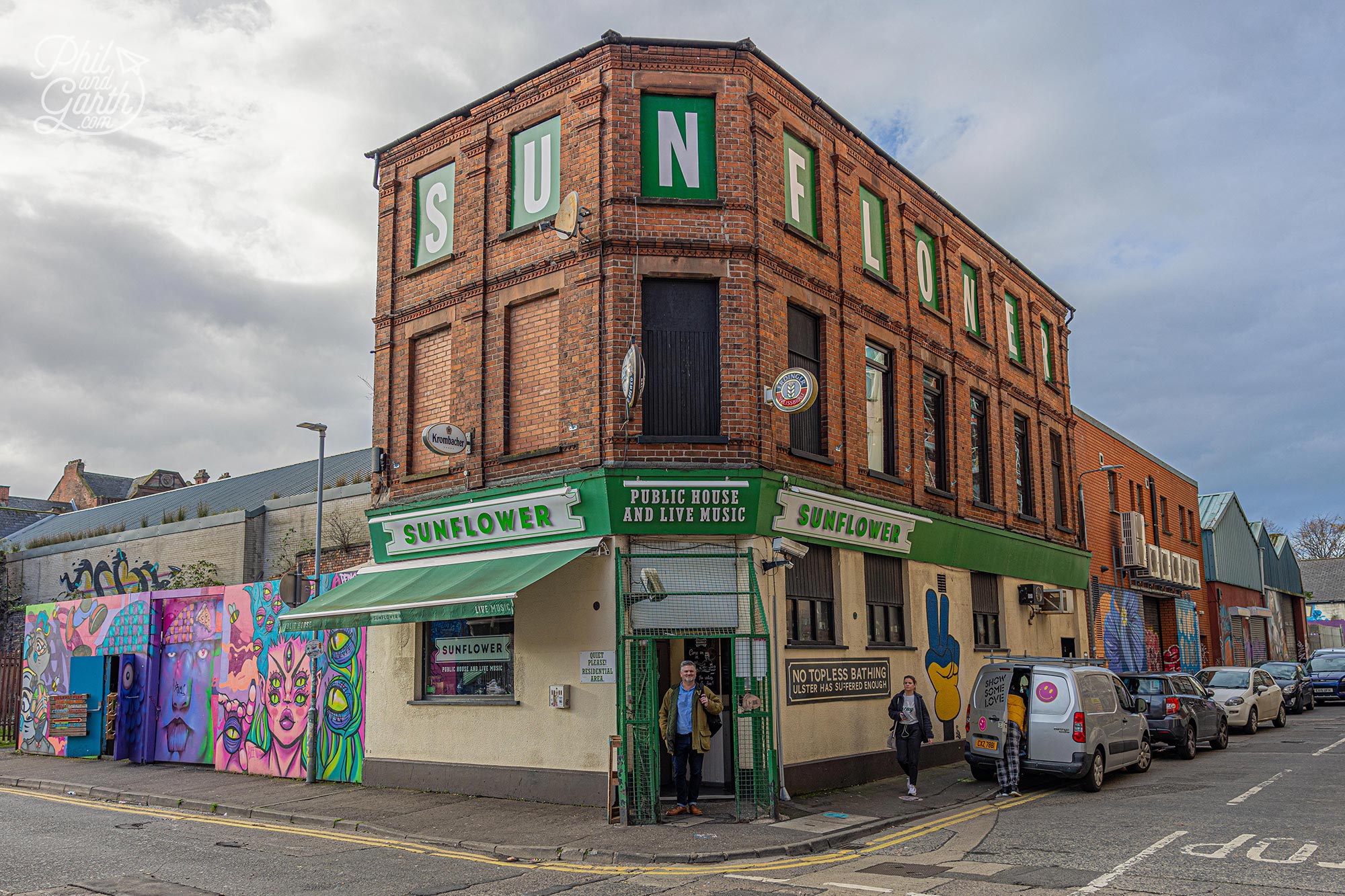
Phil stood in the security cage entrance of the Sunflower Public House
Dinner on Union Street
For dinner, we headed to the heart of Belfast’s LGBT+ community on Union Street. We ate at the Union Street Bar, set in a former shoe factory that serves up great gastro-pub grub. We loved the nice comfy vibes about the place and enjoyed the food and evening catching up with our friends James and Will.
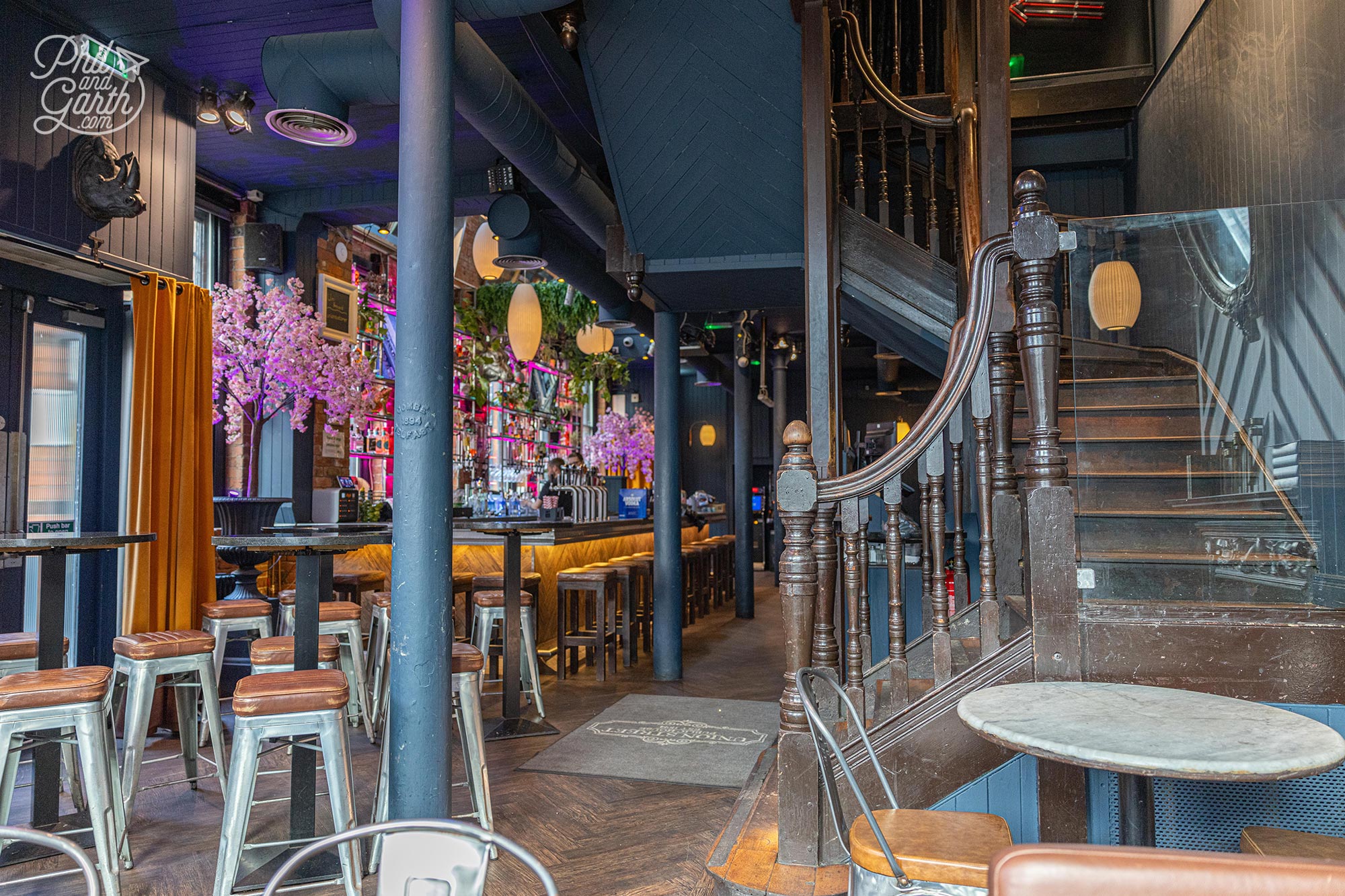
Union Street Bar & Restaurant
3 Day Belfast Itinerary Summary
Day 1
- 9.00am – Fly early into Belfast.
- 12.00pm – Lunch at The Crown Liquor Saloon.
- 2.00pm – Browse the St George Market stalls.
- 3.00pm – Experience the Titanic Belfast Museum.
- 5.00pm – Have cocktails at the Titanic Hotel Belfast.
- 6.00pm – Go to the Cathedral Quarter for drinks and eats.
Day 2
- 8.30am – Giant’s Causeway Day Trip.
- 6.00pm – Cathedral quarter for drinks and eats.
Day 3
- 10.00am – Political Mural Black Cab Tour.
- 1.00pm – Lunch.
- 2.00pm – Walk around the city centre.
- 3.00pm – Walk past Belfast City Hall.
- 4.00pm – Explore the waterfront & sculptures.
- 6.00pm – See the street art around the Cathedral Quarter.
- 7.00pm – Dinner on Union Street.
Phil and Garth’s Top 5 Belfast Tips:
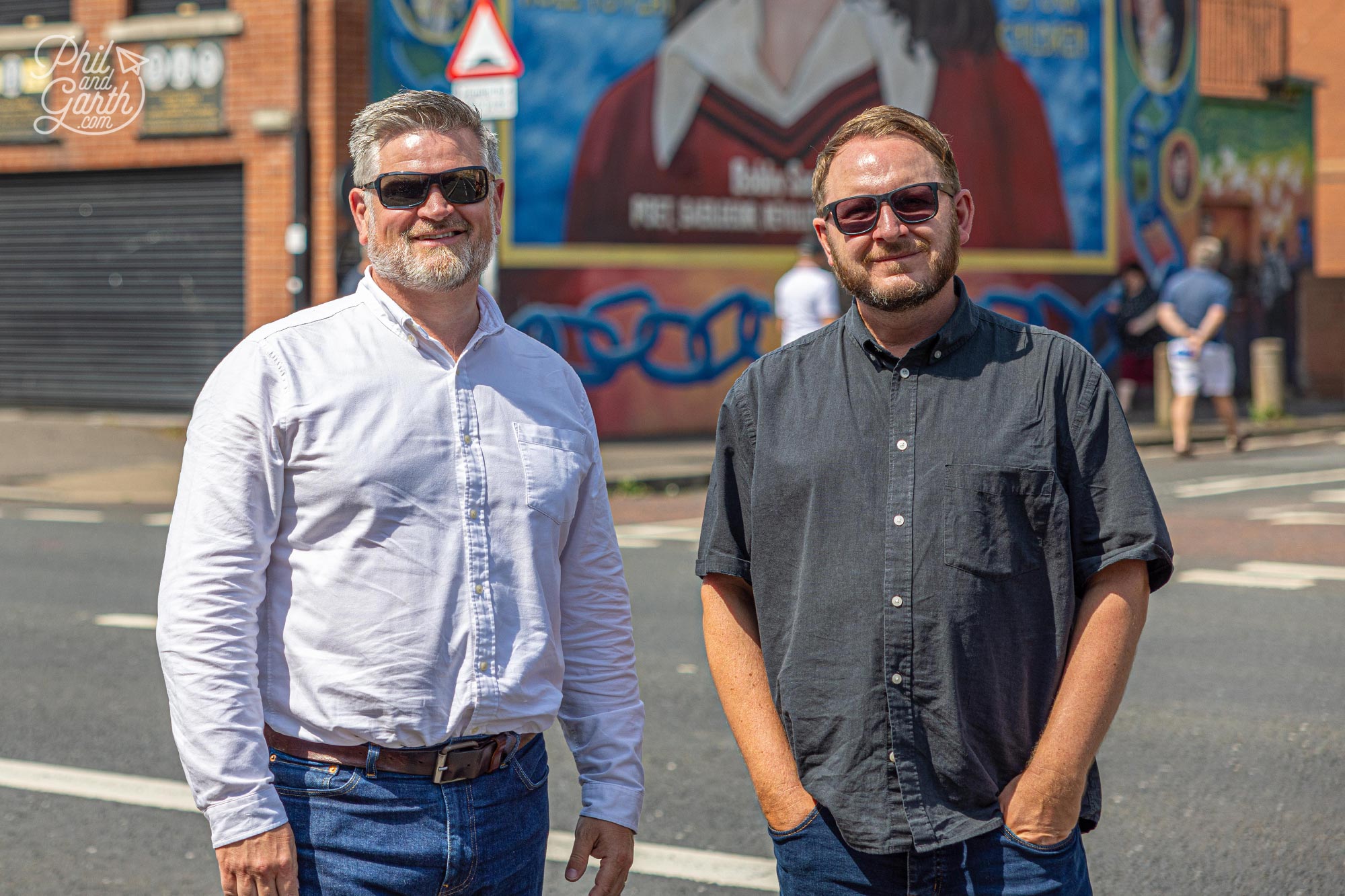
Phil and Garth’s Top 5 Belfast Tips
- Tip #1: Fly into the city airport for super quick and easy access rather than the international airport.
- Tip #2: Buy bags of Ireland’s famous Tayto crisps at the airport to take home.
- Tip #3: The Ox is one of Belfast’s two Michelin-starred restaurants.
- Tip #4: Eat an ‘Ulster fry’ for breakfast. A full English with the addition of baked soda farls and potato bread.
- Tip #5: Try to bag a seat at the front of the coach for the best views if you’re going to the Giants Causeway.
How We Did It
- We stayed at the Titanic Hotel Belfast – read our full review here.
- We booked one of the daily flights with Aer Lingus from Manchester to Belfast City Airport.
- We traveled in November, it was cold but dry.


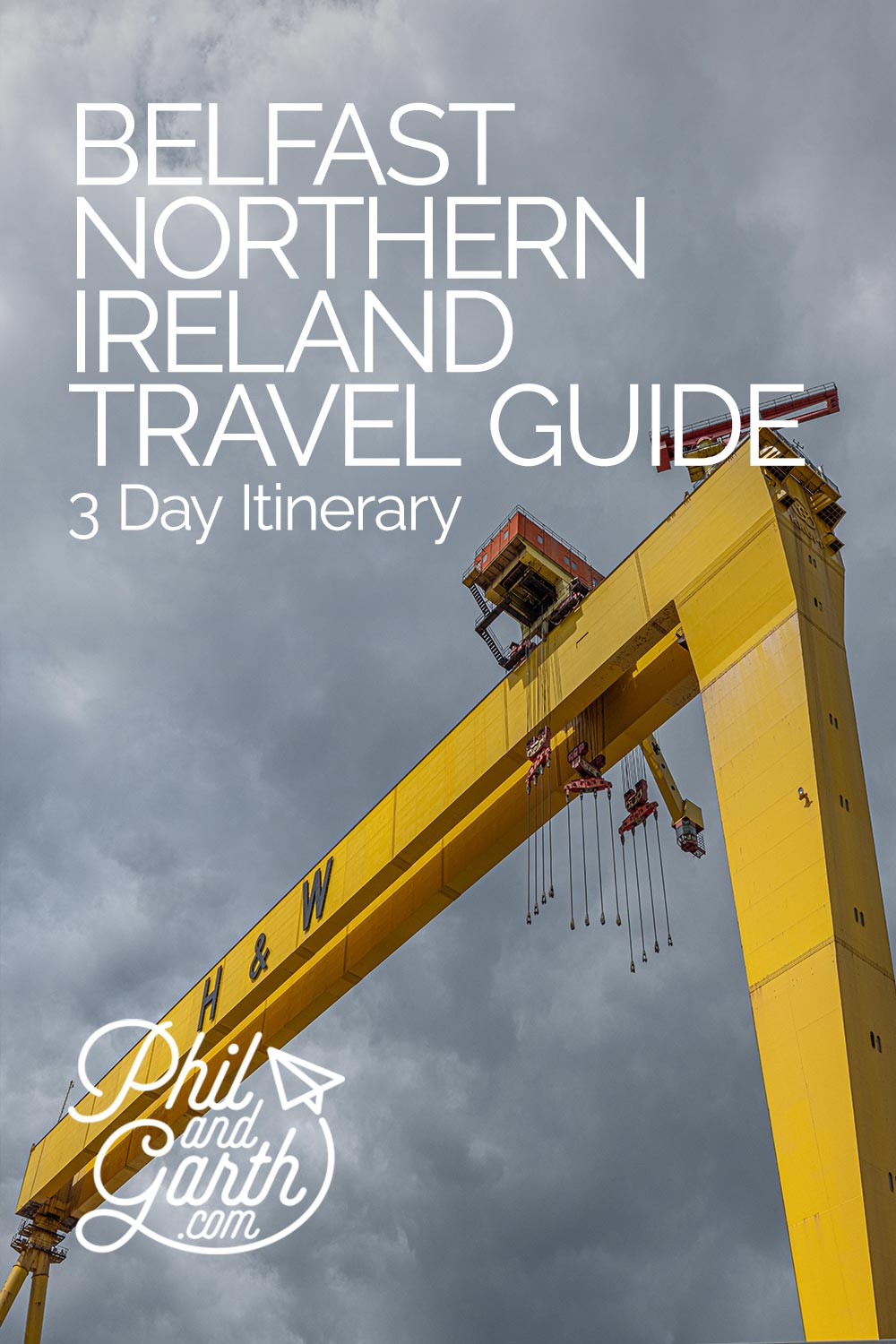
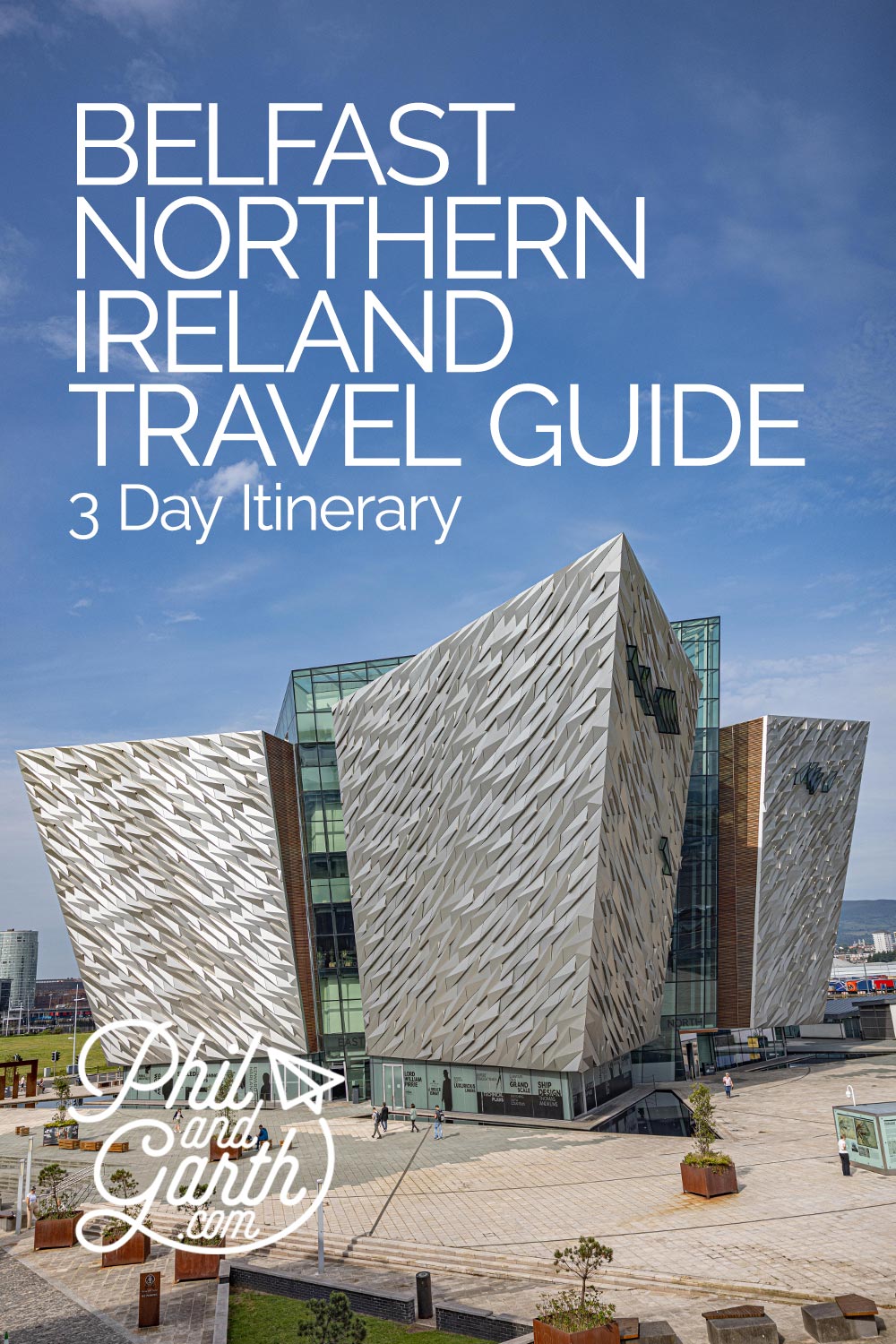
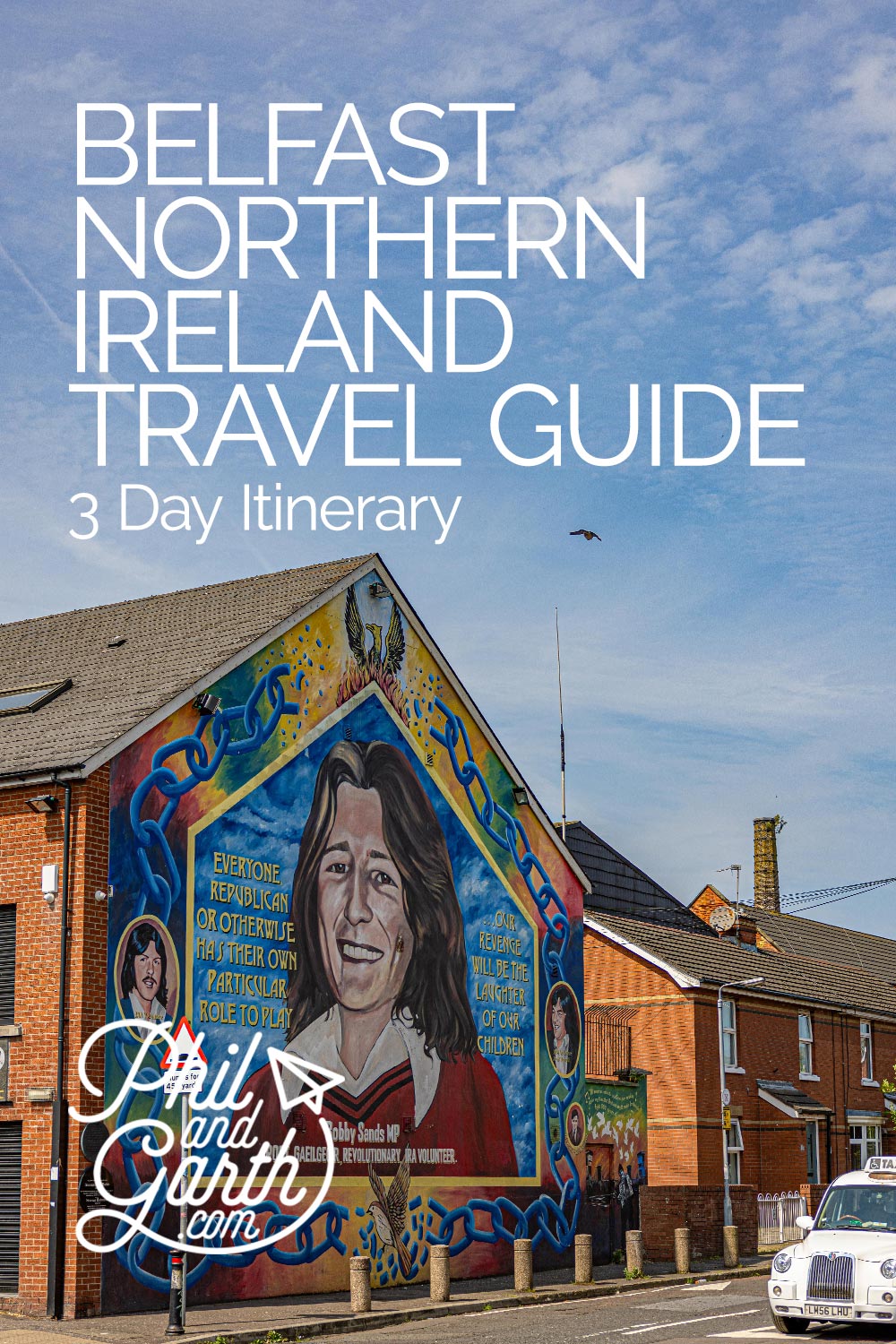
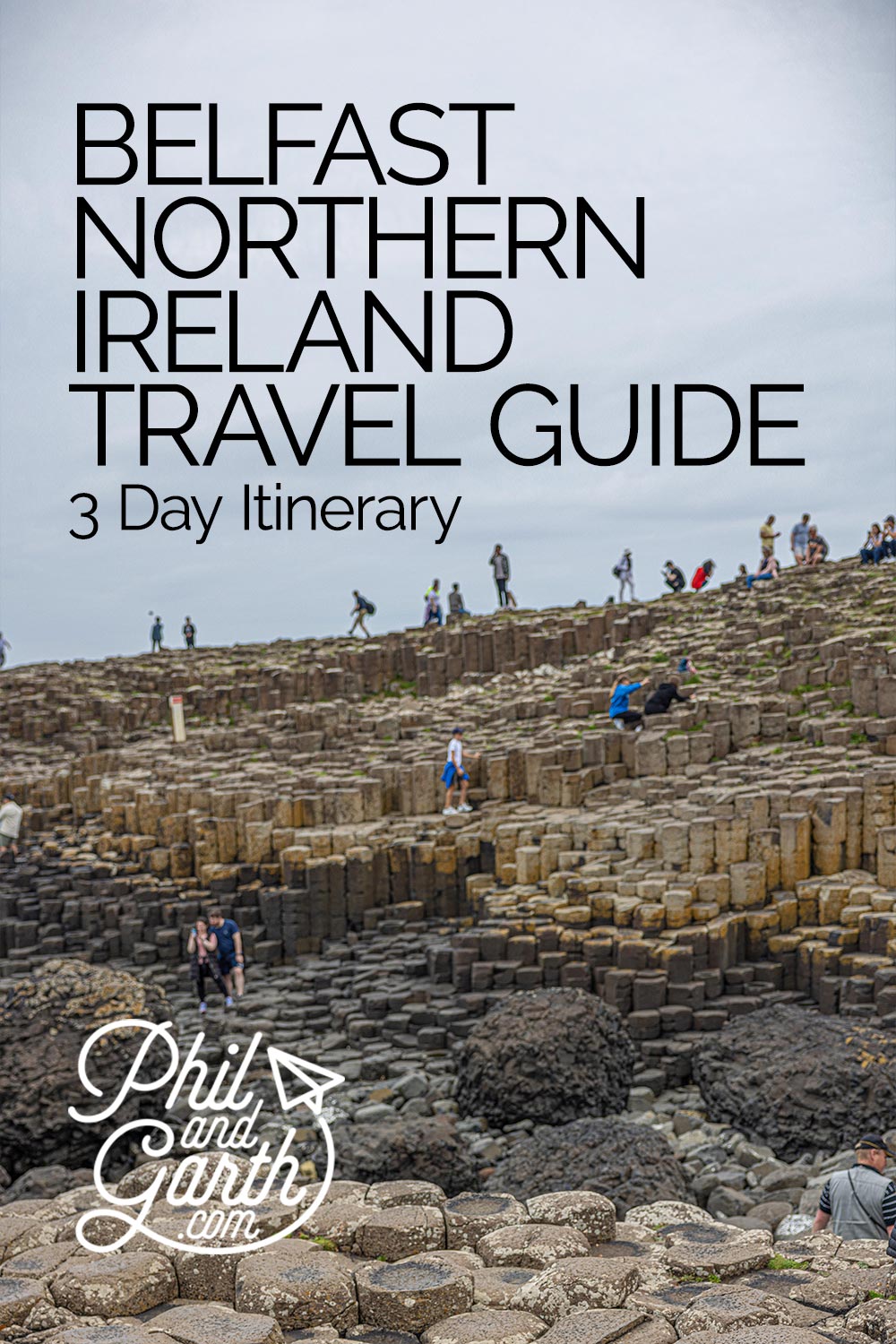
2 comments
Hi Phil and Garth
What an excellent itinerary! We are planning a weekend break to Belfast in September. My husband had a relative on the Titanic. Luigi Crovella. He was only 16 and an Assistant Waiter. We were thrilled to find your blog and will be booking the trips you reccomended. It would be rude not to at least try a few of the cocktail bars. Thank you for posting .
We were really inspired by it.
Very well written.
Thanks you for being so kind, as you can probably tell we loved the Titanic museum, and there are lots of personal stories of the people that were onboard. enjoy the cocktails!